| Ocean Chemistry and Ecosystems Division |
| Research Projects |
| Coral Health and Monitoring |
| Ecosystem Assessment and Modeling |
| Environmental Microbiology |
| Nutrient Biogeochemistry |
| Ocean Acidification |
| Ocean Carbon Cycle |
| Omics |
| OCED News |
| Current News |
| Archived News |
| Archived Research |
| Petroleum and Oil Spill Research |
| Florida Area Coastal Environment |
| Publications |
| Peer-Reviewed Publications |
| Contacts |
| OCED Staff |
| OCED Project Report |
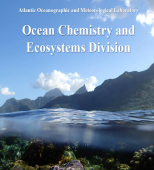 |
December 26, 2017
Field Work
● Dr. Nicole Millette, Sierra Sarkis, and Dr. Chris Kelble will be participating in a South Florida Ecosystem Restoration Research cruise aboard the R/V Walton Smith from January 8-12. This cruise will continue sampling water quality, carbon chemistry, and biological oceanographic parameters around the Florida Keys, in addition to the Marine Biodiversity Observing Network sampling at 3 sites. This will be the first cruise with grazing incubation experiments being conducted simultaneously with primary productivity.
● Ian Smith will be conducting a survey of juvenile sportfish in Florida Bay on January 3-6, 2018. This is a continuation of the study following a large cohort of juvenile spotted seatrout that were spawned during Hurricane Irma. We are working with colleagues with data on juvenile snook and red drum that show similar spawning events around Hurricane Irma.
December 18, 2017
Meetings
● Dr. Lew Gramer represented AOML and CIMAS at the European Coral Reef Symposium 2017 at Oxford University, 13-15 December. He chaired a session on research that combines modeling and other biophysical methods with molecular biology of the coral holobiont. Dr. Gramer also presented a 14-minute speed talk at ECRS on the relationship between oceanographic habitat and structure in the host genetics and microbiome of Florida reef corals - representing collaborative work with Nathan Putman, Xaymara Serrano, and the OCED marine microbiology lab including Stephanie Rosales. Reef scientists of Europe, Australia and the Pacific, the Middle East, Asia, South America (and some from North America, too!) presented talks in about 20 different sessions at the ancient university.
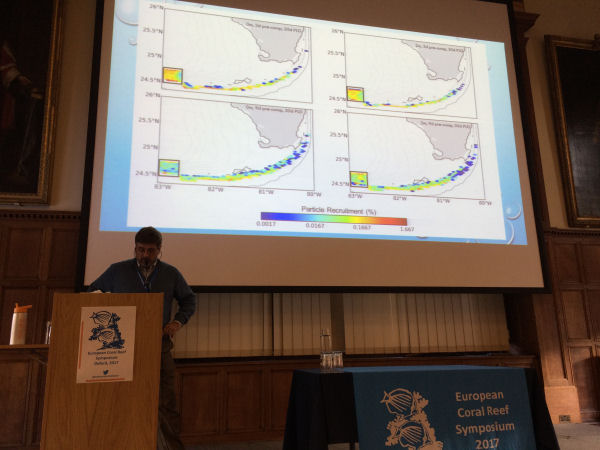 |
December 11, 2017
Field Work
● Ian Smith, Charline Quenee, and Dr. Chris Kelble will conduct an additional survey of juvenile sportfish in Florida Bay on December 9-14. These surveys typically end in November, but we have observed an unusually high pulse of juvenile seatrout this year following Hurricane Irma and will continue to track this cohort until we cease to observe it in significant numbers.
● The AOML microbiology team is sampling this week in the Florida Keys National Marine Sanctuary to collect coral tissue, sediment, and water samples for coral reef microbiome biodiversity characterization as part of the on-going FKNMS Marine Biodiversity Observing Network (MBON).
Seminar
● EBM Seminar Series: Dr. Chris Kelble will be presenting a talk on "Applying the Integrated Ecosystem Assessment process to inform EBM in the Gulf of Mexico" as part of the EBM/EBFM seminar series. This talk will be in the first floor conference room on Wed, December 13 from 3pm - 4pm. It will be transmitted to NOAA's central library in Silver Spring and available via webinar. Dr. Kelble will discuss how Integrated Ecosystem Assessments (IEA) have evolved throughout NOAA with a specific focus on the Gulf of Mexico (GOMx). IEA's were originally viewed and communicated as a product, process, framework, and tool. This led to the Gulf of Mexico team implementing the IEA to answer big questions about the holistic status of the entire Gulf of Mexico. This advanced our scientific understanding, but the connection to ecosystem management was missing. We are now tailoring the GOMx IEA implementation in conjunction with management partners to support specific management processes. This has required the team to change the geographic scale of the IEA and work jointly with our management partners when creating IEA products. Dr. Kelble will highlight how the IEA has advanced our understanding of the GOMx ecosystem and is working actively with resource management partners to improve decision-making.
● Remote access: If you are located outside of Silver Spring, MD., please register for the December EBM/EBFM seminar: https://goo.gl/AsFkcdhttps://goo.gl/AsFkcd. After registering, you will receive a confirmation email containing information about joining the webinar. Participants can use their telephone OR computer mic and speakers (VoIP).
Project Updates
● Ocean carbon group personnel have built a new total dissolved inorganic CO2 (DIC) analyzer (DICE-6). The state-of-the-art instrument is the backbone of sustained ocean carbon observations. The new instrument is needed because the delay of the NOAA ship Ronald H. Brown to execute GO-SHIP cruise in the Indian Ocean precludes getting equipment back for a coastal ocean acidification cruise.
● The closely interacting AOML and PMEL ocean carbon groups have been responsible for the reference quality measurements of DIC on the repeat hydrographic surveys since the early 1990s and currently are the only groups performing the measurements on the jointly NOAA/NSF funded US GO-SHIP cruises. The measurements are key to determine decadal changes in ocean carbon inventory and the resulting biogeochemical effects such as global ocean acidification. Over the years the groups have acquired unique expertise to lead the charge from the building and improving the exacting analytical instruments though data reduction and interpretation of global and coastal observations in support of NOAA goals.
December 4, 2017
Publications
● Dr. Ian Enochs, Graham Kolodziej, and Dr. Derek Manzello are co-authors on a manuscript accepted for publication in Coral Reefs.
Summary/Significance
● Mesophotic coral ecosystems (MCEs) are deep reefs (>30m) that may act as refuges for reef organisms owing to cooler temperatures and buffering from direct human impacts. However, MCE coral community recovery after disturbance, and thus, community resilience, are poorly understood. Coral growth rate is a key variable in resilience to disturbance, but there are limited data from MCEs. We used computerized tomography to quantify calcification in two species of coral and found that growth rates are slow in MCEs. Localized buffering from the stressors affecting shallow reefs is crucial to the long-term capacity of these sites to serve as refugia, given that growth and recovery from disturbance in MCEs will be significantly slower than on shallow reefs.
Citation
● Groves S, Holstein D, Enochs I, Kolodziej G, Manzello D, Brandt M, Smith TB (In press). Growth rates of Porites astreoides and Orbicella franksi in mesophotic habitats surrounding St. Thomas. Coral Reefs.
Seminar
● Dr. Catalina Aguilar will give the following seminar in the AOML first floor conference room on Tuesday, December 5 at 10AM: Transcriptomic analyses of the responses of corals to environmental stress. Understanding the impacts that environmental stressors have on the coral cellular mechanisms is integral for determining the status of coral health. It also has important implications for persistence of coral reefs under rapidly changing climatic conditions. In this study we implemented a transcriptomic approach to investigate the response of the coral A. millepora to biotic and abiotic challenges in an attempt to better understand the molecular mechanisms underlying specific and general coral stress responses.
Project Update
● The AOML microbiology team is conducting technology transfer activities with the PALL Corporation, specifically their GeneDisc Division, to adapt microbial source tracking (MST) assays to their simple and user-friendly Genedisc quantitative PCR instrument. One of the challenges of advancing this MST technology for wide-spread use in environmental assessment and monitoring is the current need for relatively sophisticated laboratory equipment and highly trained personnel. The AOML Microbiology Program is working with the PALL corporation to develop versions of these qPCR assays and to modify the PALL Genedisc System so that these MST assays can be provided in pre-prepared kits and run on an automated instrument that requires relatively little manual operation or operator training. To this end, PALL has installed a GeneDisc qPCR system in the AOML microbiology lab that will be used in collaborative research and technology transfer activities to jointly adapt these assays to the instrument and to perform multi-laboratory cross-validation of assay performance on this instrument platform. The ultimate goal of this technology transfer effort is to foster wider use of this microbial source tracking qPCR technology among commercial, academic, governmental, and NGO entities by making it more cost-effective and simpler to use to better enable the acquisition of environmental intelligence that can improve resource management, mitigation, and recovery.
Meetings
● Dr. Kelly Goodwin and Luke Thompson will attend the 2017 CalCOFI conference to be held Dec. 4-6. A talk describing the integration of 'omic measurements into CalCOFI will be provided by JCVI collaborator Lisa Zeigler Allen. The talk is entitled "Exploring 'Omic Technologies to Support Ecosystem Understanding and Fisheries Assessments" by L. Zeigler Allen, A. Rabines, J.P. McCrow, H. Zheng, K. Goodwin, M.L. Bohan, A.E. Allen.
● On December 13-15, 2017, Dr. Lew Gramer will present at the European Coral Reef Symposium in Oxford, U.K., on "Drivers of Reef Microbiome Community Structure". He will also co-chair the ECRS Session entitled, "Emerging techniques in reef studies: DNA-based approaches and beyond".
Outreach and Education
● Dr. Chris Kelble will serve as a panelist at an upcoming public event on sea level rise and water quality in Biscayne Bay at Vizcaya on Saturday, December 2nd. This event is part of our 2017-2018 Science Panel and Art Series put on by FIU's School of Environment, Arts and Society.
● Dr. Stephanie Rosales gave a talk last Friday on "The use of omics in marine systems" at Nova Southeastern University.
Field Work
● The AOML microbiology team is sampling this week in the Florida Keys National Marine Sanctuary to collect coral tissue, sediment, and water samples for coral reef microbiome biodiversity characterization as part of the on-going FKNMS Marine Biodiversity Observing Network (MBON).
November 27, 2017
AOML Hosts NOAA 'Omics Meeting
● AOML hosted a meeting on 'omics on November 21. This meeting was attended by AOML, PMEL, and OER scientists, NMFS chief scientist, Dr. Cisco Werner, NMFS director of science and technology, Dr. Ned Cyr, OAR Deputy Assistant Administrator for labs and Cooperative Institutes, Dr. Gary Matlock, and scientists from NOS with resource managers participating remotely. This meeting highlighted 'omics work being conducted throughout NOAA, including at AOML. AOML's presented research focused on increasing our understanding of the mechanisms responsible for coral resilience to disease, ocean acidification, and temperature and on developing empirical living marine resource models using 'omics. These presentations provided an overview of NOAA's 'omics research that was followed by a discussion of what the future of 'omics would be within NOAA. This included developing a timeline for when specific 'omics applications would be operational or ready for use in resource management decision-making. There is a goal and expectation that 'omics will be used in fisheries stock assessments within five-years and used by NOS for coral restoration decision-making starting immediately. Dr. Kelly Goodwin will be leading the development of a workshop report from this meeting.
Project Update
● On November 22 2107, Jack Stamates, Dr. Paul Jones, Dr. Maribeth Gidley and Madison Soden retrieved 28 temperature loggers that had been placed on Broward county recreational mooring buoys. This deployment was an operational test of the low cost temperature sensors developed by Dr. Natchanon Amornthammarong. The temperature sensors were placed at the top and bottom to the morning lines to measure temperature variability across the reef tract. Analysis of this data will be performed by Dr. Lew Gramer and by Andrea Gomez as part of her CREST internship at AOML.
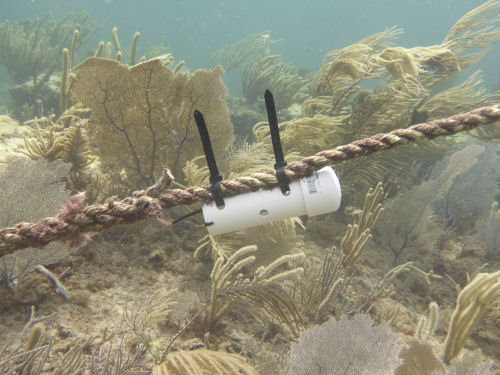 |
Meetings
● On November 28th and 29th, Jack Stamates will attend a meeting of the Southeast Florida Coral Reef Initiative-technical advisory committee. Jack will present results from a circulation study done near the St. Lucie Inlet.
Outreach and Education
● Dr. Chris Kelble will serve as a panelist at an upcoming public event on sea level rise and water quality in Biscayne Bay at Vizcaya on Saturday, December 2nd. This event is part of our 2017-2018 Science Panel and Art Series put on by FIU's School of Environment, Arts and Society.
AOML Acknowledgement in Talks and Presentations
● All OCED scientists (both FTE and CIMAS) should have a NOAA logo on all of their talks and acknowledge their work location as AOML. CIMAS researchers, it is important that when you give presentations or identify yourself that you include your AOML affiliation in addition to UM.
November 20, 2017
AOML 'Omics Meeting - November 21 in the 1st Floor Conference Room
● This meeting will highlight the AOML 'omics program with the aim of fostering linkages among projects and programs to leverage resources and help transition research to applications. Ignite talks will be used to highlight scientific progress, complemented with programmatic overviews. Ignite talks will cover 'omics activities across the fields of coral, fisheries, biodiversity, and microbial science, as well as modeling and bioinformatics. The expectation is that participants will garner a better appreciation for various mission/program mandates and learn about some of NOAA's 'omics activities across the fields of coral, fisheries, biodiversity, microbial, and computer science. The aim is to provide networking opportunities for all levels - including postdoctoral students that form the core of the (newly minted) bioinformatics user group, field scientists working to move interdisciplinary research to useful outcomes, and leadership looking for synergies that complement and enhance program success. The AOML 'omics program arises in part from a formal effort initiated in ~2013 to enhance collaborative activities between OAR & NMFS under a series of themes, including "Genomics"; providing a bridge to tri-lateral collaboration with NOS is a meeting goal.
Meetings
● On December 13-15, 2017, Dr. Lew Gramer will present at the European Coral Reef Symposium in Oxford, U.K., on "Drivers of Reef Microbiome Community Structure". He will also co-chair the ECRS Session entitled, "Emerging techniques in reef studies: DNA-based approaches and beyond".
Project Update
● On November 14, Dr. Jim Hendee, Dr. Pamela Fletcher of Florida Sea Grant, Albert Jones of the Caribbean Community Climate Change Center (Belize), and John Halas of Environmental Moorings International, met with over a dozen representatives of the Grenadian government, environmentally concerned NGOs, and academia to discuss the CREWS project, their plans for engaging with them during the project, and to discuss possible sites for the CREWS buoy installation. The next day, two candidate sites were chosen for exploration: Lower Boss Reef (12° 02.058'N, 61° 46.717' W), and Kahonee Reef (12° 01.365' N, 61° 47.459' W) the latter of which is near a St. George's University Diadema research site, Purple Rain Reef. Further discussion with the stakeholders will reveal which is the best site before installation of the station in 2018.
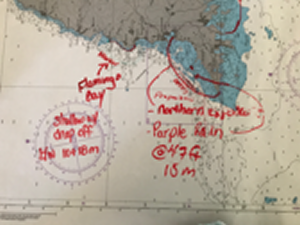 |
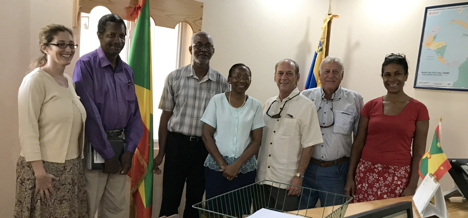 |
November 13, 2017
Meetings
● Dr. Rik Wanninkhof will be presenting an overview on standard operating procedures (SOP) for surface water CO2 observations at JCOMMOCG and IODE workshop on "Evolving and Sustaining Ocean Best Practices" in Paris, November 15. During the same trip, he will participate in the second Scientific Advisory Board (SAB) meeting of the Integrated Carbon Observing System (ICOS), part of the European Research Infrastructure Consortia (ERIC), which will be held at the Belgian Federal Science Policy Office Brussels, on November 16-17, 2017.
● Dr. Chris Kelble will be hosting a meeting Tuesday morning at 9AM in the second Floor Conference Room with other researchers to discuss the impact of Hurricane Irma on coastal water quality in South Florida.
● Dr. Chris Kelble will be hosting a meeting on Friday to discuss the evaluation of hydrodynamic model results in Biscayne Bay.
● On December 13-15, 2017, Dr. Lew Gramer will present at the European Coral Reef Symposium in Oxford, U.K., on "Drivers of Reef Microbiome Community Structure: ". He will also co-chair the ECRS Session entitled, "Emerging techniques in reef studies: DNA-based approaches and beyond".
Project Updates
● Dr. Kelly Goodwin joined Dr. Craig McLean (OAR AA & NOAA Acting Chief Scientist) and Knauss Fellow Molly Semones for two fascinating 'omic discussions. Meetings with Rob Knight (UCSD, Center for Microbiome Innovation) and with Craig Venter (J. Craig Venter Institute) were arranged for Dr. McLean during his visit to San Diego for Blue Tech week.
● During the months of November and December, Dr. Xaymara Serrano has been/will be working in the molecular laboratory of Dr. Nikki Traylor-Knowles at RSMAS with samples collected from field disease assays conducted in the summer in the Florida Keys. Dr. Serrano is performing RNA extractions and preparing cDNA libraries for future sequencing, with the overall goal of using these techniques to asssess the genomic basis of disease resistance in two critically important Caribbean corals (Acropora palmata and A. cervicornis).
Thesis Defense
● Philip Bellamy will be defending his M.S. Thesis, "A GIS tool for determining the potential runoff coefficient and runoff depth for the Indian River Lagoon, FL," at Bethune Cookman University on Thursday, November 16. Philip is currently completing his 12-week NOAA Experiential Research & Training Opportunities (NERTO) within OCED working on using GIS techniques to beeter understand land-based nutrient sources in the Coral Gables waterway.
Outreach and Education
● Dr. Nicole Millette and Dr. Chris Kelble will be briefing the Biscayne Bay Regional Restoration Coordination Team on Wednesday, November 15. They will be updating the team on their efforts associated with the Biscayne Bay Habitat Focus Area. Dr. Millette will be discussing long-term trends in water quality throughout Biscayne Bay and Dr. Kelble will be presenting preliminary results from our intensive study of the Coral Gables waterway.
● Dr. Chris Kelble will serve as a panelist at an upcoming public event on sea level rise and water quality in Biscayne Bay at Vizcaya on Saturday, December 2. This event is part of our 2017-2018 Science Panel and Art Series put on by FIU's School of Environment, Arts and Society.
NOAA Miami Health Fair
On Friday, Nov. 17th from 10-2PM, AOML will host the NOAA Miami Health Fair in the AOML Lobby and 1st floor conference room.
November 6, 2017
Farewell
Lindsey Visser has left OCED to take a position as supervisory chemist with Broward County. Lindsey lead the field and laboratory activities for the Ecosystem Assessment team for the past 5-years. Her last day at AOML was Thursday, November 5. We wish Lindsey the best of luck in her new position.
Manuscripts
● Dr. Luke Thompson gave a presentation and Dr. Kelly Goodwin attended the Earth Microbiome Project Mini-symposium held at UC San Diego on November 1. The symposium coincided with the on-line release of the publication "A communal catalogue reveals Earth's multiscale microbial diversity" in Nature, by Luke R. Thompson, Jon G. Sanders, Daniel McDonald, Amnon Amir, Joshua Ladau, Kenneth J. Locey, Robert J. Prill, Anupriya Tripathi, Sean M. Gibbons, Gail Ackermann , Jose A. Navas-Molina, Stefan Janssen, Evguenia Kopylova, Yoshiki Vazquez-Baeza, Antonio Gonzalez, James T. Morton, Siavash Mirarab, Zhenjiang Zech Xu, Lingjing Jiang, Mohamed F. Haroon, Jad Kanbar, Qiyun Zhu, Se Jin Song, Tomasz Kosciolek, Nicholas A. Bokulich, Joshua Lefler, Colin J. Brislawn, Gregory Humphrey, Sarah M. Owens, Jarrad Hampton-Marcell, Donna Berg-Lyons, Valerie McKenzie, Noah Fierer, Jed A. Fuhrman, Aaron Clauset, Rick L. Stevens, Ashley Shade, Katherine S. Pollard, Kelly D. Goodwin, Janet K. Jansson, Jack A. Gilbert, Rob Knight and The Earth Microbiome Project Consortium.
● Dr. Jia-Zhong Zhang authored a paper entitled "An estimate of diapycnal nutrient fluxes to the euphotic zone in the Florida Straits" that has been accepted for publication in Scientific Reports. Co-authors on the paper are Charlies Fischer (OCED), Molly Baringer (OD), and Jay Hooper (PhOD). The paper estimates nutrient fluxes in coastal waters of the Florida Straits using nutrient profiles and published diffusivity. The estimated fluxes are 100 times higher in the coastal areas than the central are of the Florida Straits.
Fieldwork
● Ian Smith, Dylan Sinnickson, and Dr. Chris Kelble conducted a follow-up survey of juvenile sportfish in Florida Bay on November 10-14. During the October survey they collected a record number of small juvenile spotted seatrout that likely spawned either shortly before or after the passage of Hurricane Irma. This follow-up survey will aim to observe if that high population of juveniles has survived.
Meetings
● Dr. Derek Manzello was an invited participant at a workshop entitled "Biogeographic contrast of coral reef community resilience and response to Ocean Acidification (OA) in Mo'orea, French Polynesia, and the Eastern Tropical Pacific (Galapagos, Panama)" from Nov 10-13, 2017 on Catalina Island, CA. The meeting took place at the USC Wrigley Boone Center and was hosted by Dr. Peter Edmunds of Cal-State Northridge and Dr. Peggy Fong of UCLA. The goals are to bring together the key researchers of NSF's long-term monitoring efforts in French Polynesia and the eastern tropical Pacific to align efforts for OA ecosystem response monitoring. This will be a cross-fertilization of the NOAA OA eco-response monitoring as part of the National Coral Reef Monitoring Program with NSF's efforts.
Project Updates
● Graham Kolodziej, Nathan Formel, and Dr. Ian Enochs conducted research in the Florida Keys, deploying instruments and collecting bioeroding sponges for an upcoming experiment in the Experimental Reef Lab.
● Philip Bellamy ran the first trial of ordinary least squares tests on the water quality parameters for the Coral Gables Waterway. He is in the process of applying the correct transformations to produce a normally distributed dataset for reliable results.
Outreach and Education
● The Angari Foundation filmed John Morris scanning coral cores in the AOML CT scanning facility. The footage will be part of a virtual reality documentary and teaching tool on ACCRETE research.
December 19, 2016
Field Work
● Charlie Fischer and Bob Castle continue onboard R/V Ron Brown running nutrient and DIC analyses as part of the P-18 cruise.
● Graham Kolodziej, Lauren Valentino, Mike Jankulak, and Derek Manzello of OCED and NOAA Corps officers Marc Weekley and Ben VanDine swapped out subsurface temperature recorders (STRS), light sensors, and pH probes from Key West to Key Largo. The STRs were originally deployed in December 2013 as part of the National Coral Reef Monitoring Program. The pH and light sensors were deployed as part of the Coral Reef Conservation Program's project entitled: Elucidating the recipe of coral reef resilience in the Florida Keys. On Friday, CTD data was locally downloaded from the MApCO2 buoy at Cheeca Rocks.
December 12, 2016
Proposals
● The Microbiome Interagency Working Group (MIWG), charted by the National Science and Technology Council, met its deadline to complete a draft of the National Microbiome Initiative Federal Strategic Plan for Microbiome Research. Dr. Kelly Goodwin is on the writing team for the MIWG.
Field Work
● Charlie Fischer and Bob Castle continue onboard R/V Ron Brown running nutrient and DIC analyses as part of the P-18 cruise.
Meetings
● A contingent from the Caribbean Community Climate Change Center, consisting of Dr. Kenrick Leslie, Albert Jones, and Joe McGann, met with Roxie Allison-Holman of NOAA General Counsel, Pamela Fletcher of Sea Grant/AOML, and Jim Hendee, to discuss points of agreement to be codified in a Memorandum of Understanding in the installation of four new CREWS stations in the Eastern Caribbean.
October 30, 2017
Welcome Aboard
Madison Soden started with OCED through CIMAS. Lew Gramer will be mentoring Madison, who is working on a Master's Degree (double) in Physics and Mathematics. Madison will be working to incorporate and improve the use of AI tools for coral ecology. OCED's interest and adoption of artificial intelligence (A.I.) tools began in the mid-90s with Jim Hendee's expert system implementation of the CREWS software which utilized (back then) the CLIPS programming language developed by NASA for the space station. This tool was then greatly enhanced through the programming efforts of Mike Jankulak and Lew Gramer, utilizing a commercial expert system shell called G2 (funded by HPCC), which was at the time used by many of the Fortune 500 companies, as well as the NSA, the CIA and the FBI. Unfortunately, that software has become too expensive and time-consuming to update and maintain, so we are transitioning to two candidate approaches that utilize the Python programming language, i.e., PyKE (i.e., Python for Knowledge Engines), and PyKnow. Madison is very keenly interested in developing this new approach to using artificial intelligence and will help with the transition of our current expert systems to the new programming language.
Manuscripts
● OCED's Dr. Xaymara Serrano is the lead author in a manuscript accepted for publication in the journal Coral Reefs. This paper investigated the performance of coral larvae from two important Caribbean species with contrasting reproductive and algal transmission modes (Orbicella faveolata and Porites astreoides), under increased temperature and/or elevated dissolved inorganic nitrogen (DIN). The authors used a fluorescence-based respirometer to measure the oxygen consumption of coral larvae from both species, and also assessed the effects of these stressors on P. astreoides larval settlement and mortality. Findings suggest that the effects of thermal stress and nitrate enrichment in coral larvae may be species-specific and are neither additive nor synergistic for the species studied. Together, these findings may have important consequences for the recruitment and community reassembly of corals to nutrient-polluted reefs that have been impacted by climate change
Manuscript Citation
● Xaymara M. Serrano>, Margaret W. Miller, James C. Hendee, Brittany A. Jensen, Justine Z. Gapayao, Christina Pasparakis, Martin Grosell, and Andrew C. Baker. Effects of thermal stress and nitrate enrichment on the larval performance of two Caribbean reef corals. Coral Reefs. Accepted.
Meetings
● Dr. Chris Kelble and Dr. Neda Trifonova attended the Putting Ocean Tipping Points into Practice workshop at the National Center for Ecological Analysis and Synthesis (NCEAS) in Santa Barabara, CA on November 1-3. Chris and Neda were part of a successful application with colleagues in the Office of Restoration and the Center for Coastal Monitoring and Assessment that aims to use socio-ecological indicators to look for tipping points that may have occurred in response to tropical cyclones and the Deepwater Horizon Oil Spill.
● Dr. Kelly Goodwin traveled to Washington DC on November 8-10 to participate in the National Microbiome Data Collaborative Colloquium.
Diversity, Inclusion and You: Coping with Natural Diasters Affinity Group
● Andrea Gomez, a NOAA-CREST Student Intern, finished her internship and departed AOML on October 27.
Project Updates
● Stephanie Rosales is starting to work on some artificial neural network-based data analysis in R and Python. She is developing her capabilities on our new powerful bioinformatics server (also funded by HPCC) and will use these tools to support our Omics program (as well as others). One of the methods Stephanie is experimenting with is the self-organizing map (SOM) or "Kohonen map". There are a number of implementations of SOMs in Python, some of which Lew has experimented with.
● Continuing on with the A.I. theme, Dr. Natchanon Amornthammarong is also utilizing Python programming and investigating the use of the A.I. approach in analyzing our sea temperature sensor data, as well as for use in analyzing data that may arise in a future project from surface mounted sensors in real time.
Internal Review of Publications
● Please remember that all manuscripts and presentations at scientific conferences must undergo an internal review. There are forms that must be completed to keep a record to indicate that the internal review was successfully completed for both manuscripts and talks. AOML also now has an official internal review procedures. All of these documents and procedures can be found in our OCED forms and documents folder on the google drive (https://drive.google.com/drive/folders/0B4-XrZ8DMx4HODhvckdsRm1ZaHc?usp=sharing'> https://drive.google.com/drive/folders/0B4-XrZ8DMx4HODhvckdsRm1ZaHc?usp=sharing). If you need something to be reviewed, please contact Dr. Jim Hendee or Dr. Chris Kelble to help coordinate the internal review.
October 23, 2017
Manuscripts
● Dr. Nicole Millette authored a paper entitled "Shift in baseline chlorophyll a concentrations following a three-year Synechococcus bloom in southeastern Florida" that was accepted for publication in the Bulletin of Marine Science. Dr. Chris Kelble and Lindsey Visser are co-authors on the paper. Between 2005 and 2008 an unprecedented bloom of Synechococcus occurred in Barnes Sound, Manatee Bay, and lackwater Sound of southern Biscayne Bay. During the bloom, nutrient concentrations were elevated and massive seagrass mortality was reported. However, following the collapse of the bloom, there was minimal follow-up research to assess the status of the impacted region. By comparing water quality monitoring data collected ten years before and five years after the bloom, we identified a baseline shift in chlorophyll a concentrations that we confirmed was the result of the three-year bloom. More importantly, we could not find any other baseline shifts in water quality, specifically nutrients, that were caused by the bloom. As a result, we hypothesize that higher baseline chlorophyll a concentrations are the result of a reduced benthic (seagrass and sponge) community. This would mean that the Synechococcus bloom caused the affected region to shift towards a more pelagic production dominated community compared to benthic production and is at greater risk for future blooms. This manuscript was a result of collaboration between the AOML/NGI program and the Biscayne Bay Habitat Focus Area.
Manuscript Citation
● Millette, NC, Kelble C, Linhoss A, Ashby S, and Visser L. Shift in baseline chlorophyll a concentrations following a three-year Synechococcus bloom in southeastern Florida. Bulletin of Marine Science.
Field Work
● Jack Stamates, Andrea Gomez, and Dr. Paul Jones will swap the temperature sensors located on the Broward County recreational mooring buoys on October 25. Thirty of these sensors were placed at the top and bottom of buoy mooring lines in August 2017, as a test of the low-cost temperature sensors developed at AOML by Dr. Natchanon Amornthammarong. The Broward County recreational mooring buoys have provided a platform of opportunity for deploying these temperatures sensors across a portion of the Broward reef tract. Data from the sensors will provide a high temporal density set of near surface and near bottom temperature measurements in this section of the reef tract. The data will be used to examine the small-scale variability across the reef tract, the effects of severe meteorological events on reef temperature, and to compare with space born oceanographic measurements.
Meetings
● Dr. Chris Kelble and Dr. Neda Trifonova will be attending the Putting Ocean Tipping Points into Practice workshop at the National Center for Ecological Analysis and Synthesis (NCEAS) in Santa Barabara, CA on November 1-3. Chris and Neda were part of a successful application with colleagues in the Office of Restoration and the Center for Coastal Monitoring and Assessment that aims to use socio-ecological indicators to look for tipping points that may have occurred in response to tropical cyclones and the Deepwater Horizon Oil Spill.
Outreach and Education
● Dr. Nicole Millette and Dr. Chris Kelble were featured in an article in the Miami Herald on Sunday that discussed the current and potential impacts of Hurricane Irma on the Biscayne Bay. The Biscayne Bay is a NOAA habitat focus area that AOML co-leads with SEFSC (http://www.miamiherald.com/news/local/environment/article180281956.html).
Recent Announcements
● Dr. Jim Hendee of AOML, Albert Jones of Caribbean Community Climate Change Center, John Halas of Environmental Moorings, Int., and Dr. Pamela Fletcher of Sea Grant/AOML met with local stakeholders in St. Kitts to determine the best location for a Coral Reef Early Warning System (CREWS) station in St. Kitts or Nevis. Four sites were identified in subsequent site surveys for the installation of the CREWS station in 2018.
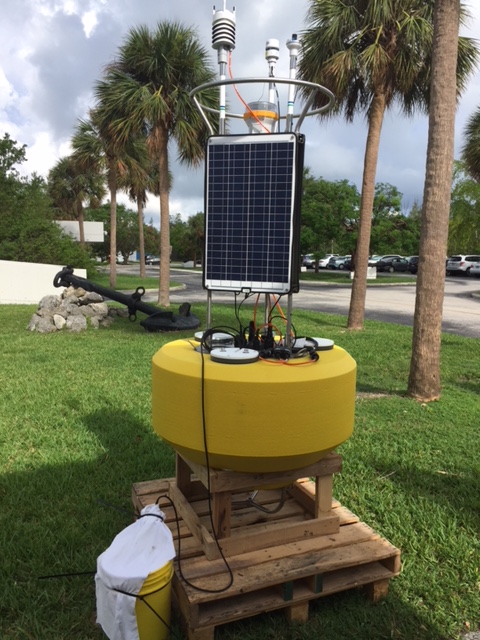 |
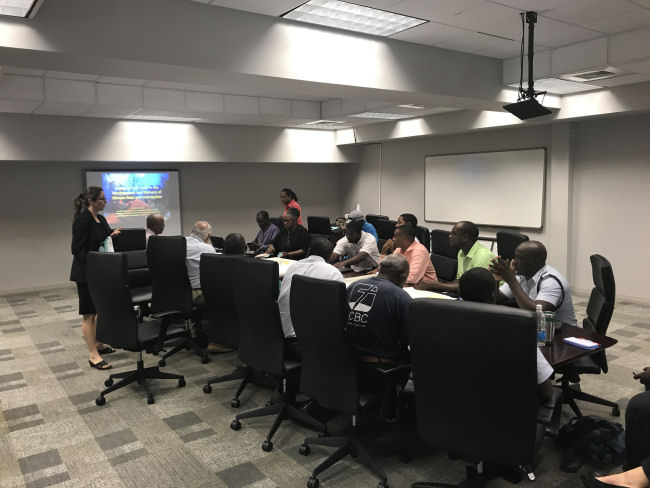 |
October 16, 2017
Hurricane Irma Assessment
OCED has completed several cruises to assess the impact of Hurricane Irma on south Florida's coastal ecosystems. We had hypothesized that we might observe hypoxia (low dissolved oxygen) in many areas, especially near the Everglades, due to an increase in organic matter loading to the coastal ecosystem. However, we found dissolved oxygen levels to be normal throughout the west Florida shelf. Salinities were lower in this area and there was a diatom bloom, but this is expected and not unprecedented when there is a high quantity of runoff from the Everglades. Florida Bay appears to be experiencing a phytoplankton bloom and is still turbid, but we found high densities of juvenile sportfish, likely because the lower salinities were physiological better for many species. Biscayne Bay has one area near Black Point with hypoxic conditions and throughout Biscayne Bay there were elevated chlorophyll a levels near the concentrations during the 2013 bloom. The lack of sever negative impacts to the coastal ecosystem from Hurricane Irma is expected. Coastal ecosystems in the southeast and Gulf of Mexico have evolved with tropical cyclones regularly impacting them. Thus, while we, humans, often expect intense tropical cyclones to have severe negative impacts on the ecology of coastal ecosystems, that is not usually the case. Instead, tropical cyclones tend to have a much more pronounced impact on humans and the built environment than they do on the coastal marine ecology.
Field Work
● Dr. Jim Hendee will conduct a site survey in St. Lucia on October 16-20. The survey will include meeting with local stakeholders to help identify the future location of the Coral Reef Early Warning System (CREWS) buoy to be deployed in St. Lucia.
Outreach and Education
● Dr. Ruben Van Hooidonk did a read interview (taped) for BBC World with journalist Sam Judah about the future prospects of coral reefs under climate change. We do not know when it will air, but we'll keep you updated.
New OCED Research Vessel
● Joe Bishop went to Dusky to check on progress of the new research vessel in production. The new vessel is out of the mold and being prepped for the cabin and the deck.
Meetings
● Dr. Xaymara Serrano will be traveling to Salt Lake City, Utah, to participate in the 2017 SACNAS National Conference to be held from October 18-21. SACNAS is organized by the Society for Advancement of Chicanos/Hispanics and Native Americans in Science and it is the largest diversity in STEM conference in the country, with over 4,000 attendees each year. Xaymara will represent AOML's Diversity Inclusion and You (DIY) committee and will serve as panelist in two different events; a student mentoring panel and a professional development session. Both are intended to increase and promote diversity of underrepresented minorities in science careers.
Diversity, Inclusion and You: Coping with Natural Diasters Affinity Group
● AOML's Diversity Inclusion and You (DYI) committee is forming its first affinity group for people who have been impacted by recent natural disasters (Harvey, Irma, Maria, earthquake in Mexico) or who have friends/families that have been impacted. A goal of the group will be to share resources and/or useful information which may help those affected, especially in hard-to-reach areas in the US/Caribbean. For anybody interested in joining this group, the point contact person is Dr. Xaymara Serrano from OCED (xaymara.serrano@noaa.gov). Once a group is formed a first meeting will be announced. In addition, if anybody is interested in setting up another affinity group or wish to join AOML's DIY, contact aoml.diversity@noaa.gov or any current member (Dr. Xaymara Serrano, Erica Rule, Dr. George Halliwell, Dr. Lew Gramer, Howie Friedman, Dr. Sean Casey, and Dr. Sim Aberson).
October 9, 2017
Publications
● Dr. Ruben Van Hooidonk is an author and co-author on two newly released UN reports. Ruben authored a report that details projections
of coral bleaching conditions at a 4-km resolution per country based on his priori publication van Hooidonk RJ, Maynard J, Tamelander J et al.
(2016). Local-scale projections of coral reef futures and implications of the Paris Agreement. Nature Publishing Group, 1–8.
(
http://www.unep.org/asiapacific/sites/unep.org.asiapacific/files/CoralBleaching.pdf)
● Dr. Ruben co-authored a second report that is a guide for the individuals in charge of commissioning, planning, leading or coordinating
a resilience assessment. The Guide also provides a resource for 'reef managers' of all kinds, including decision-makers, environmental planners and
managers in coral reef areas, with influence over pressures affecting coral reefs.
(
http://www.unep.org/asiapacific/sites/unep.org.asiapacific/files/AGuide-Coral%20Reef2017.pdf)
Recent Announcements
● Dr. Chris Kelble and Dr. Neda Trifonova along with colleagues submitted a successful application to participate in "Putting Tipping Points Science into Practice Workshop" at the National Center for Ecological Analysis and Synthesis (NCEAS). Their project entitled "Ocean Tipping Points to Improve Gulf of Mexico Restoration and Management" will integrate biophysical scientists, social scientists, and restoration managers in the Gulf of Mexico to determine if tipping points have been surpassed or are being approached and how mangers should use tipping points theory to improve the sustainability of Gulf of Mexico resources.
Field Work
OCED has been and will continue to conduct a number of cruises to assess the impact of Hurricane Irma on south Florida's coastal ecosystems. We have developed a website (/ocd/ocdweb/irmaresearch/) to help AOML and our partners keep updated on and disseminate findings from the various field activities:
● NOAA/AOML, NOAA/NESDIS, USF, and University of Miami will conduct a survey of south Florida's coastal waters on October 9-13, 2017 aboard the R/V Walton Smith. These cruises have been investigating coastal water quality in south Florida every other month since the late 1990s. This cruise is being enhanced and modified to better capture the response of south Florida coastal water quality to Hurricane Irma's passage on September 10-11, 2017. The main objectives of this cruise are to 1) Quantify the impact of Hurricane Irma on coastal water quality along the Florida Keys and southwest Florida shelf, and 2) Calibrate satellite measurements to be post-processed to provide a time-series of Hurricane Irma impacts on south Florida coastal waters. Parameters to be collected at each station or measured underway include Dissolved Inorganic Nutrients, Chlorophyll a, Dissolved Oxygen, Dissolved Inorganic Carbon, and fCO2. At select stations, we will collect samples to measure environmental DNA and Primary Productivity. We will be posting updates from the cruise as internet on board and timing allow.
● We have conducted three surveys of the Coral Gables waterway on September 23, 28 and October 5. The initial results from this survey are shown below. This will allow us to determine how Hurricane Irma affected the delivery of land-based nutrients to Biscayne Bay.
● We are in the process of conducting a survey of juvenile sportfish in Florida Bay to quantify the effect of Hurricane Irma on seagrasses and juvenile sportfish in our study site. This will help determine how juvenile fish responded to the Hurricane's passage.
● We will conduct a survey of water quality in Biscayne Bay, a NOAA Habitat Focus Area, on October 11. This will determine the effect of Hurricane Irma on water quality throughout Biscayne Bay.
● Jim Hendee will conduct a site survey in St. Lucia on October 16-20. The survey will include meeting with local stakeholders to help identify the future location of the Coral Reef Early Warning System (CREWS) buoy to be deployed in St. Lucia
Advanced Manufacturing Lab
Dr. Ian Enochs, Dr. Paul Jones, and Nate Formel finished construction of AOML's new Advanced Manufacturing Lab. The new facility expands AOML's capabilities in 3D printing, laser cutting and CNC, as well as printed circuit board production.
Impact of Hurricane Irma on Coral Gables Waterway Water Quality Initial Results
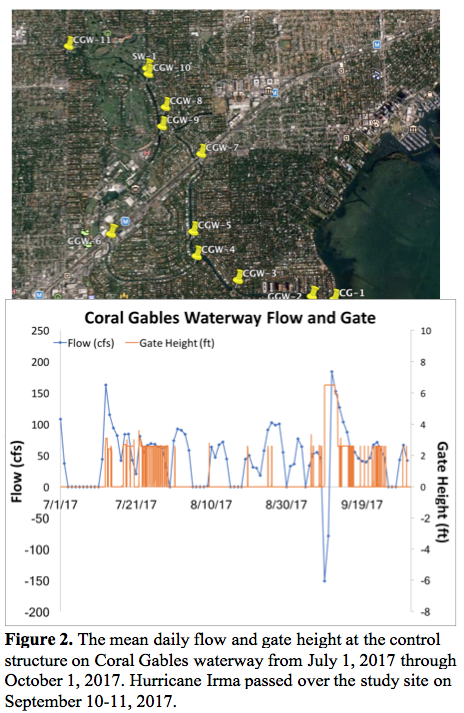
As part of the Biscayne Bay Habitat Focus area effort, AOML has been conducting monthly water quality sampling within the Coral Gables Waterway (Fig. 1). This sampling represents a collaborative partnership with AOML, SEFSC, and University of Massachusetts-Dartmouth. We sample 11 stations from the control structure on Red Road to the mouth of the waterway, where it enters Biscayne Bay (Fig. 1).
Hurricane Irma passed just to the west of this study site on September 10-11, 2017. The SFWMD operates the control structure at Red Road adjacent to our station CGW-11. SFWMD opened the control structure during Hurricane Irma's passage to minimize flooding. The flow at the control structure was upstream from the Bay to the land the day before and during the first day of Hurricane Irma's passage on September 9-10, 2017. This was likely due to the East winds before and during Irma's early passage and it associated storm surge. On September 11, the second and heavier day of Irma's passage, the highest flow was recorded during our study period as this water exited through the control structure to the Bay along with the rain runoff associated with the Hurricane (Fig. 2). Average daily flow remained above 100 cubic feet per second through September 14, 2017.
Thus far, our observations suggest that Hurricane Irma's impact on the Coral Gables waterway and downstream Biscayne Bay was not severe. All parameters analyzed thus far, including salinity, chlorophyll a, and dissolved oxygen, are within the ranges we have already observed during the 2017 wet season (Fig. 3). This may be due to two factors: 1) the 2017 wet season is the wettest in 68-years, and 2) Hurricane Irma only resulted in 6-8 inches of total rainfall in Miami-Dade County.
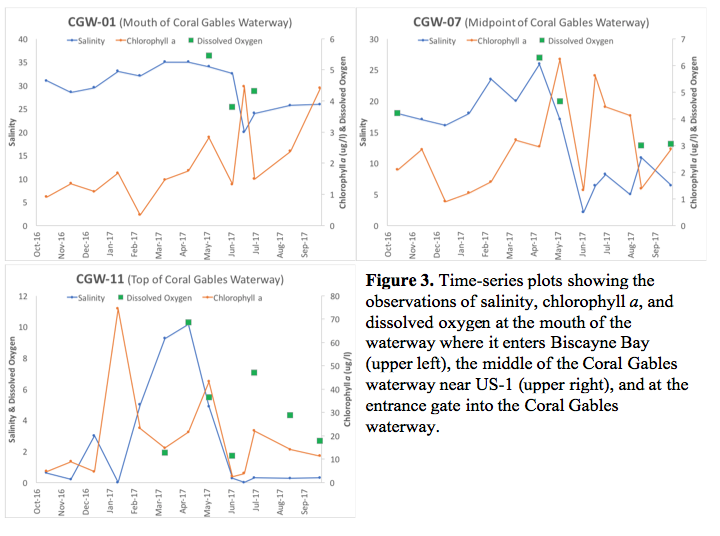 |
October 2, 2017
Field Work
OCED has been and will continue to conduct a number of cruises to assess the impact of Hurricane Irma on south Florida's coastal ecosystems. We have developed a website (/ocd/ocdweb/irmaresearch/) to help AOML and our partners keep updated on and disseminate findings from the various field activities:
● NOAA/AOML, NOAA/NESDIS, USF, and University of Miami will conduct a survey of south Florida's coastal waters on October 9-13, 2017 aboard the R/V Walton Smith. These cruises have been investigating coastal water quality in south Florida every other month since the late 1990s. This cruise is being enhanced and modified to better capture the response of south Florida coastal water quality to Hurricane Irma's passage on September 10-11, 2017. The main objectives of this cruise are to 1) Quantify the impact of Hurricane Irma on coastal water quality along the Florida Keys and southwest Florida shelf, and 2) Calibrate satellite measurements to be post-processed to provide a time-series of Hurricane Irma impacts on south Florida coastal waters. Parameters to be collected at each station or measured underway include Dissolved Inorganic Nutrients, Chlorophyll a, Dissolved Oxygen, Dissolved Inorganic Carbon, and fCO2. At select stations, we will collect samples to measure environmental DNA and Primary Productivity. We will be posting updates from the cruise as internet on board and timing allow.
● We have conducted two surveys of the Coral Gables waterway on September 23 & 28. We intend to keep sampling the waterway weekly until conditions return to near baseline. This will allow us to determine how Hurricane Irma affected the delivery of land-based nutrients to Biscayne Bay.
● We will conduct a survey of juvenile sportfish in Florida Bay in the next two weeks to quantify the effect of Hurricane Irma on seagrasses and juvenile sportfish in our study site. This will help determine how juvenile fish responded to the Hurricane's passage.
● We will conduct a survey of water quality in Biscayne Bay, a NOAA Habitat Focus Area, in the next 2 weeks. This will determine the effect of Hurrican Irma on water quality throughout Biscayne Bay.
Meetings
Dr. Kelly Goodwin will be speaking at TDWG 2017 Biodiversity Information Standards Conference in Ottawa, Canada in a session co-hosted by Luke Thompson. Dr. Goodwin's talk is entitled "Integrating Marine 'Omics into the Marine Biodiversity Observation Network (MBON) in Support of the UN Sustainable Development Goals (SDG) and Agenda 2030". Co-authors include NOAA's Gabrielle Canonico, members of the Sanctuaries MBON team, and JCVI scientists. Dr. Goodwin will participate in the Data Carpentry Workshop while there TDWG is the Taxonomic Data Working Group which will cover data analysis and visualization in R and SQL for data management.
September 25, 2017
Welcome Aboard
● Philip Bellamy started his NOAA Experiential Research & Training Opportunities (NERTO) last Week with Dr. Chris Kelble. Philip comes to AOML from Bethune Cookman University where he will graduate in December with an MS in environmental science. Philip will be working on applying GIS to advance our understanding of eutrophication in Biscayne Bay as part of the Biscayne Bay Habitat Focus Area. .
Meetings
● Dr. Chris Kelble will participate in a meeting to coordinate the assessment of ecosystem effects from Hurricane Irma in south Florida. If you plan to do anything to examine the impacts of Hurricane Irma on south Florida, please let Chris know of these activities, so he help coordinate them with other researchers. This meeting is being held as part of the Science Coordination Group for South Florida Ecosystem Restoration Task Force, on which Chris is a member.
● Dr. Luke Thompson participated remotely in the EuroMarine EMOSE 2017 Hackathon in Porto, Portugal, from September 11-15. As part of a working with a group of ~20 scientists, Dr. Thompson applied open-source tools to analyze marine metabarcoding data. The goal of the workshop was to identify best practices for data analysis for use in marine biodiversity estimates.
Field Work
● Lindsey Visser will be leading a survey of south Florida's coastal waters on October 2-6 aboard the R/V Walton Smith. This cruise is one of our typical surveys, but will have an additional focus of trying to increase our understanding of Hurricane Irma's impacts to south Florida coastal ecosystems. To do this, we are coordinating with Frank Muller-Karger at USF and NESDIS colleagues to include remote sensing surveys that will fly over the study area while we are sampling in situ. If you would like any samples taken during this cruise please let Dr. Chris Kelble know.
● Lindsey Visser, Dr. Chris Kelble, Philip Bellamy, and Ian Smith will be conducting concurrent surveys of Florida Bay water quality, seagrass, and juvenile sportfish populations on October 9-13. These surveys will help us to better understand how Hurricane Irma affected Florida Bay's ecosystem.
September 18, 2017
Manuscripts
● Dr. Rik Wanninkhof is co-author on manuscript 2017JC013461, "Metrics for the Evaluation of the Southern Ocean in Coupled Climate Models and Earth System Models", which has been submitted to the Journal of Geophysical Research - Oceans. The paper lead by Dr. J. Russell is the outcome of the special CLIVAR panel of the Southern Ocean Modelling Intercomparison Project. Dr. Rik Wanninkhof was a panel member.
Meetings
● A number of OCED scientists are attending the International Council for the Exploration of the Sea Annual Science Conference this week in Fort Lauderdale. Below are a list of presentations being given by these OCED scientists.
Title: Inclusion of DNA Sequencing into an Ecosystem Observing Program in the Southern California Bight
Authors: Kelly D. Goodwin, Lisa Zeigler Allen, Ariel Rabines, John McCrow, Andrew Allen
Title: The Earth Microbiome Project: lessons from a massive metagenetic survey
Authors: Luke R. Thompson, Jon G. Sanders, Daniel McDonald, Amnon Amir, Joshua Ladau, Kenneth J. Locey, Robert J. Prill, Anupriya Tripathi,
Sean M. Gibbons, Gail Ackermann, Jose A. Navas- Molina, Evguenia Kopylova, Yoshiki Vazquez-Baeza, Stefan Janssen, James T. Morton, Siavash Mirarab,
Zhenjiang Zech Xu, Mohamed F. Haroon, Jad Kanbar, Qiyun Zhu, Antonio Gonzalez, Se Jin Song, Tomasz Kosciolek, Nicholas A. Bokulich, Joshua Lefler,
Colin J. Brislawn, Greg C. Humphrey, Sarah M. Owens, Jarrad Hampton-Marcell, Donna Berg-Lyons, Valerie McKenzie, Noah Fierer, Jed A. Fuhrman,
Aaron Clauset, Rick L. Stevens, Ashley Shade, Katherine S. Pollard, Kelly D. Goodwin, Janet K. Jansson, Jack A. Gilbert, Rob Knight & The Earth
Microbiome Project Consortium
Title: Measuring the response of ecosystem indicators to events
Authors: Christopher R. Kelble, Mandy Karnauskas, Neda Trifonova, Seann Regan
Title: The Use of Hidden Variable Dynamic Models to Detect Functional Changes in the Gulf of Mexico Marine Ecosystem
Authors: Neda Trifonova, Christopher Kelble, and Mandy Karnauskas
Title: The Integrated Coral Observing Network
Authors: James C. Hendee, John Halas, Michael Jankulak, Lew Gramer, Pamela Fletcher, Joe Bishop, and
Natchanon Amornthammarong
September 5, 2017
Seminars
● Dr. Catalina Aguilar will give the following seminar in the AOML first floor conference room on Wednesday, September 6 at 10AM: Transcriptomic analyses of the responses of corals to environmental stress. Understanding the impacts that environmental stressors have on the coral cellular mechanisms is integral for determining the status of coral health. It also has important implications for persistence of coral reefs under rapidly changing climatic conditions. In this study we implemented a transcriptomic approach to investigate the response of the coral A. millepora to biotic and abiotic challenges in an attempt to better understand the molecular mechanisms underlying specific and general coral stress responses.
Meetings
● Dr. Christopher Sinigalliano and Dr. Maribeth Gidley of the NOAA AOML Microbiology Program will be on travel to Saipan from Sept 1 to Sept 17 to conduct a technology transfer training workshop in molecular Microbial Source Tracking (MST) for the Bureau of Environmental Coastal Quality (BECQ) of the Commonwealth of the Northern Mariana Islands (CNMI - a US territory). This training workshop is the first of a series of anticipated MST workshops in Saipan funded by the NOAA Coral Reef Conservation Program. Coral reef managers in CNMI have expressed the need for improved methods to detect and track Land-Based Sources of Pollution impacting the coral reefs and other marine ecosystems of the region. The primary goal of this first MST training workshop to be held at the BECQ lab in Saipan from Sept 5 to Sept 15 is to inform natural resource managers, BECQ personnel, and regional collaborators about the state of the art of microbial source tracking, including its processes, applications, benefits, and limitations, to train the BECQ lab personnel in specific MST methods and techniques to track host-specific fecal bacteria in the environment, and to aid the BECQ in adapting its instrumentation and lab equipment to conduct this MST analysis for themselves. The goal for the CNMI BECQ training is that at the end of the series of training workshops, BECQ will have the expertise, equipment, and other necessary resources to run their own MST laboratory and to serve as an environmental MST analysis center for the region, to better aid in coral reef management and in mitigation of LBSP impacting these ecosystems. The workshop this year focuses on training, proficiency testing, and validating the BECQ lab for performance of these MST techniques, while the next two workshops during the wet and dry seasons of FY18 will focus on application of these MST methods to an LBSP tracking study funded by the NOAA CRCP in collaboration with both the BECQ and the American University in Guam that will combine both microbial source tracking and stable isotope source tracking to determine LBSP pathways and impacts for marine ecosystems in Saipan Lagoon and elsewhere in the CNMI. This work is expected to help CNMI environmental quality managers better understand and mitigate LBSP contamination patterns to improve coral reef health.
● Dr. Jim Hendee will conduct a site survey for a CREWS station in St. Kitts and Nevis during September 15 - 18.
Recent Accomplishments
● After giving their presentation to the Coral Gables City Commission last week, Dr. Chris Kelble and Roland Samimy were instructed by the commission to prepare a plan to increase our understanding of nutrient pollution in the waterway. The ultimate goal of this plan will be to evaluate strategies that the city could potentially implement to reduce nutrient runoff into the waterway and ultimately Biscayne Bay. This work is undertaken as part of the Biscayne Bay Habitat Focus Area.
August 28, 2017
Field Work
● Dr. Xaymara Serrano will be traveling to Key Largo during the months of July and August to assist Dr. Margaret Miller's team (NOAA/SEFSC) and collaborators from the Florida Keys Coral Reef Foundation (CRF) in experiments aimed at characterizing the transcriptomic basis of disease resistance in Acropora corals. This project is part of OCED 'Omics initiative and will consist of quantifying various traits in the field through disease exposure/resistance assays and obtain a baseline characterization of genes that are responsible for disease susceptibility in these coral species. Overall, this information is expected to help predict which phenotypes are more "resistant" to disease and whether these "resistant" phenotypes also display a higher reproductive capacity during the spawning period.
● Lindsey Visser, Ian Smith, and Charline Quenee will conduct a survey of juvenile sportfish in Florida Bay on September 2-5, 2017. This is the fourth survey of the year. Thus far, the surveys are showing that seagrass and juvenile spotted seatrout are beginning to re-colonize in the epicenter of the 2015 mass seagrass die-off.
Meetings
● Dr. Rik Wanninkhof is attending a meeting at the request of the International Ocean Carbon Coordination Project (IOOCP) on Greenhouse Gases, and Related Measurement Techniques, GGMT-2017 in Dubendorf, Switzerland. It is the 19th meeting in a series which was initiated by Dr. C. D. Keeling at La Jolla, California in 1975. Today, GGMT is the cornerstone meeting for the observation of key greenhouse gases and tracers, their isotopes, assessment of new techniques, standardization, quality assurance, and data products. For the first time the series will include greenhouse gas measurements in the surface ocean and Wanninkhof will be the lead presenter and discussion leader on this topic.
● Chris Kelble and Roland Samimy (UMASS-Dartmouth) will be presenting research conducted as part of the Biscayne Bay Habitat Focus Area to the City of Coral Gables Commission Meeting on August 29. Chris will present results showing increasing eutrophication along the shoreline throughout Biscayne Bay and specific results on water quality and its connections to land-use within the Coral Gables waterway.
● Dr. Christopher Sinigalliano and Dr. Maribeth Gidley of the NOAA AOML Microbiology Program will be on travel to Saipan from Sept 1 to Sept 17 to conduct a technology transfer training workshop in molecular Microbial Source Tracking (MST) for the Bureau of Environmental Coastal Quality (BECQ) of the Commonwealth of the Northern Mariana Islands (CNMI - a US territory). This training workshop is the first of a series of anticipated MST workshops in Saipan funded by the NOAA Coral Reef Conservation Program. Coral reef managers in CNMI have expressed the need for improved methods to detect and track Land-Based Sources of Pollution impacting the coral reefs and other marine ecosystems of the region. The primary goal of this first MST training workshop to be held at the BECQ lab in Saipan from Sept 5 to Sept 15 is to inform natural resource managers, BECQ personnel, and regional collaborators about the state of the art of microbial source tracking, including its processes, applications, benefits, and limitations, to train the BECQ lab personnel in specific MST methods and techniques to track host-specific fecal bacteria in the environment, and to aid the BECQ in adapting its instrumentation and lab equipment to conduct this MST analysis for themselves. The goal for the CNMI BECQ training is that at the end of the series of training workshops, BECQ will have the expertise, equipment, and other necessary resources to run their own MST laboratory and to serve as an environmental MST analysis center for the region, to better aid in coral reef management and in mitigation of LBSP impacting these ecosystems. The workshop this year focuses on training, proficiency testing, and validating the BECQ lab for performance of these MST techniques, while the next two workshops during the wet and dry seasons of FY18 will focus on application of these MST methods to an LBSP tracking study funded by the NOAA CRCP in collaboration with both the BECQ and the American University in Guam that will combine both microbial source tracking and stable isotope source tracking to determine LBSP pathways and impacts for marine ecosystems in Saipan Lagoon and elsewhere in the CNMI. This work is expected to help CNMI environmental quality managers better understand and mitigate LBSP contamination patterns to improve coral reef health.
Recent Accomplishments
● Dr. Jim Hendee of AOML, John Halas of Environmental Moorings, Inc., and Albert Jones of the Caribbean Community Climate Change Center gave presentations and met with representatives of Fisheries, the Maritime Administration, the Port Authority, National Parks, Rivers and Beaches Authority, Tobago Cays Marine Park, and the Coast Guard of St. Vincent and the Grenadines on the morning of August 22, 2017 to discuss the best location for installing a Coral Reef Early Warning System (CREWS) station. After long discussion, it was decided to conduct a site survey in the Tobago Cays in the Grenadines, more specifically just east of Mayreau Island on Thusday, August 24. Preliminary research has found that near Mayreau there is a hot spring that appears to greatly benefit the coral ecosystem in the immediate vicinity. Further plans are being discussed within OCED for follow-up research in the area during the time of the CREWS station installation, most likely in June 2018.
August 21, 2017
Field Work
● Dr. Xaymara Serrano will be traveling to Key Largo during the months of July and August to assist Dr. Margaret Miller's team (NOAA/SEFSC) and collaborators from the Florida Keys Coral Reef Foundation (CRF) in experiments aimed at characterizing the transcriptomic basis of disease resistance in Acropora corals. This project is part of OCED 'Omics initiative and will consist of quantifying various traits in the field through disease exposure/resistance assays and obtain a baseline characterization of genes that are responsible for disease susceptibility in these coral species. Overall, this information is expected to help predict which phenotypes are more "resistant" to disease and whether these "resistant" phenotypes also display a higher reproductive capacity during the spawning period.
● Several AOML scientists are participating on the third Gulf of Mexico Ecosystems and Carbon Cruise (GOMECC-3) aboard the NOAA Ship R/V Ronald H. Brown that ends in Fort Lauderdale that ends this week. This AOML-lead survey documented ocean acidification impacts to US living marine resources and provided full coverage of the Gulf of Mexico. AOML scientists were joined by researchers from the University of Miami, University of South Florida, North Carolina State University, the University of Louisiana, and colleagues from three Mexican institutions.
● Dr. Jim Hendee will conduct a site survey in the coastal waters of St. Vincent and the Grenadines August 21-24 to determine the best location for a new Coral Reef Early Warning System (CREWS) station to monitor atmospheric and oceanographic conditions.
Meetings
● Dr. Neda Trifonova, Ben VanDine, and Dr. Chris Kelble will be attending the American Fisheries Society Annual Meeting in Tampa, FL from August 20-24. Chris will be giving a talk entitled "Applying a sportfish performance measure to estuarine restoration". Neda and Ben will be presenting posters entitled "Predicting Ecological Responses to Climate Variability with a Dynamic Bayesian Network Model" and "Population dynamics and genetic structure of Cynoscion nebulosus in Florida Bay", respectively.
● Dr. Rik Wanninkhof will be joining many other NOAA and international colleagues at the 10th International Carbon Dioxide Conference (ICDC-10). The conference series is uniquely focused on an integrated view of the global carbon cycle. The series was the brainchild of the greats in global carbon cycle research, including Drs. H.Oeschger, U. Siegenthaler and C. D. Keeling. Since its initiation in 1981 it has provided an integrated, interdisciplinary view of the global carbon cycle and its perturbation by humans. It has resulted in seminal conference journals describing the advances and evolution in understanding the global carbon cycle. As described in the program notes, CO2 emissions from fossil fuel use increased by 85% between the first conference in 1981 and the current meeting. This underscores the role of fossil carbon emissions as the dominant driver of anthropogenic climate change and ocean acidification. The current conference will include focus on recent findings of decadal variability in air-sea CO2 fluxes that are, not fully understood and not captured in models; and impacts of decadal variability and climate modes on ocean acidification. The data from sustained observations that NOAA/OAR (ESRL/GMD) provides in the atmosphere, and AOML and PMEL in the ocean are the center point and observational underpinning of many of the keynotes, presentations and posters.
● Dr. Rik Wanninkhof is attending a meeting at the request of the International Ocean Carbon Coordination Project (IOOCP) on Greenhouse Gases, and Related Measurement Techniques, GGMT-2017 in Dubendorf, Switzerland. It is the 19th meeting in a series which was initiated by Dr. C. D. Keeling at La Jolla, California in 1975. Today, GGMT is the cornerstone meeting for the observation of key greenhouse gases and tracers, their isotopes, assessment of new techniques, standardization, quality assurance, and data products. For the first time the series will include greenhouse gas measurements in the surface ocean and Wanninkhof will be the lead presenter and discussion leader on this topic.
August 14, 2017
Welcome Aboard
● Dr. Jim Hendee, Dr. Pamela Fletcher, Jack Stamates, and Lew Gramer welcomed a new graduate researcher, Andrea Gomez, this week. The team will be using very low-cost sensors built by Mana Ammornthammarong to measure sea temperature at very high spatial resolution along a line of mooring buoys on southeast Florida shelf, near Broward County. This field trial will contribute to research on the effects of sea temperature on coral reefs, and to an ongoing project to study upwelling on the shelf.
Manuscripts
● Dr. Rik Wanninkhof, Dr. Molly Baringer, and Dr. Rick Lumpkin all contributed to the recently released State of the Climate in 2016 report.
You can download the report at:
https://www.ametsoc.org/ams/index.cfm/publications/bulletin-of-the-american-meteorological-society-bams/state-of-the-climate/
and a newsy summary with links to highlights:
https://www.ncei.noaa.gov/news/reporting-state-climate-2016
Field Work
● Charles Featherstone is participating in the CLIVAR GO-SHIP P06 Cruise aboard the NOAA Ship Nathanial Palmer from June 20 through October 4.
● Dr. Xaymara Serrano will be traveling to Key Largo during the months of July and August to assist Dr. Margaret Miller's team (NOAA/SEFSC) and collaborators from the Florida Keys Coral Reef Foundation (CRF) in experiments aimed at characterizing the transcriptomic basis of disease resistance in Acropora corals. This project is part of OCED 'Omics initiative and will consist of quantifying various traits in the field through disease exposure/resistance assays and obtain a baseline characterization of genes that are responsible for disease susceptibility in these coral species. Overall, this information is expected to help predict which phenotypes are more "resistant" to disease and whether these "resistant" phenotypes also display a higher reproductive capacity during the spawning period.
● Several AOML scientists are participating in the third Gulf of Mexico Ecosystems and Carbon Cruise (GOMECC-3) aboard the NOAA Ship R/V Ronald H. Brown from July 18 to August 21. This AOML-lead survey will document ocean acidification impacts to US living marine resources. The cruise will provide full coverage of the Gulf of Mexico. AOML scientists will be joined by researchers from the University of Miami, University of South Florida, North Carolina State University, the University of Louisiana, and colleagues from three Mexican institutions.
Recent Accomplishments
● AOML student intern Hyo Won Lee, along with his mentors Dr. Christopher Sinigalliano and Dr. Maribeth Gidley, presented a poster on their CRCP-funded coral microbiome research at the United States Coral Reef Task Force Meeting held August 7-11 in Fort Lauderdale Florida. The poster was entitled "Next-Generation-Sequencing and Microbial Source Tracking to Investigate Associations between Reef Microbiome Community Structure, Land-Based Sources of Pollution, and Physical Habitat Characteristics." The research reported on the exposure of coral reefs offshore of Miami-Dade and Broward Counties to land-based microbial contaminants and how sources of LBSP microorganisms could influence coral reef microbiome structure.
August 7, 2017
Manuscripts
● Dr. Kelly Goodwin co-authored a paper that has been accepted for publication in the International Journal of Environmental Research and Public Health. The paper presents an application of microbial source tracking (MST) research. Specifically, MST for human fecal contamination was integrated into a regional assessment of water quality for drainages discharging to the coastal waters of the southern California Bight. The paper describes translation of MST results into site rankings to aid management in setting investment priorities for remediation.
Manuscript Citation
● Y. Cao, M.R. Raith, P.D. Smith, J.F. Griffith, S.B. Weisberg, A. Schriewer, G. Amenu, A.Sheldon, C. Crompton, X. Yu, J.Gregory, J. Guzman, K.D. Goodwin, L. Othman, M. Manasjan, S. Choi, S. Rapoport, S. Steele, and T. Nguyen. In Press. Regional assessment of human fecal contamination in southern California coastal drainages. International Journal of Environmental Research and Public Health.
Field Work
● Charles Featherstone is participating in the CLIVAR GO-SHIP P06 Cruise aboard the NOAA Ship Nathanial Palmer from June 20 through October 4.
● Dr. Xaymara Serrano will be traveling to Key Largo during the months of July and August to assist Dr. Margaret Miller's team (NOAA/SEFSC) and collaborators from the Florida Keys Coral Reef Foundation (CRF) in experiments aimed at characterizing the transcriptomic basis of disease resistance in Acropora corals. This project is part of OCED 'Omics initiative and will consist of quantifying various traits in the field through disease exposure/resistance assays and obtain a baseline characterization of genes that are responsible for disease susceptibility in these coral species. Overall, this information is expected to help predict which phenotypes are more "resistant" to disease and whether these "resistant" phenotypes also display a higher reproductive capacity during the spawning period.
● Several AOML scientists are participating in the third Gulf of Mexico Ecosystems and Carbon Cruise (GOMECC-3) aboard the NOAA Ship R/V Ronald H. Brown from July 18 to August 21. This AOML-lead survey will document ocean acidification impacts to US living marine resources. The cruise will provide full coverage of the Gulf of Mexico. AOML scientists will be joined by researchers from the University of Miami, University of South Florida, North Carolina State University, the University of Louisiana, and colleagues from three Mexican institutions.
July 31, 2017
Field Work
● Charles Featherstone is participating in the CLIVAR GO-SHIP P06 Cruise aboard the NOAA Ship Nathanial Palmer from June 20 through October 4.
● Dr. Xaymara Serrano is traveling to Key Largo during the months of July and August to assist Dr. Margaret Miller's team (NOAA/SEFSC) and collaborators from the Florida Keys Coral Reef Foundation (CRF) in experiments aimed at characterizing the transcriptomic basis of disease resistance in Acropora corals. This project is part of OCED 'Omics initiative and will consist of quantifying various traits in the field through disease exposure/resistance assays and obtain a baseline characterization of genes that are responsible for disease susceptibility in these coral species. Overall, this information is expected to help predict which phenotypes are more "resistant" to disease and whether these "resistant" phenotypes also display a higher reproductive capacity during the spawning period.
● Several AOML scientists are participating in the third Gulf of Mexico Ecosystems and Carbon Cruise (GOMECC-3) aboard the NOAA Ship R/V Ronald H. Brown from July 18 to August 21. This AOML-lead survey will document ocean acidification impacts to US living marine resources. The cruise will provide full coverage of the Gulf of Mexico. AOML scientists will be joined by researchers from the University of Miami, University of South Florida, North Carolina State University, the University of Louisiana, and colleagues from three Mexican institutions.
● Dr. Christopher Kelble, Dr. Neda Trifonova, Dr. Nicole Millette, and Dylan Sinnickson will be participating in a survey of water quality and biological oceanography in south Florida's coastal waters this week. This is the latest bi-monthly survey of south Florida's coastal oceanography to assess and evaluate potential impacts from Everglades Restoration.
July 24, 2017
Manuscripts
● Dr. Rik Wanninkhof is co-author on a manuscript in press at Environmental Science and Technology. The article, entitled "Elimination of instrument-dependent offsets and calculation of in situ saturation states", describes an improved algorithm for spectrophotometric determinations of seawater carbonate ion concentrations derived from observations of ultraviolet absorbance spectra in lead-enriched seawater from data obtained on two NOAA research cruises (2012 and 2016) . We demonstrate that these in situ values can be used to determine calcium carbonate saturation states that are in good agreement with those determined by more laborious and expensive conventional methods.
Manuscript Citation
● Sharp, JD, RH Byrne, X Liu, RA Feely, EE Cuyler, R Wanninkhof, SR Alin. In Press. Elimination of instrument-dependent offsets and calculation of in situ saturation states. Environmental Science and Technology.
Field Work
● Charles Featherstone is participating in the CLIVAR GO-SHIP P06 Cruise aboard the NOAA Ship Nathanial Palmer from June 20 through October 4.
Field Campaigns
● Dr. Maribeth Gidley, LT(jg) Ben VanDine, and Joe Lopez (NSU) will be collecting samples for the Marine Biodiversity Observing Network (MBON) for the Florida Keys National Marine Sanctuary this week from July 24-26. They will be collecting water, sediments, and coral tissue samples that will be used for molecular analysis of microbial biodiversity by AOML microbiology researchers. This work, as part of AOML Coral Genomic Observing Network (CGON) is characterizing the microbial community structure and biodiversity of coral reef microbiomes in the Florida Keys as part of a larger MBON effort to document biodiversity across trophic levels in the marine sanctuary. This project uses a variety of both traditional and state-of-the-art molecular tools such as Next-Generation-Sequencing (NGS) and molecular microbial source tracking to better characterize overall coral reef community structure and health trends. This CGON component of the larger FKNMS MBON program is conducted by AOML in collaboration with partners from the University of South Florida and the Florida Keys National Marine Sanctuary.
● Charles Featherstone is participating in the CLIVAR GO-SHIP P06 Cruise aboard the US Antarctic Program Ship (USAP) Nathanial Palmer from June 20 through October 4.
● Dr. Xaymara Serranois will be traveling to Key Largo during the months of July and August to assist Dr. Margaret Miller's team (NOAA/SEFSC) and collaborators from the Florida Keys Coral Reef Foundation (CRF) in experiments aimed at characterizing the transcriptomic basis of disease resistance in Acropora corals. This project is part of OCED 'Omics initiative and will consist of quantifying various traits in the field through disease exposure/resistance assays and obtain a baseline characterization of genes that are responsible for disease susceptibility in these coral species. Overall, this information is expected to help predict which phenotypes are more “resistant” to disease and whether these "resistant" phenotypes also display a higher reproductive capacity during the spawning period.
● Several AOML scientists are participating on the third Gulf of Mexico Ecosystems and Carbon Cruise (GOMECC-3) aboard the NOAA Ship R/V Ronald H. Brown from July 18 to August 21. This AOML-lead survey is documenting ocean acidification impacts to US living marine resources and provides full coverage of the Gulf of Mexico. AOML scientists are joined by researchers from the University of Miami, University of South Florida, North Carolina State University, the University of Louisiana, and colleagues from three Mexican institutions.
● Dr. Christopher Kelble, Dr. Neda Trifonova, Dr. Nicole Millette, and Dylan Sinnickson will be participating in a survey of water quality and biological oceanography in south Florida's coastal waters. This is the latest bi-monthly survey of south Florida's coastal oceanography to assess and evaluate potential impacts from Everglades Restoration.
Meet and Greet
● There was a OCED meet and greet for bioinformatics specialist Stephanie Rosales on Thursday July 27 at 10am in the 2nd floor conference room.
Opportunities for Interns
● Dr. Chris Kelble represented AOML at the NOAA Center for Coastal and Marine Ecosystems Annual Meeting in Charleston, SC on July 20th and 21st. CCME graduate students and post-docs are required to complete a 12-week internship at a NOAA facility or on a cruise. These internships are paid for by CCME and cost us nothing. It will be a great opportunity to increase the diversity of AOML and provide our scientists with exposure to a different group of graduate students beyond our typical collaborators. CCME is focused on place-based conservation, coastal intelligence, and coastal resilience. The student research focuses upon a wide-range of coastal ecosystem topics including nutrient cycling, carbon cycling, machine-learning, big data, and Harmful Algal Blooms. Please let Chris know if you are interested in hosting a student or want more information
● The NOAA Office of Education strongly recommends all NOAA mentors conduct internships using the Office of Education (OED) Student Scholarship Internship Opportunities (SSIO) online system (https://oedwebapps.iso.noaa.gov/ssio/). This is no cost and is used to track and quality control NOAA internships. Moreover, all NOAA mentors should take the mentor training available in the Commerce Learning Center.
July 17, 2017
Manuscripts
● Rik Wanninkhof is co-author on a manuscript in press at Continental Shelf Research. In the article, entitled "Time series pCO2 at a coastal mooring: Internal consistency, seasonal cycles, and interannual variability", the research team analyzed data from the Gray's Reef (GR) mooring in the South Atlantic Bight (SAB) for internal consistency with pCO2w from underway cruise data, moored autonomous time series, and calculated from bottle samples (DIC-TA pairing). They describe the seasonal to interannual pCO2w time series variability and air-sea flux (FCO2), as well as describe the potential sources of pCO2w variability; and determine the source/sink for atmospheric pCO2. Over the ~8.5 years of GR mooring time series, mooring-underway and mooring-bottle calculated-pCO2w strongly correlate with r-values > 0.90.
Manuscript Citation
● Reimer, J. J., W.-J. Cai, L. Xue, R. Vargas, S. Scott Noakes, X. Hu, S. R. Signorini, J. T. Mathis, R. A. Feely, A. J. Sutton, C. Sabine, S. Musielewicz, B. Chen, R. Wanninkhof. 2017. Time series pCO2 at a coastal mooring: Internal consistency, seasonal cycles, and interannual variability. Continental Shelf Research. Accepted
Field Work
● Catalina Aguilar, Kami Cohen, Dr. Ian Enochs, Dr. Paul Jones, Graham Kolodziej, and Dr. Derek Manzello. are traveling to Islamorada, Florida the week of 17-21 July. The CRCP funded project "Elucidating the recipe of coral reef resilience in the Florida Keys" has led to the discovery of unique genotypes of the ESA listed coral Orbicella faveolata in the Florida Keys that are bleaching resistant. AOML/OCED will conduct field experiments, as well as collect corals for lab experiments in the Future Reefs Lab, to quantify the heat tolerance of these genotypes and determine if they can be used for restoration efforts.
● Charles Featherstone is participating in the CLIVAR GO-SHIP P06 Cruise aboard the NOAA Ship Nathanial Palmer from June 20 through October 4.
● Dr. Xaymara Serrano will be traveling to Key Largo during the months of July and August to assist Dr. Margaret Miller's team (NOAA/SEFSC) and collaborators from the Florida Keys Coral Reef Foundation (CRF) in experiments aimed at characterizing the transcriptomic basis of disease resistance in Acropora corals. This project is part of OCED 'Omics initiative and will consist of quantifying various traits in the field through disease exposure/resistance assays and obtain a baseline characterization of genes that are responsible for disease susceptibility in these coral species. Overall, this information is expected to help predict which phenotypes are more "resistant" to disease and whether these "resistant" phenotypes also display a higher reproductive capacity during the spawning period.
● Several AOML scientists will be participating in the third Gulf of Mexico Ecosystems and Carbon Cruise (GOMECC-3) aboard the NOAA Ship R/V Ronald H. Brown from July 18 to August 21. This AOML-lead survey will document ocean acidification impacts to US living marine resources. The cruise will provide full coverage of the Gulf of Mexico. AOML scientists will be joined by researchers from the University of Miami, University of South Florida, North Carolina State University, the University of Louisiana, and colleagues from three Mexican institutions.
● An AOML scientist will conduct a site survey in the coastal waters of St. Vincent and the Grenadines in mid-August to determine the best location for a new Coral Reef Early Warning System (CREWS) station to monitor atmospheric and oceanographic conditions.
Meetings
● Jim Hendee, John Halas of Environmental Moorings International, Inc., and Albert Jones of the Caribbean Community Climate Change Centre, met with various officials of the Antigua and Barbuda government on Tuesday, July 11, 2017. Jim's presentation was met with approval and plans were made to follow up with site surveys later in the week, as well as plans for the installation of the CREWS station in the future. Below is a list of Antigua participants in that meeting along with photographs of the meeting participants.
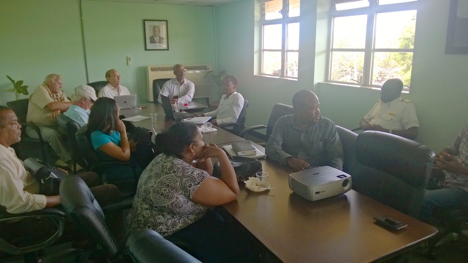 |
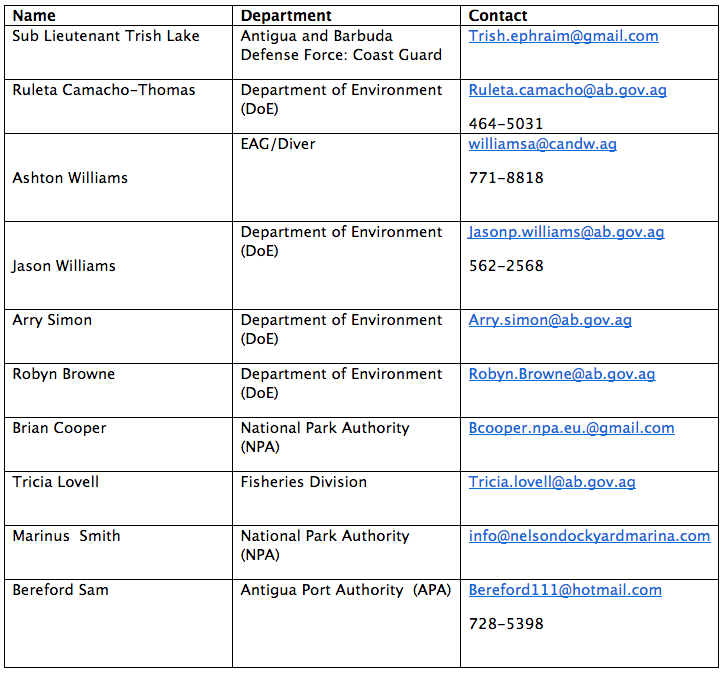 |
July 10, 2017
Field Work
● Charles Featherstone is participating in the CLIVAR GO-SHIP P06 Cruise aboard the NOAA Ship Nathanial Palmer from June 20 through October 4.
● Dr. Jim Hendee conducted a site survey in the coastal waters of Antigua and Barbuda from July 10-14 to determine the best location for a new Coral Reef Early Warning System (CREWS) station to monitor atmospheric and oceanographic conditions.
July 3, 2017
Manuscripts
● The following paper is in press in the journal Environmental Science and Technology: "Consideration of Natural Sources in a Bacteria TMDL – Lines of Evidence, including Beach Microbial Source Tracking" (10.1021/acs.est.6b05886) by Kelly D. Goodwin, A. Schriewer, A. Jirik, K. Curtis, and A. Crumpacker. The manuscript documents Research-to-Commercial (R2C) and Research-to-Application (R2A) transition under CRADA No. 50-23 3RR3HWSP13. The work applies to a prevailing issue nationally for both marine and fresh waters – failure to meet water quality standards due to non-point sources of bacteria. The study utilized multiple lines of evidence to evaluate bacterial sources in the context of Total Maximum Daily Load (TMDL) stipulations. It appears to be the first peer-reviewed manuscript pertaining to environmental studies at a site with an adopted TMDL under consideration for a Natural Sources Exclusion (NSE) provision. Why the site has been unable to comply with TMDL stipulations despite an investment of over $23 million dollars is discussed, including comparison of regional stipulations that are more stringent than federal guidelines. The paper describes results from culture-based monitoring and qPCR measurements of fecal indicator bacteria, Microbial Source Tracking (MST), pathogen analysis, sanitary infrastructure testing, and evaluation of the efficacy of management action to control bird populations. Overall, data indicate that exceedances of bacterial water quality could be traced to birds, consistent with the NSE provision; however, available science fell short of providing the load allocations desired for reconsideration of the TMDL. Quantitative Microbial Risk Assessment (QMRA) is suggested as a possible path forward, and site measurements are provided in context with existing QMRA analyses.
Field Work
● Charles Featherstone is participating in the CLIVAR GO-SHIP P06 Cruise aboard the NOAA Ship Nathanial Palmer from June 20 through October 4.
Advanced Manufacturing Lab for OCED
● The room formerly known as "Shoe's Shop" is being transformed into OCED's new Advanced Manufacturing Lab. This will be a collaborative space where people will have access to state of the art equipment for digital design and fabrication. Available equipment will include PLA and SLA 3D printers, a laser cutter, as well as a CNC machine. Ian Enochs successfully submitted a proposal to fund the majority of the development of this facility at AOML/OCED. The goal of this space is to facilitate rapid prototyping and construction of custom equipment, supporting OCED's scientific and monitoring missions.
A New Research Vessel for AOML
● A contract will be executed beginning on July 1, 2017 to have a new research vessel build by Dusky Marine to improve our field capabilities at AOML. We will be acquiring a Dusky 252 CSS capable of operating nearshore and offshore while accommodating up to 7 passengers that will serve as a multi-use platform for OAR to conduct water chemistry, coral reef, physical oceanographic, and diving operations to support research projects in the South Florida region.
June 26, 2017
Meetings
● Ben Friedman, acting NOAA Administrator and Under Secretary of Commerce for Ocean and Atmosphere visited the Southwest Fisheries Center on June 27. Kelly Goodwin was one of the presenters during the tour. She provided an overview of OAR-NMFS 'Omics joint activities and the AOML 'Omics program.
Instrument Development
● AOML/CIMAS scientist Natchanon Amornthammarong has developed extremely low-cost sea temperature recording devices for shallow ocean waters. Interns of the AOML Microbiology Lab (led by AOML scientist Chris Sinigalliano) will be on loan to assemble a significant number of these devices next week. As part of a citizen-science collaboration with local communities, schools, and county partners in Broward County led by AOML/Sea Grant scientist Pamela Fletcher, an array of these devices will be deployed on southeast Florida shelf in July, to observe gradients in sea temperature across and along-shore and high-frequency variability, including possible summer upwelling. These data will be analyzed by NOAA-CREST Fellow Andrea Gomez beginning this Fall, in concert with Fletcher, AOML scientist Jack Stamates, and AOML/CIMAS scientist Lew Gramer. This project is part of a larger effort by OCED Director Jim Hendee's Coral Health and Monitoring Program (CHAMP) to understand sea temperature at the scales and depths where corals and other coastal benthic organisms really experience it.
Reports
● A new report will be published June 23 on past and future temperature stress on UNESCO World Heritage sites containing reefs. This report will highlight the urgency of coral bleaching to the World Heritage committee next month. The UNESCO World Heritage Convention has united the world around a shared responsibility to protect natural and cultural places of Outstanding Universal Value. The World Heritage List includes 29 marine areas with coral reefs. Stretching around the planet, these globally significant reefs include icons such as the Phoenix Islands Protected Area (Kiribati), the Great Barrier Reef (Australia), Papahanaumokuakea National Park (USA), Belize Mesoamerican Barrier Reef Reserve System (Belize) and Tubbataha Reefs Natural Park (Philippines). They are recognized for their unique and global importance and for being part of the common heritage of humanity. Heron et al. 2017. Impacts of Climate Change on World Heritage Coral Reefs : A First Global Scientic Assessment. Paris, UNESCO World Heritage Centre. Ruben van Hooidonk is one of the study's co-authors. http://whc.unesco.org/en/news/1676.
Outreach
● Dr. Ian Enochs gave a lecture to high school juniors and seniors participating in the IMPACT program. Examples of ACCRETE research in the Marianas, Papua New Guinea, the Galapagos, and the Florida Keys were used to communicate principles of ocean acidification and coral reef ecology. Following the presentation in the RSMAS conference room, students toured the Future Reef Lab and learned about AOML's new 'Omics program. Ian also met with teachers from MAST, Gulliver and Thomas Edison's iTech schools, as well as Miami's Moonlighter Program, but he is still working out the details of potential involvement and lesson plan development.
Field Work
Charles Featherstone is participating in the CLIVAR GO-SHIP P06 Cruise aboard the NOAA Ship Nathanial Palmer from June 20 through October 4.
June 20, 2017
Welcome
● AOML welcomes NOAA Hollings Scholar Nathan Lanning, a marine biology and biochemistry major at the University of New Haven. Nathan will work with Dr. Jia-Zhong Zhang this summer and participate in a cruise aboard the R/V F.G.Walton Smith to learn nutrient measurement techniques for analysis of water and sediment samples.
Field Work
● On June 15 to June 24, Graham Kolodziej and Lauren Valentino will be in Puerto Rico to conduct field work for the National Coral Reef Monitoring Program (NCRMP). Graham and Lauren will be swapping out temperature probes and deploying bioerosion monitoring units and calcification accretion units at sites around the entire island. They will conduct carbonate budget and photographic landscape mosaic surveys in La Parguera.
● On June 19 to June 21, Dr. Maribeth Gidley, Dr. Paul Jones, and LTJG Den VanDine will collect water, sediment and coral tissue samples for the Marine Biodiversity Observing Network (MBON) of the Florida Keys NAtional Marine Sanctuary (FKNMS). AOML microbiology researches will analyze these samples to determine microbial biodiversity using both traditional and state-of-the-art molecular tools to better characterize overall coral reef community structure and health trends. The work, performed in support of the AOML's Coral Genomic Observing Network (CGON), seeks to characterize the microbial community structure and biodiversity of coral reef microbiomes in the Florida Keys. It's also part of a larger MBON effort to document biodiversity across trophic levels in the FKNMS.
● On June 19 to June 23, Linsey Visser will lead a South Florida Ecosystem Restoration cruise aboard the R/V F.G. Walton Smith. Other cruise participants include Ian Smith (OCED/CIMAS), Dylan Sinnickson (RSMAS MPS student), NOAA-AOML Hollings Scholar Nathan Lanning, and researchers from the University of South Florida.
Meetings
● On June 19 to June 23, Dr. Chris Kelble, Dr. Neda Trifonova and Charline Quenee will attend NOAA's Integrated Ecosystem Assessment meeting in Boulder, Colorado.
June 5, 2017
Recent Accomplishments
● Dr. Luke Thompson attended the 19th Workshop of the Genomics Standards Consortium (GSC) in Brisbane, Australia from May 15-17. GSC is an international organization that develops and implements standard methods for the collection and sequencing of environmental genomes. Dr. Thompson presented a new ontology for categorizing microbial habitats, developed as part of the Earth Microbiome Project (EMP). This new framework was enthusiastically received and is slated to be adopted in the next iteration of the Environment Ontology (EnvO).
● Drs. Maribeth Gidley and Chris Sinigalliano gave a special presentation on Friday, June 2nd to the City of Miami's Sea Level Rise Committee regarding nutrient and microbial contaminants in coastal tidal floodwaters of South East Florida. They gave a similar presentation last week to the Miami-Dade County Regulatory and Economic Resources Dept. This information from research by NOAA AOML and its academic partners is being utilized by local cities such as Miami and Miami Beach, and by the county in their planning for improving local resilience and adaptation to sea level rise and tidal flooding of the urbanized coast in Southeastern Florida.
Meetings/Workshops
● On June 5th-9th, Ben VanDine will attend a Bioinformatics "bootcamp" workshop at Auburn University, AL. This workshop emphasizes hands-on training in numerous aspects of next generation DNA sequencing data analyses such as sequence assessment and quality control, genomic and transcriptomic assembly, annotation, differential expression, phylogenomics and more. Additionally the workshop provides instruction in the Linux operating system command-line environment, basic scripting and many widely used open-source software packages. This information will be extremely valuable in setting up and operating the OCED bioinformatics server and analyzing a variety of genomic data collected from OCED projects.
● Xaymara Serrano will travel to Mote Marine Laboratory in Summerland Key on June 9-18 to participate in a workshop entitled "Methods in Ecological Genomics". This workshop is hosted by researchers from the University of Austin, Texas, and will be focused on genome-wide gene expression analysis with TagSeq. The workshop will consist of wet lab techniques (such as RNA isolation), preparation of next-generation sequencing libraries and bioinformatic analysis. Overall, Xaymara plans on using these techniques in a project aimed at assessing the genomic basis of disease resistance in Acroporid corals. This project is being undertaken in conjunction with Drs. Margaret Miller (NOAA/SEFSC), Nikki Traylor-Knowles (UM/RSMAS) and Jim Hendee.
● On June 19-23, Dr. Chris Kelble, Dr. Neda Trifonova, and Charline Quenee will attend the NOAA Integrated Ecosystem Assessment meeting in Boulder, CO.
● Dr. Luke Thompson will attend the upcoming Symposium on the Mobilization of Structured Biodiversity Data in Leipzig, Germany from June 28-30, co-hosted by the German Centre for Integrative Biodiversity Research (iDiv), the Group on Earth Observations Biodiversity Observation Network (GEO BON), and the Global Biodiversity Information Facility (GBIF). He will convene with international partners to develop scalable solutions for data management and sharing.
May 30, 2017
Manuscripts
The following papers were accepted/published in the past week:
● Sutton, A. J., R. Wanninkhof, C. L. Sabine, R. A. Feely, M. F. Cronin and R. Weller (2017). "Variability and trends in surface seawater pCO2 and CO2 flux in the Pacific Ocean." Geophys. Res. Let. [Paper #2017GL073814R], accepted May 22, 2017.
●Wanninkhof, R. and J. A. Trinanes (2017). "The impact of changing wind speeds on gas transfer and its effect on global air-sea CO2 fluxes." Global Biogeochem Cycles. doi:10.1002/2016GB005592.
●Xu, Y.-Y., W.-J. Cai, Y. Gao, R. Wanninkhof, J. Salisbury, B. Chen, J. J. Reimer, S. Gonski and N. Hussain (2017). "Short-term variability of aragonite saturation state in the central Mid-Atlantic Bight." J. Geophys. Res. Oceans 122. doi10.1002/2017JC01290.
Field Work
● Lindsey Visser completed the inaugural juvenile sportfish survey of 2017 which took place in the Florida Bay from May 27-30. These were the first observations to see if the good recruitment year of 2016 continues into 2017 or if the drier than normal dry season raised salinities to a sub-optimal level.
May 22, 2017
International Activities
● During Jim Hendee's recent trip to Sri Lanka, he was able to meet with (and gain enthusiastic support from) the Minister of Sustainability and Wildlife, the Commander of the Navy, and the founders of Blue Resources Trust, and explain the role of the Coral Reef Early Warning System (CREWS) in helping to begin the long process of establishing environmental trends at Pigeon Island National Park, as well as how ecological forecasts produced by the CREWS system can help environmental managers. Dr. Hendee also gave a public lecture to over a hundred citizens on what NOAA does and the new CREWS partnership.
Field Work
● Lindsey Visser will be conducting the inaugural juvenile sportfish survey of 2017 on May 27-30 in Florida Bay. This will be our first observations to see if the good recruitment year of 2016 continues into 2017 or if the drier than normal dry season raised salinities to a sub-optimal level.
Issues Requiring AA/DAA Decision, Action or Direction and/or Updates on Key Research Programs and Activities
● A Memorandum of Understanding (MOU) will soon require a signature for a collaboration between the Caribbean Community Climate Change Center and NOAA/AOML.
● Planning and coordination activities for the third Gulf Of Mexico Ecosystems and Carbon Cruise (GOMECC) continue. The cruise is scheduled to take place in July-August of 2017. Clearance requests for working in the Exclusive Economic Zone (EEZ) of Mexico and Cuba have been submitted. We expect to hear back from Cuba shortly. The Mexican request has been forwarded to several agencies that need to review it. Coordination with the National Parks Service (NPS) will allow sampling to extend into several national parks in the Gulf of Mexico. Researchers from AOML's OCED and PhOD are expected to participate in the cruise, as well as researchers from UM, USF, NCSU, ULL and colleagues from 3 Mexican institutions.
May 15, 2017
International Activities
● Dr. Rik Wanninkhof will be giving a keynote presentation at the Surface Ocean Lower Atmosphere (SOLAS) Frontiers in Ocean-Atmosphere Exchange meeting in Cargese, France on May 15. His presentation entitled "Advances in Estimating Anthropogenic CO2 Uptake by the Ocean" will focus on the uptake capacity of the ocean and its role contributing to "negative carbon emissions" as a future CO2 mitigation strategy.
Issues Requiring AA/DAA Decision, Action or Direction and/or Updates on Key Research Programs and Activities
● Planning and coordination activities for the third Gulf Of Mexico Ecosystems and Carbon Cruise (GOMECC) continue. The cruise is scheduled to take place in July-August of 2017. Clearance requests for working in the Exclusive Economic Zone (EEZ) of Mexico and Cuba have been submitted. We expect to hear back from Cuba shortly. The Mexican request has been forwarded to several agencies that need to review it. Coordination with the National Parks Service (NPS) will allow sampling to extend into several national parks in the Gulf of Mexico. Researchers from AOML's OCED and PhOD are expected to participate in the cruise, as well as researchers from UM, USF, NCSU, ULL and colleagues from 3 Mexican institutions.
May 8, 2017
International Activities
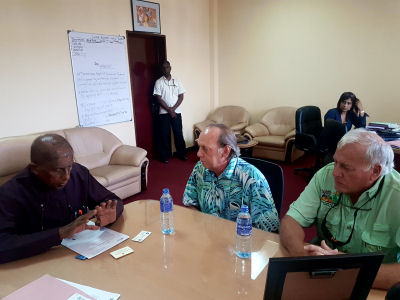
● Dr. Jim Hendee and John Halas (contractor from Environmental Moorings International, Inc. who is helping with the CREWS station installation) met with the Sri Lanka Minister of Sustainable Development and Wildlife, Gamini Jayawickrama Perera. The Minister formally endorsed our CREWS project and offered his government's support, which is a big deal. John and Jim were invited to attend the Parliamentary Session on Wednesday, a rare invite for foreigners (like sitting in on the U.S. Congress, I guess). Dr. Jim Hendee traveled to Sri Lanka on April 29, ultimately he is heading to Pigeon Island National Park to determine a suitable site for the installation of a Coral Reef Early Warning System (CREWS) station within the national park boundaries. Once the site is chosen, plans will begin to prepare, test, ship from Miami, and install the buoy at the site within the next year or two. The near real-time data will be utilized for ecological forecasts of coral bleaching and other marine environmental events, and will serve to establish long-term data sets against which to measure marine and atmospheric status and trends. The station will measure all standard meteorological data, as well as sea temperature, salinity and light, with the capability of adding other sensors in the future, if desired. These data will help Blue Resources Marine Research and Consultancy, and the Sri Lanka Department of Wildlife Conservation predict coral bleaching (and other marine environmental events) and better understand yearly meteorological and oceanographic changes.
Field Work
● Graham Kolodziej, Dr. Derek Manzello, Lauren Valentino, and Ben Van Dine are traveling to Islamorada, Florida from 9-12 May 2017. They will be swapping pH and light instruments, as well as collecting coral samples as part of the "Elucidating the Recipe of coral reef resilience in the Florida Keys" project. This work is measuring the resilience response of corals across environmental gradients to the 2014 and 2015 mass coral bleaching events.
● NOAA and partners are participating in field tests of a prototype long-range AUV equipped with genomic sampling capability developed by the Monterey Bay Aquarium Research Institute (MBARI). Personnel from NOAA (AOML's Dr. Kelly Goodwin and SWFSC), J. Craig Venter Institute (JCVI), Stanford University, and MBARI are collecting samples by traditional methods for comparison to the eAUVs ability to intelligently sample water column features, such as the chlorophyll maximum. The California Cooperative Oceanic Fisheries Investigations (CalCOFI) cruise sampling was completed on April 21. The Pelagic Juvenile Rockfish Recruitment and Ecosystem Assessment Survey (Rockfish) cruise sampling will finish May 6, 2017.
Meetings/Workshops
● Dr. Rik Wanninkhof will be presenting a talk on Advancement of the Biogeochemical (BGC) Essential Ocean Variables (EOVs) at the NOAA/CPO Ocean Observation and Monitoring Division PI meeting on May 9 in Silver Spring, MD. EOVs are an integral part of the Global Ocean Observing System (GOOS) framework of sustained ocean observations (FOO). The Framework is designed to approach ocean observations the concept of EOVs, ensuring assessments that cut across platforms and recommend the best, most cost effective plan to provide an optimal global view for each EOV.
● Dr. Rik Wanninkhof will be leading a discussion session on Carbon Chemistry Best Practices at the Southern Ocean Carbon Cycle Observations and Modelling (SOCCOM) meeting on May 10 in Princeton, NJ. The focus of the session is on the uncertainties in determining the air-sea CO2 flux in the Southern Ocean using data from the Biochemical (BGC) ARGO floats.
May 1, 2017
International Activities
● Dr. Jim Hendee traveled to Pigeon Island National Park in Sri Lanka on April 29 to determine a suitable site for the installation of a Coral Reef Early Warning System (CREWS) station within the national park boundaries. Once the site is chosen, plans will begin to prepare, test, ship from Miami, and install the buoy at the site within the next year or two. The near real-time data will be utilized for ecological forecasts of coral bleaching and other marine environmental events, and will serve to establish long-term data sets against which to measure marine and atmospheric status and trends. The station will measure all standard meteorological data, as well as sea temperature, salinity and light, with the capability of adding other sensors in the future, if desired. These data will help Blue Resources Marine Research and Consultancy, and the Sri Lanka Department of Wildlife Conservation predict coral bleaching (and other marine environmental events) and better understand yearly meteorological and oceanographic changes.
Field Work
● Graham Kolodziej, Dr. Derek Manzello, Lauren Valentino, and Ben Van Dine will be traveling to Islamorada, Florida from 9-12 May 2017. They will be swapping pH and light instruments, as well as collecting coral samples as part of the "Elucidating the Recipe of coral reef resilience in the Florida Keys" project. This work is measuring the resilience response of corals across environmental gradients to the 2014 and 2015 mass coral bleaching events.
Meetings
● Dr. Xaymara Serrano will travel to St. Petersburg on May 1-3rd to present the findings from the final year of funding from the NOAA grant entitled "Understanding Coral Ecosystem Connectivity in the Gulf of Mexico-Pulley Ridge to the Florida Keys". This work is a collaborative project with multiple investigators from the University of Miami and other institutions in Florida. The main goal of this project was to understand connectivity patterns between Pulley Ridge (the deepest coral ecosystem in the continental USA) and the Florida Keys reef tract. The aim of the meeting is to provide a synthesis of all the scientific findings during the 5-year grant period.
April 24, 2017
International Activities
● Dr. Jim Hendee will be traveling to Pigeon Island National Park in Sri Lanka on April 29 to determine a suitable site for the installation of a Coral Reef Early Warning System (CREWS) station within the national park boundaries. Once the site is chosen, plans will begin to prepare, test, ship from Miami, and install the buoy at the site within the next year or two. The near real-time data will be utilized for ecological forecasts of coral bleaching and other marine environmental events, and will serve to establish long-term data sets against which to measure marine and atmospheric status and trends. The station will measure all standard meteorological data, as well as sea temperature, salinity and light, with the capability of adding other sensors in the future, if desired. These data will help Blue Resources Marine Research and Consultancy, and the Sri Lanka Department of Wildlife Conservation predict coral bleaching (and other marine environmental events) and better understand yearly meteorological and oceanographic changes.
Field Work
● Dr. Maribeth Gidley, LT Marc Weekley, and LT(jg) Ben VanDine will be collecting samples for the Marine Biodiversity Observing Network (MBON) project in the Florida Keys National Marine Sanctuary (FKNMS) this week from April 25-27. They will be collecting water, sediments, and coral tissue samples that will be used for molecular analysis of microbial biodiversity by AOML microbiology researchers. This work is characterizing the microbial community structure and biodiversity of coral reef microbiomes in the Florida Keys as part of a larger MBON effort to document biodiversity across trophic levels in the marine sanctuary. This project uses a variety of traditional and state-of-the-art molecular tools such as Next-Generation-Sequencing (NGS) and molecular microbial source tracking to better characterize overall coral reef community structure and health trends. The FKNMS MBON project is conducted by AOML in collaboration with partners from the University of South Florida and the FKNMS.
Meetings
● Dr. Rik Wanninkhof will be attending a meeting of Working group (WG) 41 of the Group of Experts on Scientific Aspects of Marine Environmental Protection (GESAMP) on Marine geoengineering. GESAMP is an advisory body, established in 1969, that advises the United Nations (UN) system on the scientific aspects of marine environmental protection. It is jointly sponsored by eight UN organizations. WG41 will provide input to the London Protocol Parties to assist them in identifying, and justifying, marine geoengineering techniques to be listed in the new Annex 4 of the Protocol.
● Dr. Xaymara Serrano will travel to Key West on April 27-28th to present the findings from the first year of funding of the Protect Our Reefs grant entitled “Effects of sedimentation stress in adult and early life stages of corals, including two ESA-listed species”. This grant is funded by the sale of coral reef specialty license plates and administered by Mote Marine Laboratory. Overall, this work is a collaborative project with Drs. Jim Hendee, Margaret Miller (SEFSC) and Andrew Baker (UM/RSMAS) and is expected to provide empirical data to managers that might support the implementation of environmental policies aimed at increasing reef resilience by improving water quality.
April 17, 2017
Fieldwork
● In April and May 2017, AOML and partners will participate in two field tests of a long-range AUV equipped with genomic sampling capability. This instrument, MBARI's 3G ESP/LRAUV ("eAUV" for short), will rendezvous with stations on two NOAA-led cruises. Personnel from this project will be aboard the California Cooperative Oceanic Fisheries Investigations (CalCOFI) cruise April 14-April 21, 2017 and aboard the Pelagic Juvenile Rockfish Recruitment and Ecosystem Assessment Survey (Rockfish) April 26-May 6, 2107. Crew from NOAA, JCVI, and Stanford ill collect samples from CTD casts and process samples ship board for comparison to the eAUVs ability to intelligently sample water column features, including the chlorophyll maximum.
Meetings
● Drs. Pamela Fletcher and Christopher Kelble will be participating in the Greater Everglades Ecosystem Restoration conference in Coral Springs, Florida from April 17-20. Pamela, in collaboration with her University of Florida colleagues, is convening a pre-conference workshop Enhancing Engagement: Skills and Strategies to Involve Stakeholders in Everglades Restoration Efforts on Monday, April 17th. Pamela organized the session Delivering Climate Change Research to Support Decision Making and will present Techniques for Including Extension in Research and Reporting on Thursday, April 20. Chris is presenting Seeing the forest through the dead seagrass: upper trophic level responses to the Florida Bay seagrass die-off. Chris' talk will focus on why we did not see a reduction in sportfish following the seagrass dieoff, but rather an increase.
● Jack Stamates will participate in the Southeast Florida coral reef Initiate/Technical advisory committee (SEFCRI-TAC) meeting at NOVA southeastern University/Halmos Collage of Natural Science and Oceanography, on April 19th and 20th. Jack will present results from a study of the coastal circulation near the St. Lucie inlet. Initial findings have shown that the near shore sites are dominated by tidal forces with a net northern transport. Measurements further offshore are significantly less tidal and indicate that oceanic influences become more dominant in this area. The Evan's Quarry reef site (the most offshore site, chosen because of fisheries interests) has episodic, strong, southern flow. Temperature data from the instruments gives insight into the frequency and severity of upwelling events that are known to occur in this area.
April 10, 2017
Manuscripts
● Dr. Kelly Goodwin had a manuscript accepted for publication in Frontiers in Marine Science.
Manuscript Abstract
● Many ocean policies mandate integrated, ecosystem-based approaches to marine monitoring, driving a global need for efficient, low-cost bioindicators of marine ecological quality. Traditional methods to assess biological quality have a variety of drawbacks that are addressed by molecular-based assessments of biodiversity and ecosystem function. This paper reviews how DNA sequencing of bioindicators, both traditional (e.g., benthic macroinvertebrates, ichthyoplankton) and emerging (e.g., microbial assemblages, fish via eDNA), promises to improve assessment of marine biological quality by increasing the breadth, depth, and throughput of information and by reducing costs and reliance on specialized taxonomic expertise. In addition to improving routine assessment methods that rely on sorting & visual inspection, sequencing can provide a detailed inventory of the microbial portion of the food web. Inclusion of this fundamental component should add value to marine monitoring programs, allowing holistic ecological assessment from both a taxonomic and functional perspective. Simultaneously, eDNA approaches offer the ability to inventory higher organisms from seawater samples. Moreover, molecular approaches are amenable to integration into automated in-situ or remotely operated platforms, further opening the possibility to increase temporal or spatial sample coverage while realizing economies compared to ship or satellite sensing. Environmental managers seek to take advantage of DNA sequencing for environmental assessment and management given potential savings in labor costs, faster sample throughput, and the relative ease of integration across trophic levels.
Manuscript Citation
● Kelly D Goodwin, Luke R Thompson, Bernardo Duarte, Tim Kahlke, Andrew R. Thompson, João Carlos Marques, Isabel Caçador. DNA sequencing as tool to monitor marine ecological status. Frontiers in Marine Science. Accepted.
April 3, 2017
Meetings
● Dr. Pamela Fletcher, AOML's Sea Grant Laboratory Liaison will be in Haiti this week to implement a needs assessment for the Caribbean Council for Higher Education in Agriculture to identify regional partners from the Caribbean interested in NOAA/AOML's Coral Reef Early Warning System (CREWS). The needs assessment is part of AOML's involvement in the Caribbean Climate Adaptation Program and this effort seeks to identify partners who will participate in research, education, and extension of the CREWS data and information.
● Dr. Chris Kelble and his team's Fish Population model was presented to the Secretary to highlight research on Florida Bay and Everglades restoration. As a result of the model's success, the US Army Corps of Engineers, South Florida Water Management District, and their partners have now approved a performance measure for operational use. The performance measure developed by AOML scientists will apply the same model to assess how far Everglades Restoration has gone in restoring estuarine sportfish habitat and evaluate how potential Everglades Restoration projects are likely to affect estuarine sportfish habitat.
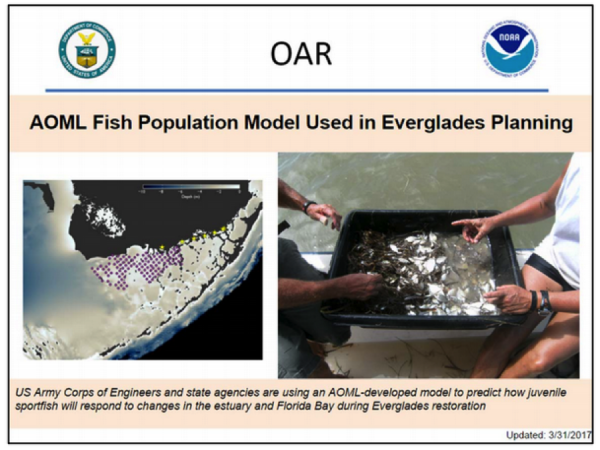 |
● Dr. Ruben van Hooidonk met with staffers from Marco Rubio's office together with the non profits Catalyst Miami and Environment Florida to discuss the importance of climate change to Florida residents and our economy. We discussed the value of FEMA, EPA, NOAA, Sea Grant and other agencies and programs that would see budget cuts under the president's proposed plan. We were met with open ears and the staffers indicated that Rubio is interested in learning more about climate change and sea level rise. .
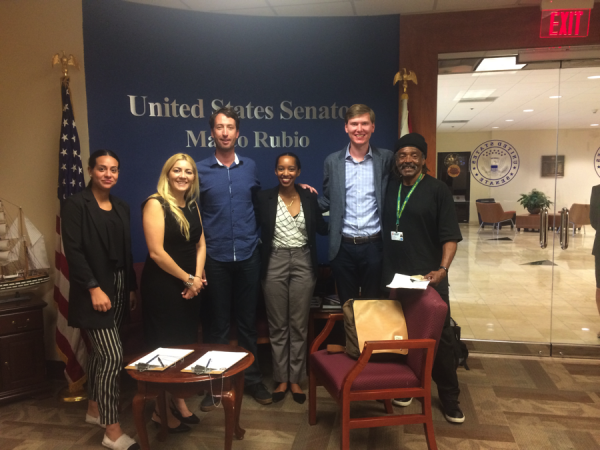 |
Fieldwork
● On Wednesday March 29, OCED's Mike Jankulak, Graham Kolodziej, and Lauren Valentino travelled with Ben Van Dine to Cheeca Rocks offshore of Islamorada. They, 1) worked on troubleshooting a conductivity sensor on the newly refurbished/redeployed MAPCO2 buoy, 2) collected calcification accretion units (CAUS) and bierosion monitoring units (BMUS) as part of NCRMP monitoring, 3) recovered an ADCP and swapped out an EcoPAR sensor, and 4) did a rapid qualitative survey to document any coral disease.
● On Thursday March 30, OCEDs Catalina Aguilar, Ian Enochs, and Paul Jones with RSMAS's Dalton Helsey collected 250 fragments from four different genotypes of the staghorn coral Acropora cervicornis from nursery sites off of Elliot Key. These corals are currently being acclimated in the Future Reef Lab and will be used in an experiment investigating the genomic and physiological response to ocean acidification stress.
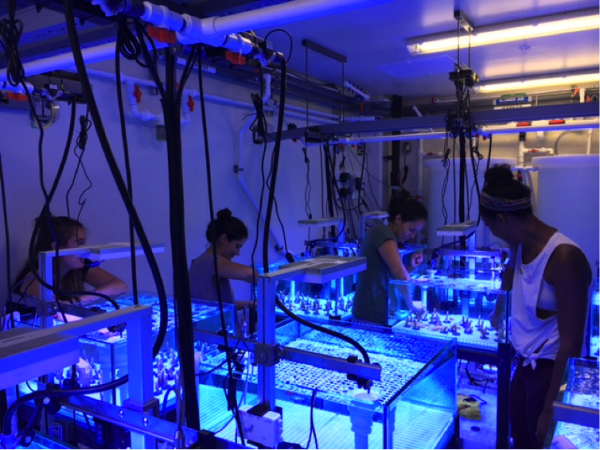 |
March 27, 2017
Reports
● The 2017 Gulf of Mexico Ecosystem Status Report is now available and being rolled out this week at the State of the Gulf of Mexico Summit. The Ecosystem Status Report was written by the Gulf of Mexico Integrated Ecosystem Assessment Team and includes authors from SEFSC, AOML, and NCCOS. AOML co-authors are Dr. Chris Kelble, Charline Quenee, Cristina Carollo, Leticia Barbero, and Neda Trifonova. This is the first update to original ecosystem status report that was released in 2013. The update was revised based on feedback from managers and stakeholder. It reports on the status fewer overall indicators, but includes more indicators for human dimensions and socioeconomics.
Meetings
● Dr. Chris Kelble will be at the State of the Gulf of Mexico Summit followed by the International Research Collaboration workshop both in Houston from March 26-30. Chris will be there to help with the roll-out with the 2017 Gulf of Mexico Ecosystem Status Report by the Gulf of Mexico Integrated Ecosystem Assessment Team. He is also an invited participant in the International Research Collaboration workshop that aims to increase cooperative research between the US and Mexico in the Gulf of Mexico ecosystem.
● Rik Wanninkhof is in London this week to attend the 9th Joint WMO/IOC Commission on Oceanography and Marine Meteorology (JCOMM) ship's observation team (SOT-9) meeting as co-chair and representing the International Ocean Carbon Coordination (IOCCP) and Ships of Opportunity (SOOP) CO2 projects.
● Ian Enochs answered questions at a public screening of "Maug's Caldera: A Natural Laboratory" held at the Deering Estate.
Fieldwork
● Lindsey Visser and Ian Smith will be leading the regular research survey for the South Florida Ecosystem Restoration Research Project aboard the R/V Walton Smith this week from March 27-31. The cruise is conducted to sample water quality, carbon dynamics, plankton dynamics, and biodiversity of south coastal waters.
March 20, 2017
Manuscripts
● The paper entitled "Genotype and Local Environment Dynamically Influence Growth, Disturbance Response and Survivorship in the Threatened Coral, Acropora cervicornis" was accepted for publication in the journal PLoS One. This study used a reciprocal outplanting experiment with 930 corals representing ten genotypes on each of eight reefs to investigate the influence of genotype and the environment on growth and survivorship in the threatened Caribbean staghorn coral, Acropora cervicornis. Site and genotype were the main drivers of growth and survivorship, providing important information on the best genotype and environment combinations that may lead to restoration success.
Manuscript Citation
● SDrury C, Manzello DP, Lirman D (2017). Genotype and Local Environment Dynamically Influence Growth, Disturbance Response and Survivorship in the Threatened Coral, Acropora cervicornis. PLoS One. In Press.
● Dr. Xaymara Serrano is a co-author in a manuscript accepted for publication in the journal Coral Reefs. This paper investigated phylogenetic relationships and patterns of population genetic structure and diversity in three endemic fire coral species occurring in the Brazilian Province (Millepora braziliensis, Millepora nitida, and Millepora laboreli) and one amphi-Atlantic species (Millepora alcicornis), to understand patterns of speciation and biogeography in the genus. The findings reflect the importance of the Amazon–Orinoco Plume and the Mid-Atlantic Barrier as biogeographic barriers, and suggest that, while M. alcicornis is capable of long-distance dispersal, the three endemics have restricted ranges and more limited dispersal capabilities.
Manuscript Citation
● Júlia N. de Souza, Flavia L. D. Nunes, Carla Zilberberg, Juan A. Sanchez, Alvaro E. Migotto, Bert W. Hoeksema, Xaymara M. Serrano, Andrew C. Baker and Alberto Lindner. Endemism and connectivity of fire corals (Millepora spp.) in the tropical Southwestern Atlantic. Coral Reefs. In press.
Reports
● Dr. Jim Hendee and a team of researchers from NOAA, BOEM, EPA, USDA, and NSF have finished the first draft of their chapter, "Marine Resources," as part of the Ocean Research for the Coming Decade, developed for the Subcommittee on Ocean Science and Technology, National Ocean Council.
.Meetings
● Dr. Chris Kelble will be attending the State of the Gulf of Mexico One Gulf Summit and the Gulf of Mexico International Research Workshop next week in Houston, Texas. The Gulf of Mexico Integrated Ecosystem Assessment will be rolling out the first update to their Gulf of Mexico Ecosystem Status Report at the Summit. The Ecosystem Status Report was revised based on user feedback to focus on fewer indicators and integrate ecology and human dimensions indicators.
March 13, 2017
Manuscripts
● OCED co-authors Maribeth Gidley, Ian Enochs, Paul Jones, Kelly Goodwin, and Chris Sinigalliano had a manuscript accepted for publication in Applied and Environmental Microbiology. This paper highlights a Next-Generation-Sequencing study of microbial populations from SE Florida coastal waters, inlets, oceanic treated wastewater outfalls, and coral reefs along the Miami-Dade and Broward coastline. This project was funded by the Coral Reef Conservation Project and conducted in concert with the OCED Numeric Nutrient Criteria Study. This publication reports that microbial contaminants from terrestrial sources such as the coastal inlets and wastewater outfalls can and do reach the actual reef corals and may influence the community structure of reef microbiota, and thus presumably influence the health and resiliency of reef ecosystems.
Manuscript Citation
● Staley, C., Kaiser, T., Gidley, M., Enochs, I, Jones, P., Goodwin, K., Sinigalliano, C., Sadowsky M., Chun, CL. (2017). A Next-Generation Sequencing Approach to Characterize the Impacts of Land-based Sources of Pollution on the Microbiota of Southeast Florida Coral Reefs. Applied Environmental Microbiology. (In Press).
Outreach
● Dr. Kelly Goodwin taught a lecture at the University of California, San Diego entitled "Monitoring Harmful Microbes in the Marine Environment" for course SIO126, Marine Microbiology.
● Dr. Maribeth Gidley is an invited speaker at The Earth Ethics Institute's annual Sustainability and Urban Resiliency Symposium that will take place at Miami Dade College this Thursday, March 16th. Her presentation is entitled - "Human Health and Disease Concerns Associated with Sea-Level Rise and a Changing Climate."
.Meetings
● Dr. Chris Kelble is attending the Marine Biodiversity Observing Network meeting in St. Petersburg this Wednesday through Thursday. The meeting will focus on developing a biodiversity product to support the implementation of UN Sustainable Development Goal 14: Life Below the Seas.
Seminar
● Dr. Neda Trifonova gave a seminar on "Machine-learning approaches for modelling fish population dynamics"
on Monday, March 13 at 10AM in the AOML first floor conference room.
Abstract: Ecosystems consist of complex dynamic interactions among species and the environment, the understanding of
which has implications for predicting the environmental response to changes in climate and biodiversity. With the recent adoption
of more explorative tools, like Bayesian networks, in predictive ecology, fewer assumptions can be made about the data and complex,
spatially varying interactions can be recovered from collected field data and combined with existing knowledge. In this talk,
Bayesian network modelling approaches will be introduced, accounting for latent effects to reveal species dynamics within
geographically different marine ecosystems. The importance of a hidden variable in fish community change studies of this nature
is acknowledged because it allows causes of change which are not purely found within the constrained model structure. A functional
network modelling approach was developed for the region of North Sea that takes into consideration unmeasured latent effects
and spatial autocorrelation to model species interactions and associations with external factors such as climate and fisheries
exploitation. Finally, a modified version of this dynamic Bayesian network model was used to predict the response of different
ecosystem components to change in anthropogenic and environmental factors. Through the development of fisheries catch, temperature
and productivity scenarios, we explore the future of different fish and zooplankton species and examine what trends of fisheries
exploitation and environmental change are potentially beneficial in terms of ecological stability and resilience.
March 6, 2017
Manuscripts
● Dr. Rik Wanninkhof is a co-author on the paper "Calculating surface ocean pCO2 from biogeochemical Argo floats equipped with pH: an uncertainty analysis" that has been accepted by Global Biogeochemical Cycles. The lead author Nancy Williams, was a Holllings Scholar who did her internship at AOML. She is currently finishing her PhD degree at the University of Oregon.
Manuscript Citation
● N. L. Williams, L. W. Juranek, R. A. Feely, K. S. Johnson, J. L. Sarmiento, L. D. Talley, A. G. Dickson, A. R. Gray, R. Wanninkhof, J. L. Russell, S. C. Riser, and Y. Takeshita. In Press. "Calculating surface ocean pCO2 from biogeochemical Argo floats equipped with pH: an uncertainty analysis". Global Biogeochemical Cycles.
Field Work
● OCED's Dr. Ian Enochs and Dr. Derek Manzello are participating on a research cruise to the Galapagos Islands from March 6 to March 14. This research is co-funded by the National Science Foundation, National Geographic, and NOAA's Coral Reef Conservation Program. Dr. Enochs and Dr. Manzello, along with colleagues from UCLA, Columbia University, RSMAS, and the University of the Virgin Islands, will document the health of coral reefs following the recent El Nino warming event, which led to anomalously warm waters in the region. These results will be compared to the response of these same reefs to the strong El Nino's in 1982-83 and 1997-98, which led to significant coral mortality.
Awards
● National Marine Sanctuaries as Sentinel Sites for a Demonstration Marine Biodiversity Observation Network (MBON) led by USF with AOML collaborating is receiving a National Oceanographic Partnership Project (NOPP) Excellence in Partnering award. The Sanctuaries MBON project seeks to provide near real-time information on the status and trends of life in the sea. The project is designed to monitor changes in marine biodiversity in two US National Marine Sanctuaries, including the Florida Keys.
Outreach
● On Thursday, March 9th, Leticia Barbero will participate in "Spaniards at UM: A Research Showcase", an event where the Consul General of Spain will be apprised of some of the research highlights of Spaniards working at the University of Miami. Leticia will talk about her ocean acidification research and the potential impacts of OA on coastal ecosystems.
February 27, 2017
Manuscripts
● Dr. Jia-Zhong Zhang is a co-author of paper entitled "Rapid and intense phosphate desorption kinetics when saltwater intrudes into carbonate rock" which has been accepted for publication in Estuaries and Coasts." This study investigates whether a pristine low-Phosphorus aquifer can desorb significant soluble reactive phosphorus in response to an influx of saltwater. This study used column leaching experiment to investigate phosphate desorption response among different layers within a single aquifer. Because coastal groundwater discharges to overlying estuaries, a better understanding of the intensity and duration of phosphate release is important. This information is valuable to coastal water managers and those engaged in restoration efforts, such as in the Everglades.
● Dr. Chris Kelble is a co-author on a manuscript that was accepted for publication in the inaugural issue of the AGU journal Geohealth. The manuscript merges the EBM-DPSER conceptual model framework Chris and colleagues developed previously with public health frameworks to form a Disaster-Pressure State-Ecosystem Services-Response-Health (DPSERH). This framework is designed to specifically address needs and gaps in disaster planning, recovery, and restoration. This includes being able to provide a more accurate representation of the costs of technological and natural disasters by incorporating not just the effects to ecosystem services, but also how changes in the delivery of ecosystem services affects human health.
Manuscript Citation
● Sandifer, PA, LC Knapp, TK Collier, AL Jones, RP Juster, CR Kelble, RK Kwok, JV Milgarese, LA Palinkas, DE Porter, GI Scott, LM smith, WC Sullivan, AE Sutton-Grier. In Press. A conceptual model to assess stress-associated health effects of multiple ecosystem services degraded by disaster events in the Gulf of Mexico and elsewhere. Geohealth.
Meetings
● Dr. Chris Kelble is attending the National Ecosystem Modeling Workshop (NEMoW) in St. Petersburg, FL on Feb. 28 through March 2. Dr. Kelble is presenting a talk on the use of conceptual models to conduct semi-quantitative trade-off analyses using Fuzzy-logic Cognitive Mapping.
February 21, 2017
Manuscripts
● OCED's Dr. Ian Enochs, Graham Kolodziej, and Dr. Derek Manzello are co-authors on the paper "Plasticity in skeletal characteristics of nursery-raised staghorn coral, Acropora cervicornis" that was accepted for publication in Coral Reefs. This study compared the growth characteristics of the ESA listed staghorn coral, A. cervicornis, when nursery-reared either on blocks attached to substratum or hanging from PVC trees in the water column. The two rearing methods generate the same amount of calcium carbonate skeleton but produce colonies with different skeletal characteristics, and suggest that there is genetically based variability in coral calcification performance. These findings will help guide which outplant sites re most suitable for the different skeletal characteristics; e.g., corals grown on blocks have denser, more robust skeletons and thus are better suited for environments with higher wave energy. This is a collaborative effort between AOML, USGS, and Mote Marine Lab.
Manuscript Citation
● Kuffner IB, Bartels E, Stathakopoulos A, Enochs IC, Kolodziej G, Toth LT, Manzello DP, Plasticity in skeletal characteristics of nursery-raised staghorn coral, Acropora cervicornis. Coral Reefs. In press (2017).
Transitions to Applications
● A performance measure to assess and evaluate the progress and potential of Everglades Restoration to affect estuarine fish communities has been approved by the US Army Corps of Engineers, South Florida Water Management District, and their partners. This performance measure was developed by Dr. Chris Kelble using a Habitat Suitability Index model for juvenile Spotted Seatrout as an indicator for essential fish habitat. It will be used operationally to assess how far Everglades Restoration has gone in restoring estuarine fish habitat and to evaluate how potential Everglades Restoration projects are likely to affect estuarine fish habitat.
Meetings
● Dr. Chris Kelble virtually attended a meeting on integrating risk assessments into UN Sustainable Development Goals, specifically for Goal 14: Life below the sea. Chris presented on how NOAA's IEA program is using risk assessments to inform ecosystem approaches to marine management.
February 13, 2017
Welcome Aboard
● Dr. Catalina Aguilar Hurtado began working in OCED as a CIMAS postdoctoral associate on Feb 2. Dr. Hurtado received her Ph.D. from James Cook University in Australia and will be working with OCED's Ian Enochs and Derek Manzello on the coral omics project. Specifically, she will utilize the Future Reef Lab developed by Ian Enochs to conduct laboratory experiments to understand the genomic basis of resilience to climate change and ocean acidification in endangered coral species. Dr. Hurtado will be sitting in Michael Shoemaker's old office on the second floor.
Meetings
● Dr. Chris Sinigalliano and Dr. Maribeth Gidley presented overviews of AOML research in Environmental Microbiology and Oceans and Human Health research at the "Marine Habitat Restoration, Monitoring, and Coastal Resiliency Symposium" hosted by the Florida Seagrant Program from Feb 7-9 at the University of Florida campus in Davie. Dr. Sinigalliano presented "An Overview of NOAA-AOML Water Quality and Environmental Microbiology Research", and Dr. Gidley presented "Potential Impacts of Sea Level Rise and Climate Change on the Interactions of Oceans and Human Health".
● Dr. Maribeth Gidley gave a presentation on Saturday, Feb 11 as an invited speaker at the University of Miami's "Empowering Capable Climate Communicators Symposium". As part of the University of Miami's Cooper Fellow Training Series, this symposium's purpose is to educate non-scientist members in the community on the science of Climate Change and Sea Level Rise so they are better prepared to communicate these facts to their communites, thus helping improve community resilience. Dr. Gidley's presentation was entitled "Health and Disease Concerns Associated with Sea-Level Rise and a Changing Climate".
February 6, 2017
Meetings
● Dr. Chris Kelble attended the Gulf of Mexico Oil Spill and Ecosystems Conference this week in New Orleans.
● Dr. Rik Wanninkhof attended meetings of the scientific steering committee of the International Ocean Coordination Project (IOCCP), and a meeting on Implementation of Multi-Disciplinary Sustained Ocean Observations (IMSOO) at the Kovens Center of FIU (Feb 6-Feb11)
● Dr. Pamela Fletcher participated in a Sea Grant meeting with members of fisheries interests from the Caribbean. The meeting was led by Dr. Charles Sidman, Associate Director of the Florida Sea Grant College Program and Dr. George Baker, Seafood Specialist with Florida Sea Grant and UF and was held on Jan 27 in Miami. The purpose of the meeting was to continue a dialogue about seafood safety and to share expert knowledge from the Sea Grant College Program with interested organizations.
● Dr. Pamela Fletcher hosted a marine habitat restoration and monitoring and coastal resiliency symposium from Feb 7-9 at the University of Florida campus in Davie. The goal of this symposium is to introduce interested parties to South Florida's diverse ecosystems and some of the unique challenges associated with the region. Drs Maribeth Gidley and Christopher Sinigalliano from CIMAS and AOML will be presenting at the event along with organizations and agencies involved in ecosystem-based management.
● Dr. Pamela Fletcher is coordinating a meeting among the five National Sea Grant laboratory liaisons on February 17th. This is the first time that the NOAA research lab liaisons will meet to share information about themselves and their Sea Grant programming.
● Dr. Pamela Fletcher will lead a discussion among newly hired University of Florida faculty and existing faculty on February 17th at the University of Florida's Tropical Research and Education Center in Homestead. The purpose of the session is to advance our understanding of vulnerabilities related to sea level rise impacts in South Florida and to identify areas for collaboration among researchers in the region. This will be conducted through formal presentations and facilitated discussion.
Field Work
● Chuck Featherstone, Charles Fischer, and Jay Hooper successfully completed GO-SHIP line P18 in Punta Arenas, Chili. The cruise started in San Diego in November and measurements were taken from surface to the deep ocean at nominally 50 km resolution providing a snapshot of changes in physical and biogeochemical properties in this remote section of the South East Pacific compared to the previous occupation in 2008. Congratulations to all for accomplishing such work during such a long and at times troublesome cruise.
Training
● Marc Weekley, Ben Vandine, Derek Manzello, and Jim Hendee (together with SEFSC divers) completed NOAA Diver Training this week.
Proposals
● OCED's scientists submitted proposals in response to the RFP Ocean Technology Development:
➤ Dr. Ian Enoch's proposal to design a low-cost, small autonomous water sampler.
➤ Dr. Jim Hendee's proposal to build and deploy 5000 low-cost Temperature Sensors on coral reefs worldwide.
➤ Dr. Kelly Goodwin's proposal for 'Omics (title undecided at present, with an officially sanctioned delay in submission).
Manscripts
● The following paper has been submitted to Coral Reefs:
Serrano, X; M Miller, J Hendee, B Jensen, C Gapayao, C Pasparakis, M Grosell and A Baker. (submitted). Effects of thermal stress and nitrate enrichment on the larval oxygen consumption, settlement and mortality of two Caribbean reef corals. Coral Reefs.
Visitors
● Dr. Kathy Tedesco of Climate Observations visited AOML on Monday and Tuesday for a review of the XBT program and will have a look at the Ocean Carbon equipment/lab setups.
● Dr. Richard Feely from PMEL visited AOML on Wednesday to meet with members of the Ocean Carbon group.
● Dr. David Legler from Ocean Observations and Modeling was at AOML on Monday to meet with various researchers.
Awards
● Dr. Rik Wanninkhof was selected as Outstanding Reviewer for 2016, "in recognition of the high quality and timeliness of your reviews for Environmental Research Letters.".
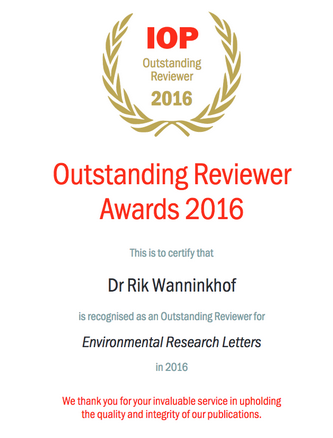 |
January 30, 2017
Meetings
● Rik Wanninkhof is a co-author on two abstracts accepted for presentation at EGU:
➤ Anthropogenic impacts on carbon uptake variability in the subtropical North Atlantic: 1992-2010 by Tobia Tudino et al. resulting from a collaboration with a student Tobia Tudino from Southampton Oceanography Center.
➤ Wind-driven ocean dynamic effects on the contrasting sea-ice trends around West Antarctica by Sang-Ki Lee et al. where San-Ki Lee (AOML) has applied a model to investigate trends of sea ice. The model will be used for investigations of Ocean Acidification.
● Chris Kelble will be presenting an investigation of how Gulf-wide indicators in the Ecosystem Status Report responded to the Deepwater Horizon oil spill and Hurricane Katrina at the Oil Spill and Ecosystems Conference in New Orleans next week.
Field Work
● Charlie Fischer and Chuck Featherstone sampled their last station on January 29th and completed running nutrient and DIC analyses as part of the P-18 cruise. They are due into Punta Arenas on February 3.
January 23, 2017
Meetings
● Chris Kelble is attending the RECOVER science meeting at the South Florida Water Management District Headquarters in West Palm Beach on Monday and Tuesday, Jan. 23 and 24. This meeting aims to review the science done to date to support Everglades Restoration and chart the course for future Everglades Restoration scientific endeavors.
● Dr. Kelly Goodwin participated in a cross-agency meeting on genomics collaborations with a focus on eDNA. The meeting was held at the NOAA National Systematics Lab/Smithsonian Museum of Natural History in Washington DC on 1/19/2017. The attendee list included representatives from NOAA, the Smithsonian, BOEM, Navy, USGS, and NSF.
● Dr. Denis Pierrot and Dr. Rik Wanninkhof will be lead PIs in the review of the surface water CO2 network requested by the Ocean Observation and Monitoring Division (OOMD) of the CPO on Friday January 27.
Field Work
● Lindsey Visser, Charline Quenee, and Nicole Millette will be participating in the South Florida Ecosystem Restoration Research cruise aboard the R/V Walton Smith on Jan. 30-Feb. 3. This cruise monitors the effects of Everglades Restoration on the coastal ecosystem. Sampling is also conducted to investigate carbon dynamics and cycling in the Florida Keys and southwest Florida shelf and to attempt to develop an operational framework for a marine biodiversity observation network in the Florida Keys.
Webinar
● Dr. Leticia Barbero and Dr. Rik Wanninkhof will be presenting the inaugural Gulf of Mexico Coastal Acidification science webinar on January 24, 2017 titled "Ocean Acidification of the Pelagic Gulf of Mexico".
Other News
● Data from the Little Cayman CREWS station was used by the former Science Director, Kristi Foster, of the Little Cayman Research Center in the following publication:
Banks, S. and K. Foster. 2017. Baseline levels of Sidersastrea siderea bleaching under normal environmental conditions in Little Cayman. Open Journal of Marine Science 7: 142-154.
January 17, 2017
Manuscripts
● Leticia Barbero and Rik Wanninkhof co-authored a manuscript accepted for publication in Geophysical Research Letters. The manuscript examined how acidification in coastal water in the Gulf of Mexico was affected by river-driven primary production and respiration. Nutrient inputs from the Mississippi/Atchafalaya River system into the northern Gulf of Mexico promote high phytoplankton production and lead to high respiration rates associated with algal decomposition. Respiration coupled with water column stratification results in seasonal summer hypoxia in bottom waters on the Louisiana Shelf. In addition to consuming oxygen, respiration produces dissolved inorganic carbon (DIC), thus lowering the pH and acidifying bottom waters. Here we present a high-resolution biogeochemical model simulating this eutrophication-driven acidification and investigate the dominant underlying processes. The model shows the recurring development of an extended area of acidified bottom waters in summer on the Louisiana Shelf that coincides with hypoxic waters. Acidified waters are constrained to the bottom boundary layer; in this layer the production of DIC by benthic metabolic processes is dominant. Despite a reduced saturation state, acidified waters remain supersaturated with respect to aragonite.
Manuscript Citation
● Enhanced macroboring and depressed calcification drive net dissolution at high-CO2 coral reefs. Ian C. Enochs, Derek P. Manzello, Graham Kolodziej, Sam H. C. Noonan, Lauren Valentino, Katharina E. Fabricius. Proc. R. Soc. B 2016 283 20161742; DOI: 10.1098/rspb.2016.1742. Published 16 November 2016.
Field Work
● Charlie Fischer and Chuck Featherstone continue onboard R/V Ron Brown running nutrient and DIC analyses as part of the P-18 cruise.
Seminars
● Nicole Millette, a new post-doc in OCED, will be giving the following seminar next Thursday, January 26 at 10AM in the AOML first floor seminar room.
Title: Ecosystem Impact of Winter Dinoflagellate Blooms in the Chesapeake Bay
Abstract: Winter dinoflagellate blooms are a common occurrence in temperate estuaries but there is a lack of research on the ecology of these blooms. Through a combination of laboratory and field-based experiments and modeling I describe how and why winter blooms form and what their impact is on the winter and spring ecosystems. Below average winter temperature increases the chance of a dinoflagellate bloom forming; these blooms decrease the mortality rate of copepod nauplii hatched in winter. Simultaneously, below average winter temperatures decrease the developmental rate of copepod nauplii hatched in winter, which cause peak copepodite abundance to occur later in spring. Anadromous fish larvae that hatch in spring will feed on these copepodites that were originally hatched in winter, and a later spring peak of high copepodite abundance results in higher annual fish recruitment.
January 9, 2017
Welcome Aboard
● Dr. Neda Trifonova is starting with OCED today. She is a post-doc with CIMAS working primarily on the Gulf of Mexico Integrated Ecosystem Assessment. Dr. Trifonova got her Ph.D. from Brunel University in London. Her dissertation was on "Machine Learning Approaches for Modelling Fish Population Data." She will be located in the office withCharline Quenee in the second floor back hallway. Please stop by and introduce yourself and welcome her to OCED.
Field Work
● Charlie Fischer and Chuck Featherstone continue onboard R/V Ron Brown running nutrient and DIC analyses as part of the P-18 cruise.
December 5, 2016
Manuscripts
● Chris Kelble is a co-author on a manuscript entitled "An ecosystem-based approach to marine risk assessment" that was accepted for publication in Ecosystem Health and Sustainability. The article presents a framework for organizing ecosystem risk assessments from the simplest least complex, single ecosystem component, single stressor, and no interactions to the most complex, fully quantitative risk assessment that accounts for the plethora of ecosystsem interactions with all ecosystem stressors and all ecosystem components. This framework will help scientists undertaking ecosystem risk assessments understand what type of risk assessment is required for the type of ecosystem management policymaking process they are attempting to inform.
Field Work
● Divers and researchers from AOML will be collecting samples for the Marine Biodiversity Observing Network (MBON) for the Florida Keys National Marine Sanctuary this week from December 5-7. They will be collecting water, sediments, and coral tissue samples that will be used for molecular analysis of microbial biodiversity by AOML microbiology researchers. This work, as part of AOML Coral Genomic Observing Network (CGON) is characterizing the microbial community structure and biodiversity of coral reef microbiomes in the Florida Keys as part of a larger MBON effort to document biodiversity across trophic levels in the marine sanctuary. This project uses a variety of both traditional and state-of-the-art molecular tools such as Next-Generation-Sequencing (NGS) and molecular microbial source tracking to better characterize overall coral reef community structure and health trends. This is an on-going program that samples bi-monthly in the Florida Keys, sampling critical sentinel coral reef sites at Molasses Reef, Cheecha Rocks Reef, Tenessee Reef, Sombrero Reef, Looe Key Reef, and Western Sambo Reef This CGON component of the larger FKNMS MBON program is conducted by AOML in collaboration with partners from the University of South Florida and the Florida Keys National Marine Sanctuary.
Meetings
● Chris Kelble is presenting a talk entitled "Investigating the Resiliency of Ecosystem Services to Climate Change in South Florida Coastal Ecosystems" at the A Community on Ecosystem Services conference in Jacksonville, Florida on December 8.
Seminars
● Please join us for a special two part seminar on Wednesday, December 7th at 10AM by Drs. Anna Linhoss and Steve Ashby. Anna Linhoss and Steve Ashby are visiting OCED from Mississippi State University to hold a kick-off meeting for the joint AOML/Northern Gulf Institute Biscayne Bay water quality project. Steve Ashby will give a talk entitled "An overview of research at the Northern Gulf Institute" followed by Ann Linhoss' talk on "Hydrodynamic and water quality modeling for determining oyster habitat suitability."
Awards Ceremony and Town Hall
● OAR Administrator Craig McLean will hold a town hall meeting in the AOML Lobby on Thursday, Dec. 8th at 1:30PM. At the beginning of the town hall, there will be the AOML Awards Ceremony.
November 21, 2016
Manuscripts
● Ian Enochs, Derek Manzello, Graham Kolodziej, and Lauren Valentino published a paper entitled "Enhanced macroboring and depressed calcification drive net dissolution at high-CO2 coral reefs" in Proceedings of the Royal Society B: Biological Sciences. Their research showed that ocean acidification simultaneously slows down habitat growth and accelerates bioerosion. The paper was a collaboration with the Australian Institute of Marine Science and was conducted at volcanically acidified coral reefs in Papua New Guinea. The paper may be found at: http://rspb.royalsocietypublishing.org/content/283/1842/20161742.
Manuscript Citation
● Enhanced macroboring and depressed calcification drive net dissolution at high-CO2 coral reefs. Ian C. Enochs, Derek P. Manzello, Graham Kolodziej, Sam H. C. Noonan, Lauren Valentino, Katharina E. Fabricius. Proc. R. Soc. B 2016 283 20161742; DOI: 10.1098/rspb.2016.1742. Published 16 November 2016.
Meetings
● Ian Enochs presented an invited talk at the University of Oregon. His talk focused on research conducted using naturally high CO2 environments to investigate complex responses of reef ecosystems to ocean acidification stress.
Other News
● Chris Kelble accepted a 3-year appointment to the editorial board of the Bulletin of Marine Science as an Associate Editor.
November 28, 2016
Welcome Aboard
● Dr. Nicole Millette started her position today as a post-doc in OCED. Dr. Millette is an NGI post-doc funded through Mississippi State University working on water quality investigations of Biscayne Bay. Here initial focus will be on analyzing already existing data on nutrients, chlorophyll a, and other water quality parameters in Biscayne Bay. She will be sitting in the post-doc office with Xaymarra.
Manuscripts
● The manuscript "Local-scale projections of coral reef futures and implications of the Paris Agreement" has been accepted for publication in Nature Scientific Reports. In it we show high-resolution projections of coral bleaching, generated by statistically downscaling projections to 4-km resolution for all coral reefs; these projections reveal high local-scale variation in the onset of annual severe bleaching (ASB). Timing of ASB varies >10 years in 71 of the 87 countries and territories with >500km2 of reef area. Emissions scenario RCP4.5 represents lower emissions mid-century than will eventuate if pledges made following the 2015 Paris Climate Change Conference (COP21) become reality. These pledges do little to provide reefs with more time to adapt and acclimate prior to severe bleaching conditions occurring annually. RCP4.5 adds 11 years to the global average ASB timing when compared to RCP8.5; however, >75% of reefs still experience ASB before 2070 under RCP4.5. Coral reef futures clearly vary greatly among and within countries, indicating the projections warrant consideration in most reef areas during conservation and management planning.
Manuscript Citation
● Ruben van Hooidonk, Jeffrey Maynard, Jerker Tamelander, Jamison Gove, Gabby Ahmadia, Laurie raymundo, Gareth Williams, Scott Heron, Serge Planes. Accepted. Local-scale projections of coral reef futures and implications of the Paris Agreement. Nature Scientific Reports.
November 14, 2016
Field Work
● Lindsey Visser, Ben VanDine, and Charline Quenee will be participating in the South Florida Project cruise aboard the R/V Walton Smith from November 14 through November 18. These cruises aim to assess, evaluate, and predict the response of South Florida's coastal ecosystem to Everglades restoration activities. They are undertaken in conjunction with the Marine Biodiversity Observing Networkn (MBON) study that includes partners at USF and the Florida Keys National Marine Sanctuary. The MBON study will include taking genetic samples of coral and their microbiome.
Meetings
● Chris Kelble is attending a Pew sponsored workshop at RSMAS on Monday, November 14 entitled "Biscayne Bay workshop: Linking global research to South Florida."
● Charline Quenee, Chris Kelble, and Pamela Fletcher will be running their fourth and final workshop for their Coastal Ocean and Climate Applications sponsored grant to investigate ecosystem service resiliency in south Florida. This workshop will be focused upon Florida Bay.
November 7, 2016
Field Work
● Bob Castle and Charlie Fischer depart on the GO-SHIP P18 Cruise aboard R/V BROWN on Monday, November 7.
● Lindsey Visser, Ben VanDine, and Chris Kelble will be conducting the seventh survey of juvenile sportfish in Florida Bay for 2016. Sampling usually ends in October, but priori modeling efforts have shown that if water temperatures remain over 20C, there is still the potential to observe juvenile spotted seatrout. This survey will help us better understand how juvenile spotted seatrout are responding to the disturbances observed in Florida Bay over the past year, which included a seagrass die-off last year and currently is dominated by a large cyanobacterial bloom.
Meetings
● Pamela Fletcher is attending the Gulf and Caribbean Fisheries Institute meeting in Granda Cayman this week.
October 31, 2016
Meetings
● Chris Sinigalliano will be presenting results of the CRCP-funded research on coral reef metagenomics and microbial source tracking of Land-Based Sources of Pollution (LBSP) influencing microbiota of Southeast Florida reefs at the upcoming Southeast Florida Coral Reef Initiative Technical Advisory Committee Meeting (SEFCRI TAC) at Nova Southeastern University's Oceanographic Center on the morning of Wednesday November 2nd.
● The ocean carbon group hosted three representatives from Aanderaa instruments (Norway) on Wednesday, Oct. 26. Dr. Anders Tengberg gave a presentation titled "Multi-Parameter Observations from Surface Waters to the Deep Sea" that was an overview of scientific results from their autonomous oxygen, CO2, conductivity and temperature sensors on a variety of novel platforms. Discussions on current and future applications of their instruments, including beta testing, for AOML's observing networks proved fruitful.
Future Work
● If you have any potential project ideas that you feel should be funded by RESTORE bucket 2 funding, please submit them to Chris Kelble by Thursday, November 3. The goal of this funding opportunity is to conduct work under at least one of the four Goals of the RESTORE Act (Restore and Conserve Habitat, Restore Water Quality, Replenish and Protect Living Coastal and Marine Resources, and Enhance Community Resilience). It will consider projects or programs that:
- Provide the greatest contribution to restoring and protecting natural resources, ecosystems, fisheries, marine and wildlife habitat, beaches, and coastal wetlands
- Are Large Scale projects or programs
- Build upon existing restoration plans or programs
- Restore the long-term resilience to areas most impacted by the Deep Water Horizon oil spill
If you want any further information, please follow up with Chris Kelble.
October 24, 2016
Manuscript
● Jia-Zhong Zhang is the co-author on a manuscript entitled "Variability in sinking fluxes and composition of particle-bound phosphorus in the Xisha area of the northern South China Sea" that was accepted for publication in Deep-Sea Research. Export flux of phosphorus by sinking particles are important in studying ocean biogeochemical cycles but such study is lacking in the global ocean. This study analyzed two-year sediment trap samples colleted at a mooring station in South China Sea. Five particulate P forms including loosely-bound P, Fe-bound P, CaCO3-bound P, detrital apatite P, and refractory organic P were quantified by a sequential extraction method. Results revealed substantial variability in sinking particulate P composition over two years of samplings. Increase of CaCO3-bound P in sinking particles during 2014 was related to a strong El Niño event with enhanced CaCO3 deposition in the surface ocean. A significant correlation between integrated primary productivity in the region and particle fluxes at the station suggested the important role of biological production in controlling the concentration, composition, and export fluxes of sinking particulate P.
Manuscript Citations
● HDon Y, Li Q, Wu Z, and Zhang JZ. Variability in sinking fluxes and composition of particle-bound phosphorus in the Xisha area of the northern South China Sea". Deep-Sea Research Part I. Accepted.
● A paper comparing carbon dynamics in two adjacent estuaries in India has been accepted for publication in Geophysical Research Letters. The research by Akhand et al. with Wanninkhof as co-author showed carbon fluxes from the marine dominated Matla Estuary to be significantly lower than most other mangrove estuaries studied to date. The river dominated Hugli estuary has seen a six-fold increase in carbon outgassing over the last several decades due to anthropogenic influences. The study provides valuable insights in the poorly studied estuaries in the Northern Bay of Bengal and will be critical in assessment of the Blue Carbon sequestration potential in these regions.
Manuscript Citation
● Akhand, A., A. Chanda, S. Manna, S. Das, S. Hazra, R. Roy, S. B. Choudhury, K. H. Rao, V. K. Dadhwal, K. Chakraborty, K. M. G. Mostofa, T. Tokoro, T. Kuwae and R. Wanninkhof (2016). "A comparison of CO2 dynamics and air-water fluxes in a river-dominated estuary and a mangrove-dominated marine estuary." Geophys. Res. Let. Accepted.
Funding
● FY17 MBON funds will again be allocated to AOML to support the following projects within OCED: [1] Year 2 data collection for Coral Metagenomics work (Dr. Chris Sinigalliano) and Pelagic Primary Productivity work (Dr. Chris Kelble). [2] AOML team member engagement with and support for product development (request is for staff time to participate in meetings, discussions, etc). This will support the second and final year of data collection. For the product development component, Frank Muller Karger's team at USF is taking the lead for this activity however there is a need for strategic engagement by ONMS, FKNMS and other partners (AOML) to help provide data/information and creative vision for what is needed, how best to present the information and to what audiences.
Future Work
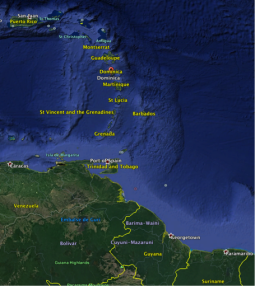
● The Caribbean Community Climate Change Center (5Cs) has received $1.4M for the maintenance of the existing CREWS/5Cs network of stations (Belize, Barbados, Dominican Republic, and Trinidad & Tobago), plus the addition of stations in at least these countries: St Lucia, Antigua, Dominica, and Guyana/Suriname. AOML/CHAMP is being tasked with the planning and implementation of this project for the operation, and also through funding from the Coral Reef Conservation Program. The team will consist of Mike Jankulak, Joe Bishop, Natchanon Amornthammarong, Lew Gramer, Pamela Fletcher (Sea Grant), and Jim Hendee from AOML, and will most likely involve Environmental Moorings International, Inc.
October 17, 2016
Manuscripts
● Chris Kelble is a co-author on a manuscript accepted for publication in ICES Journal of Marine Science. The manuscript entitled “Implementing “the IEA”: using integrated ecosystem assessment frameworks, programs, and applications in support of operationalizing ecosystem-based management” aims to clearly define all aspects of NOAA's Integrated Ecosystem Assessment (IEA) efforts and propose an evolution in IEA. This evolution is to move from a single IEA in each large marine ecosystem to an approach where multiple IEAs are concurrently undertaken within a large marine ecosystem; each designed and tailored to meet the needs of specific management partner(s). The multiple IEAs would provide consistent results throughout the large marine ecosystem, but with each producing products of the appropriate geographic and complexity scale to meet resource management needs.
Manuscript Citation
● Harvey CJ, Kelble CR, Schwing FB. 2016. Implementing "the IEA": using integrated ecosystem assessment frameworks, programs, and applications in support of operationalizing ecosystem-based management. ICES Journal of Marine Science.
Welcome
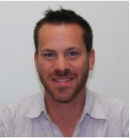
● Bioinformatician Dr. Luke Thomspon recently joined AOML's 'omics efforts, working with Dr. Kelly Goodwin. Luke is working for NOAA on a variety of projects via the NGI Cooperative Institute, starting with analysis of data from the global Ocean Sampling Day effort. He comes to NOAA from the renowned Knight laboratory and is lead on producing the first manuscript from the Earth Microbiome Project.
Meetings
Kelly Goodwin attended a two day workshop of analysis of metagenomics data held at the Scripps Institute of Oceanography.
October 11, 2016
Congratulations
● Xaymara Serrano welcomed a baby girl, Valeria Isabel Torres Serrano, on September 23 at 5:05 pm. She weighed 6 pounds and 12 ounces and measured 19.5 inches. Both mom and daughter are healthy and very happy!
Field Work
● OCED's Dr. Ian Enochs and Dr. Derek Manzello are participating on a research cruise in Papua New Guinea from October 16-26. Dr. Enochs and Dr. Manzello are working with collaborator Katharina Fabricius from the Australian Institute of Marine Science to document newly discovered volcanic CO2 seeps near Manus Island, Papua New Guinea. The findings from these new sites will be compared to other CO2 seeps in Papua New Guinea, Japan, and the recent work by Enochs at Maug in the Mariana Islands to better understand the ecosystem impacts of ocean acidification to coral reefs.
 |
● Lindsey Visser is conducting a survey of juvenile sportfish survey in Florida Bay from October 8-12.
Meetings
● Chris Sinigalliano and Maribeth Gidley will be presenting their coral metagenomic research from the NOAA Coral Reef Conservation Program at the upcoming Florida Branch American Society for Microbiology Meeting on Oct 15-16 in Miami, FL. The title of their presentation is: "Pilot Study for a NOAA Coral Genomic Observing Network: Metagenomic Characterization of Coral Reef Microbiota in Southeast Florida, and Exposure to Land-Based Sources of Pollution". In addition, their former student intern, Kristina Thoren, will also be presenting her NOAA internship research at this Florida Branch ASM meeting in Miami. Her poster is entitled: "A MST Approach to Investigate Fecal Indicator Bacteria in Bioaerosols and Bathing Water".
● Pamela Fletcher will participate in Sea Grant Week in Newport, Rhode Island. The event brings together a network of Sea Grant staff from around the country to share ideas, information and updates on administrative activities. AOML's retired Deputy Direct, Judy Gray should be in attendance as a member of the National Sea Grant Advisory Board.
October 3, 2016
Manuscripts
● Ruben van Hooidonk co authored a manuscript that has been accepted for publication in PLOS ONE. In the article "Coral Reefs and People in a High-CO2 World: Where Can Science Make a Difference to People?". Dr. Hooidonk and colleagues suggest that by 2050, Western Mexico, Micronesia, Indonesia, parts of Australia and Southeast Asia will bear the brunt of rising temperatures. Reef damage will result in lost fish habitats and shoreline protection, thereby jeopardizing the lives and economic prosperity of people who depend on reefs for tourism and food. The study shows how people and coral reefs are affected by a high-CO2 future and suggests pathways to cope with the impacts. Human dependence was mapped at the country level, scoring for two indicators: shoreline protection and coral reef fisheries. Simultaneously, the authors mapped the largely unavoidable impacts of increased sea surface temperature and ocean acidification. Using data from the maps, the study predicts that the countries of Oceania will be among the first to face the greatest environmental stresses from climate change and ocean acidification, followed by the Coral Triangle countries of Southeast Asia and other parts of Australia -- all areas with high dependence on coral reefs. Countries most likely to experience severe ocean acidification are generally different from those that will experience the earliest onset of coral bleaching. Acidification is projected to be worse for Baja California (Mexico), Japan, China, and southern Australia because they are at the upper and lower latitudinal bounds of coral reef distribution and thus generally in cooler waters that naturally carry more CO2.
Manuscript Citation
● CLinwood Pendleton, Adrien Comte, Chris Langdon, Julia Ekstrom, Sarah Cooley, Lisa Suatoni, Mike Beck, Luke Brander, Lauretta Burke, Josh Cinner, Carolyn Doherty, Peter Edwards, Dwight Gledhill, Liqing Jiang, Rosimeiry Portela, Ruben van Hooidonk, Louise Teh, George Waldbusser. In Press. CORAL REEFS AND PEOPLE IN A HIGH-CO2 WORLD: Where can science make a difference to people? PLoS One.
Field Work
● Lindsey Visser and Charline Quenee completed a survey of Florida Bay last week to investigate a potential bloom and ecological consequences. Unfortunately, they found evidence of a phytoplankton bloom (likely cyanobacteria) in north-central and south-central Florida Bay. There was also a sponge die-off observed between Gopher Keys and Crab Keys (25 58.936 North, 80 44.265 West). They counted over 50 sponges floating at the surface driving through the area.
September 26, 2016
Manuscripts
● Chris Kelble was a co-author on a manuscript accepted for publication in ICES Journal of Marine Science. The manuscript is entitled "Moving from Ecosystem-based policy objectives to operational implementation of ecosystem-based management measures." Political scientists and ecologists from North America and Europe wrote the manuscript to highlight one of the key hurdles to implementing Ecosystem Based Management (EBM) for coastal and marine ecosystems on both continents. The authors note that there are numerous planning initiatives for coastal and marine EBM on both continents, but these plans never result in management measures/actions to implement them. The manuscripts argues that by using a policy process that incorporates scientists, managers, and politicians in consultation with stakeholders to move from strategic goals to tactical objectives to sectoral management measures we can advance our ability to implement coastal and Marine EBM.
Manuscript Citation
● Cormier, R, C R Kelble, J I Allen, M R Anderson, A Grehan, O Gregerson. In Press. Moving from Ecosystem-based policy objectives to operational implementation of ecosystem-based management measures. ICES Journal of Marine Science.
Field Work
● Lindsey Visser and Charline Quenee will run a cruise sampling water quality in Florida Bay. This cruise is being undertaken at the request of Everglades National Park. There is concern that a significant algal bloom may be initiating in north-central Florida Bay in the same location as the seagrass die-off that occurred last summer.
Meetings
● Kelly Goodwin and personnel from SWFSC attended planning meetings for the "eAUV" and "NCOG" 'omics projects in Monterey, meeting with MBARI and the SWFSC Ecosystem Research Division collaborators. Talks included coordination of deployment of the 3G ESP/LRAUV with ship operations and moving 'omic-derived indices into Integrated Ecosystem Assessment (IEA) models.
● Leticia Barbero and Rik Wanninkhof are attending a workshop in Raleigh NC with collaborators of their NASA funded project on carbon synthesis in the Gulf of Mexico hosted by Dr. Ruoying He of NC State. As part of the project the ocean carbon group of AOML will provide a comprehensive data based air-sea CO2 flux estimate of the region utilizing the extensive data obtained over the past 8-years. A large amount of the data was obtained from ships operated by the ocean carbon group including NOAA ships R/V Gorden Gunter, R/V RH Brown, and methanol carrier Las Cuevas with funding of the climate observation division and the Northern Gulf Institute.
● Pamela Fletcher will be attending the Extension Professionals Association of Florida meeting next week in Daytona Beach, Florida.
September 19, 2016
Manuscripts
● The following manuscript was published in Earth Science Data that includes all members of the ocean carbon group as co-authors. The Surface water CO2 Atlas (SOCAT) is an international community effort under auspices of IOCCP and with strong involvement of the NOAA labs PMEL and AOML. SOCAT provides annual updates of global quality controlled compilations of surface water CO2 levels. AOML was the single largest contributor of data to version 4 which was released in August, 2016: A multi-decade record of high-quality fCO2 data in version 3 of the Surface Ocean CO2 Atlas (SOCAT). Dorothee C. E. Bakker, Benjamin Pfeil, Camilla S. Landa, Nicolas Metzl, Kevin M. O'Brien, Are Olsen, Karl Smith, Cathy Cosca, Sumiko Harasawa, Stephen D. Jones, Shin-ichiro Nakaoka, Yukihiro Nojiri, Ute Schuster, Tobias Steinhoff, Colm Sweeney, Taro Takahashi, Bronte Tilbrook, Chisato Wada, Rik Wanninkhof, Simone R. Alin, Carlos F. Balestrini, Leticia Barbero, Nicholas R. Bates, Alejandro A. Bianchi, Frederic Bonou, Jacqueline Boutin, Yann Bozec, Eugene F. Burger, Wei-Jun Cai, Robert D. Castle, Liqi Chen, Melissa Chierici, Kim Currie, Wiley Evans, Charles Featherstone, Richard A. Feely, Agneta Fransson, Catherine Goyet, Naomi Greenwood, Luke Gregor, Steven Hankin, Nick J. Hardman-Mountford, Jerome Harlay, Judith Hauck, Mario Hoppema, Matthew P. Humphreys, Christopher W. Hunt, Betty Huss, J. Severino P. Ibanhez, Truls Johannessen, Ralph Keeling, Vassilis Kitidis, Arne Kortzinger, Alex Kozyr, Evangelia Krasakopoulou, Akira Kuwata, Peter Landschutzer, Siv K. Lauvset, Nathalie Lefevre, Claire Lo Monaco, Ansley Manke, Jeremy T. Mathis, Liliane Merlivat, Frank J. Millero, Pedro M. S. Monteiro, David R. Munro, Akihiko Murata, Timothy Newberger, Abdirahman M. Omar, Tsuneo Ono, Kristina Paterson, David Pearce, Denis Pierrot, Lisa L. Robbins, Shu Saito, Joe Salisbury, Reiner Schlitzer, Bernd Schneider, Roland Schweitzer, Rainer Sieger, Ingunn Skjelvan, Kevin F. Sullivan, Stewart C. Sutherland, Adrienne J. Sutton, Kazuaki Tadokoro, Maciej Telszewski, Matthias Tuma, Steven M. A. C. van Heuven, Doug Vandemark, Brian Ward, Andrew J. Watson, and Suqing Xu. Earth Syst. Sci. Data, 8, 383-413, doi:10.5194/essd-8-383-2016, 2016.
Field Work
● Lindsey Visser, Ben Van Dine, and Grant Rawson are leading the latest cruise investigating water quality and biological oceanography in South Florida's coastal waters aboard the R/V Walton Smith.
Outreach
● On Friday, September 16, Dr. Chris Kelble participated in "A Day on the Bay" event in Biscayne Bay:
(http://www.adayonbiscaynebay.org/). Miami Waterkeeper and UF/IFAS Sea Grant Extension hosted
the 3-hour boat tour to highlight Biscayne Bay's history, value, and current threats to local leaders. Dr. Kelble discussed eutrophication
threats to Biscayne Bay and the NOAA Habitat Focus Area initiative. This event was funded by the NOAA Biscayne Bay Habitat Focus Area Federal
Funding Opportunity.
Meetings
● Dr. Leticia Barbero is attending a DFO/NOAA meeting on ocean acidification in Saint Andrew's, NB (Canada) co-hosted by Fisheries and Oceans Canada (DFO) and NOAA OAP. The purpose of the meeting is to discuss common areas of interest with respect to ocean acidification. This will include sharing updates on research into biological impacts of OA, especially on commercial species of shared interest; identifying shared research gaps and future collaborations; establishing a coordination mechanism for current and future ocean/coastal OA observing in the Atlantic, Pacific, and Arctic, and developing a Coordination Framework for DFO-NOAA Efforts into the future.
● On Tuesday, September 20th Dr. Pamela Fletcher will be presenting an overview of her resource management extension education and engagement activities to Florida Atlantic University's students and faculty. FAU was awarded funding support from Florida Sea Grant funding for their ADAPT: Adaptation Design and Planning Tool for Urban Areas in the Coastal Zone. ADAPT will produce a resilient coastal urbanism tool called ADaPT (Adaptation Design and Planning Tool) to addresses opportunities for low impact development and green infrastructure technologies at lot, street and neighborhood scales. This will result in a manual that offers a design framework for adaptation action areas at appropriate scales for coastal community land-use planning, with a pilot application for the City of Ft. Lauderdale.
● On Tuesday, September 20th Dr. Pamela Fletcher will present an overview of her liaison position to the Broward County Extension Education office to identify areas for collaboration with the county extension office related to climate change/sea level rise impacts.
● On Thursday, September 22, Dr. Pamela Fletcher will meet with business leaders from Broward County to begin a dialogue for addressing climate change impacts in the region. The discussion will be a continuation of many ideas and opportunities outlined during the May 2016 Climate Summit held in Fort Lauderdale.
September 12, 2016
Manuscripts
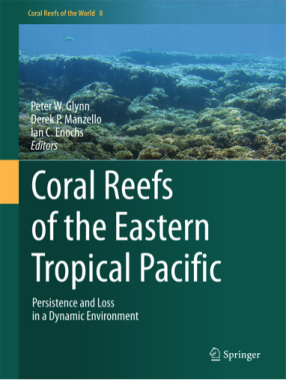
● The book entitled "Coral Reefs of the Eastern Tropical Pacific: Persistence and Loss in a Dynamic Environment" was published by Springer. OCED's Derek Manzello and Ian Enochs were editors of the book. This book is volume 8 of the Springer series "Coral Reefs of the World". Manzello authored one chapter, while Enochs' authored two and was a co-author on another.
Book Citation
● Glynn PW, Manzello DP, Enochs IC [eds] (2016). Coral Reefs of the Eastern Tropical Pacific: Persistence and Loss in a Dynamic Environment. Springer. 655 p.
Chapter Citations
● J Cortes, Enochs I, et al. (2016). Marine biodiversity of eastern tropical Pacific coral reefs. In: P.W. Glynn, Manzello, D.P., Enochs, I.C. (eds.). Coral reefs of the eastern tropical Pacific: Persistence and loss in a dynamic environment. Springer.
● Enochs I, Glynn PW (2016). Corallivory in the eastern Pacific. In: P.W. Glynn, Manzello, D.P., Enochs, I.C. (eds.), Coral reefs of the eastern tropical Pacific: Persistence and loss in a dynamic environment. Springer.
● Enochs I, Glynn PW (2016) Trophodynamics of eastern Pacific coral reefs. In: P.W. Glynn, Manzello, D.P., Enochs, I.C. (eds.), Coral reefs of the eastern tropical Pacific: Persistence and loss in a dynamic environment. Springer.
● Manzello DP, Eakin CM, Glynn PW (2016). Effects of Global Warming and Ocean Acidification on Carbonate Budgets of Eastern Pacific Coral Reefs. In: Glynn PW, Manzello DP, Enochs IC (eds), Coral Reefs of the Eastern Tropical Pacific: Persistence and Loss in a Dynamic Environment. Springer, p 517-533.
Outreach
● Dr. Ian Enochs gave a public talk at "Nerd Nite", held at Gramps in Wynwood. More than 130 people were in attendance.
August 29, 2016
Manuscripts
● The following paper is in press: "Watershed assessment with beach microbial source tracking and outcomes of resulting gull management." K.D. Goodwin, S. Gruber, M. Vondrak, A. Crumpacker. Environmental Science and Techchnology, (2016), http://pubs.acs.org/doi/abs/10.1021/acs.est.6b02564. This paper describes a Research-to-Application (R2A) example for two Microbial Source Tracking (MST) assays developed by AOML that identify contamination from gull and canine fecal sources. AOML PIs Dr. Kelly Goodwin and Dr. Christopher Sinigalliano received a Technology Transfer Award in 2012 for such efforts. Total Maximum Daily Loads (TMDLs) are a regulatory consequence for chronic failure to meet water quality standards. TMDL implementation to remediate impaired water quality is a $3B problem for the US annually. At this site, prior remediation efforts were unsuccessful, despite an infrastructure investment of $3M to construct a facility to UV-treat watershed run-off before entering the ocean. In contrast, application of the AOML-developed test for gull fecal contamination provided actionable information that led to successful management action. The management action used was relatively inexpensive employment of falcons to deter gulls from the swimming beach, and this appears to be the first report of falconry used in the context of a bacteria TMDL.
Field Work
● Dr. Christopher Kelble will be participating in the juvenile sportfish survey in Florida Bay from September 3-6. This project is collecting vital information on how Florida Bay's faunal community is responding to last year's seagrass dieoff.
Meetings
● Dr. Kelly Goodwin will provide a presentation on 'Omics at the NMFS-OAR Bilateral meeting on August 30 at the Northeast Fisheries Science Center in Sand Hook, NJ.
Employment
● In a joint effort with the Northern Gulf Institute we are searching for a post-doc through Dr. Anna Linhoss at Mississippi State University. The successful candidate will be stationed at AOML and advised by Dr. Chris Kelble. We are looking for someone with a background in nutrient and phytoplankton dynamics and strong statistical skills. The first part of the research will be analyzing the long-term water quality data sets we have collected in South Florida and then building a research effort from that analysis which will help advance the Biscayne Bay Habitat Focus Area. If you know of any potential candidates, they should send 1) cover letter, 2) CV, and 3) list of three references to Dr. Anna Linhoss, alinhoss@abe.msstate.edu. They can also contact Dr. Chris Kelble, Chris.Kelble@noaa.gov.
August 22, 2016
Outreach
● The Coral Genomics Observing Network has launched a web presence on the web site: http://www.coral.noaa.gov/cgon. This network intends to establish observatories in critical coral reef ecosystems for meta-'omic characterization of community DNA and RNA for functional and taxonomic genes of both coral and its holobiont microbiomes. Over time this web presence is expected to grow as the research team adds more details about their work and bios of the team members (Kelly Goodwin, Chris Sinigalliano, Maribeth Gidley, Jim Hendee).
News
● The R/V Hildebrand, which served OCED well since 8/26/2009, sailed away under new ownership last Friday. She will be missed but not forgotten. If you would like to have input on the new R/V(s) please let Joe Bishop know.
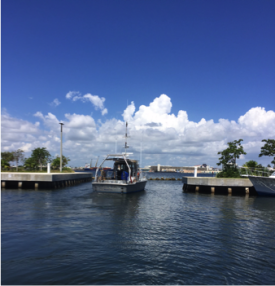 |
New Investigations
● OCED's Director Dr. Jim Hendee has opened negotiations with Daniel Fernando of the Manta Trust (http://www.mantatrust.org/), Nishan Perera of Blue Resources (http://www.blueresources.org/), and Carrie Manfrino of the Central Caribbean Marine Institute (http://reefresearch.org/) for the installation of a CREWS station in Sri Lanka, and also possibly the Chagos Marine Protected Area, in the Indian Ocean. This is a long-range project that will likely be a couple of years to implementation.
● Marc Weekly picked up coral skeletons from the University of Florida Tropical Aquaculture Laboratory in Ruskin Florida. The skeletons were part of a seized shipment of endangered Elkhorn coral. They will be used as part of a larger suite of samples to measure bioerosion rates throughout Florida and Caribbean waters.
Field Work
● Dr. Christopher Kelble will be participating in the juvenile sportfish survey in Florida Bay from September 3-6. This project is collecting vital information on how Florida Bay's faunal community is responding to last year's seagrass dieoff.
Meetings
● Drs. Jim Hendee, Derek Manzello, and Chris Sinigalliano of OCED will be attending the CRCP science review from August 22 through 26 in Washington DC. Dr. Manzello is presenting the ocean acidification and climate change coral reef research in the Atlantic Ocean, much of which is carried out at AOML.
August 15, 2016
Visitors
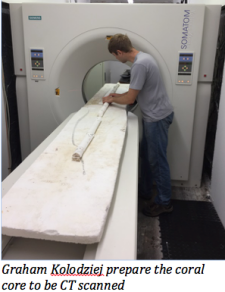
● Dr. Julia Cole, Professor of Geosciences and Atmospheric Sciences at the University of Arizona visited
OCED's Acidification, Climate and Coral Reef Ecosystem's Team (ACCRETE) on August 8. Dr. Cole brought a coral core
she obtained from the Galapagos Islands that exceeded 2 m in length. This core provides a growth record of 200+ years
and was CT scanned. The growth data will be used in concert with geochemical data to understand centennial dynamics
of the El Nino Southern Oscillation and its impact on coral growth. This core is from Darwin Island, which is where
the last remaining coral reef in the Galapagos Islands is located. Past research by OCED has shown that the persistence
of this coral reef correlates with regionally high pH.
Outreach
● Dr. Ian Enochs discussed his research and fielded questions at a public screening for the Changing Seas episode that featured AOML's work at Maug. The event was held at NOVA Southeastern University and roughly 80 people were in attendance.
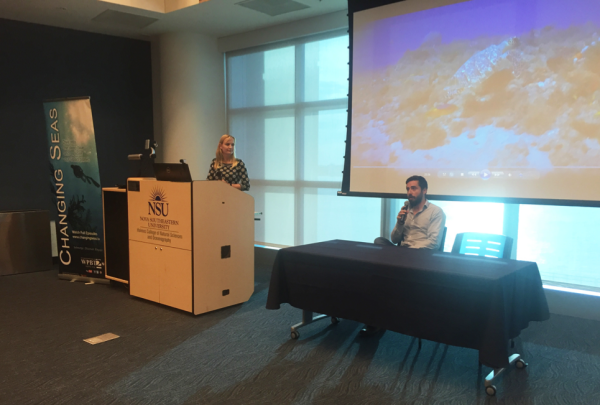 |
News
● The R/V Hildebrand sold for $100,055. This money can be used over the next 2 years on the purchase of research vessels. OCED is looking to purchase trailerable research vessels and potentially replace existing small research vessels. If you have any input on requirements for new vessels or potential projects with needs for vessels, please talk to Dr. Chris Kelble.
August 8, 2016
Field Work
● Lindsey Visser will be participating in the fourth survey of 2016 investigating juvenile sportfish in Florida Bay. These trips have observed unprecedented upside down jellyfish bloom of Cassiopea spp. These blooms are c entered in the area that underwent a large seagrass die-off last year.
Meetings
● Dr. Kelly Goodwin is giving a presentation entitled "Challenges in Method Calibration" at the National Environmental Monitoring Conference in Gaithersburg, MD this week.
News
● The R/V Hildebrand has been up for auction. The auction is closing this Friday, August 12 and the bidding is currently at just over $50,000.
August 1, 2016
Manuscripts
● Dr. Ian Enochs, Dr. Derek Manzello, Lauren Valentino, and Graham Kolodziej published a paper in PLoS one
entitled "Elevated colonization of microborers at a volcanically acidified coral reef." The work was a collaboration
with scientists from IRD, the University of Miami, Bigelow Research Laboratory, and UC Santa Cruz. The authors
found higher amounts of bioeroders removing calcium carbonate near volcanic CO2 seeps at Maug Island, CNMI.
Article citation: Enochs IC, Manzello DP, Tribollet A, Valentino L, Kolodziej G, et al. (2016). Elevated Colonization of Microborers
at a Volcanically Acidified Coral Reef. PLoS ONE 11(7): e0159818. doi: 10.1371/
journal.pone.0159818.
The article can be found at: http://journals.plos.org/plosone/article?id=10.1371%2Fjournal.pone.0159818.
Field Work
● On August 3rd 2016, Jack Stamates, Benjamin VanDine, and Marc Weekley deployed four current meters near the St. Lucie inlet. These meters will help to describe the circulation around the St. Lucie inlet and the dispersion of materials exiting the inlet. The data will be used to calibrate circulation models under development at Harbor Branch Oceanographic Institution and to provide information to fisheries biologists studying larval recruitment in this area. This project is a joint effort between NOAA/AOML, The Florida Fish and Wildlife Conservation commission, The Martin County Department of Environmental Protection, the Harbor Branch Oceanographic Institution and the Southeast Florida Coral Reef Initiative (SEFCRI).
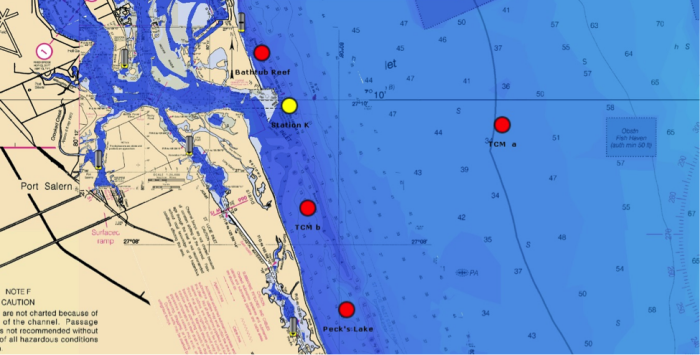 |
Outreach
● Dr. Ian Enochs participated in a "Skype with Scientists" session with campers, counselors, and staff at MacArthur Beach State Park. Ian answered questions about Florida reefs, conservation, ocean acidification, and a career in marine science.
New Investigations
● The Caribbean Community Climate Change Center (5Cs), in Belize, has received guidance from the funding agency, USAID, that they would like the next four Coral Reef Early Warning System (CREWS) stations to be installed in St. Lucia, Antigua & Barbuda, Dominica, and Guyana/Suriname. 5Cs works with AOML/OCED in establishing relationships with the local environmental managers and researchers, and in choosing proper locations for the stations, as well as in providing all the information products for each site (data QC, near real-time Web site for data, and ecological forecasts). However, these countries must still meet the requirements and commitment to the effort before final establishment of the monitoring station; therefore, other sites may be chosen as alternatives.
The OCED Future Reef Lab (funded through the Omics Initiative) has have been designed using 3D CAD software and construction is underway. Custom software has been written to monitor and precisely manipulate treatment conditions and a trial system has been built to refine experimental control. Testing of this system is underway and the control algorithm is being refined. Several large purchases are pending, though all have been fully submitted through the NOAA bid system. Anticipated completion of the entire system is mid-September.
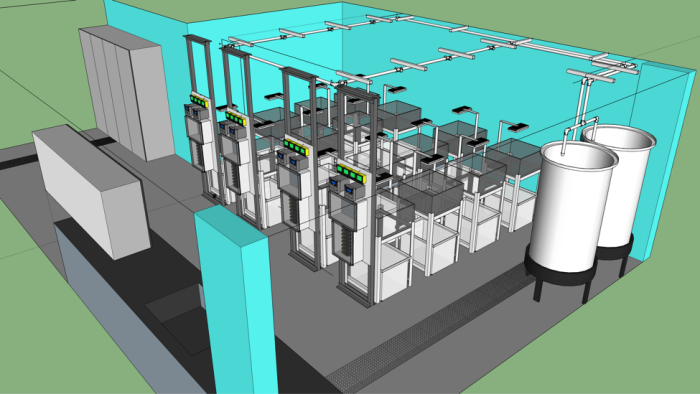 |
Meetings
● Dr. Christopher Kelble will be attending the Gulf of Mexico Data Synthesis and Gulf of Mexico Regional Coordination Team workshop in Baton Rouge (August 1-5). The data synthesis workshop aims to catalog NOAA data collections in the Gulf of Mexico for both the RESTORE comprehensive monitoring program and the Gulf of Mexico Regional Climate Center at LSU. The Gulf of Mexico regional team last year decided to begin investing strategic cross-NOAA initiatives to improve internal awareness of NOAA activities in the Gulf of Mexico and this meeting will provide a chance to evaluate the efficacy of those projects and determine the path for the Gulf of Mexico Regional Team in the upcoming year.
July 25, 2016
● In remembrance of the death of Patrick (Pat) Wanninkhof by a distracted driver a year ago, the Village of Key Biscayne has posted a banner on Crandon Boulevard and at village hall discouraging texting and driving.
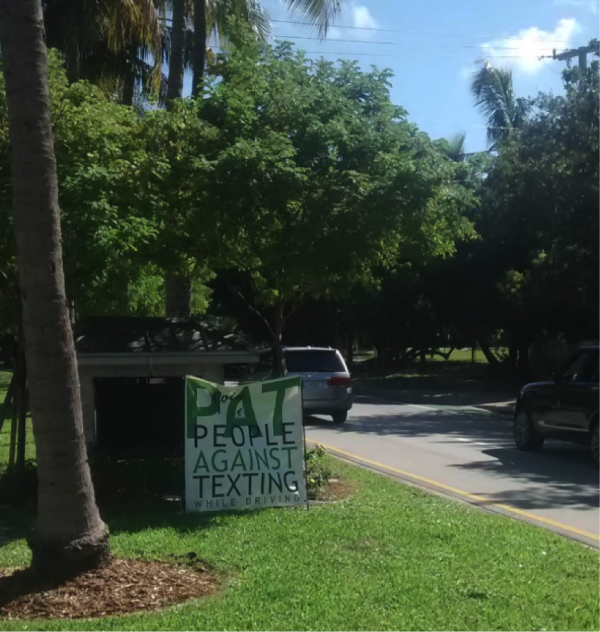 |
Awards
● Dr. Natchanon Amornthammarong was the suvject of a broadcast by Voice of America news, http://www.voathai.com/a/thai-scientist-noaa/3399949.html. This video was broadcast on TV in Thailand and has been shared all over the internet via numerous websites and facebook pages, including the Royal Thai Embassy's facebook (below) and Mana's University's facebook. Coincidently, Mana was in Thailand while the story released and was invited to give talks to several universities.
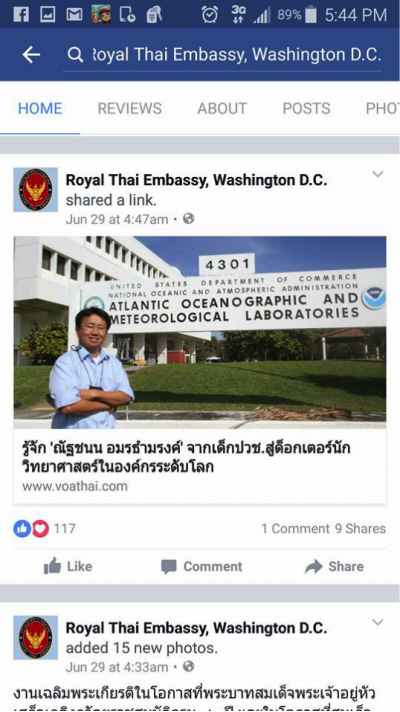 |
Field Work
● Lindsey Visser, Charline Quenee, and Ben Van Dine are sampling aboard the R/V Walton Smith this week in support of the South Florida Ecosystem Restoration research project. This cruise will continue its typical sampling, but has added a new component sampling coral microbiome genetics at key sites along the Florida Keys reef tract. These sites will coincide with the ongoing MBON sampling of genetic material in the water column.
Meetings
● Dr. Kelly Goodwin will be participating in the Emerging Technologies meeting in Washington, DC on July 26 & 27.
● Dr. Christopher Kelble will be attending the Gulf of Mexico Data Synthesis and Gulf of Mexico Regional Team workshop next week in Baton Rouge (August 1-5). The data synthesis workshop aims to catalog NOAA data collections in the gulf of Mexico for both the RESTORE comprehensive monitoring program and the Gulf of Mexico Regional Climate Center at LSU. The Gulf of Mexico regional team last year decided to begin investing strategic cross-NOAA initiatives to improve internal awareness of NOAA activities in the Gulf of Mexico and this meeting will provide a chance to evaluate the efficacy of those projects and determine the path for the Gulf of Mexico Regional Team in the upcoming year.
July 18, 2016
Outreach
● Ian Enochs presented at NOAA Science Days in Silver Spring last week. His talk was titled "Technology meets reefs of tomorrow: Monitoring, forecasting, and mitigating the impacts of ocean acidification" and covered research the ACCRETE lab within OCED has conducted at AOML. The talk was well attended and provided for some meaningful follow-ups.
Field Work
● Lindsey Visser and Charline Quenee are surveying juvenile sportfish in Florida Bay on July 16-19. This is the third sampling trip this field season. The May and June trip observed higher abundances of juvenile seatrout than in most recent years. This is likely in part due to the high rainfall in the dry season moderating salinities in Florida Bay. Thus, increasing the quality of habitat available to juvenile seatrout. Moreover, it suggests the massive seagrass die-off in Florida Bay last year has not adversely affected the spotted seatrout population.
● Graham Kolodziej, Lauren Valentino, Ben VanDine, Derek Manzello, and Brooke Gintert (RSMAS) conducted landscape mosaic and CaCO3 budget surveys from 11-14 July at the Cheeca Rocks sentinel climate/ocean acidification monitoring site as part of NOAA's National Coral Reef Monitoring Program.
Meetings
● Dean Schwienler of Sea-Cam Inc. joined Graham Kolodziej, Lauren Valentino, and Derek Manzello of NOAA/AOML nd Brooke Gintert (RSMAS) on 12 July at Cheeca Rocks to film their work on coral reef monitoring to gauge the impacts of ocean acidification.
Jyly 11, 2016
Field Work
● Lindsey Visser and Charline Quenee will be surveying juvenile sportfish in Florida Bay on July 16-19. This is the third sampling trip this field season. The May and June trip observed higher abundances of juvenile seatrout than in most recent years. This is likely in part due to the high rainfall in the dry season moderating salinities in Florida Bay. Thus, increasing the quality of habitat available to juvenile seatrout. Moreover, it suggests the massive seagrass die-off in Florida Bay last year has not adversely affected the spotted seatrout population.
● Derek Manzello, Ben VanDine, Lauren Valentino, Graham Kolodziej will conduct Coral Reef surveys, photo mosaics and instrument deployment from July 10 to July 15 in Cheeca Rocks, Islamorada, FL.
Meetings
● Dr. Chris Kelble is participating in a cross-NOAA effort to develop a graphic/picture/diagram that connects the efforts, concepts, and applications of our various system-based management approaches (ES, EBM, Resilience, Climate, etc). The outcome of this meeting will help drive our preparation for the transition team about how these efforts fit together to create a strong portfolio. If you have any thoughts on how NOAA should address these ecosystem management efforts, please contact Chris.
● Dr. Chris Kelble is participating in a cross-NOAA effort to develop guidance on projects that NOAA intends to submit for funding by the RESTORE bucket 2 monies, overseen by the RESTORE council. This effort will begin identifying and prioritizing projects that NOAA might support in future rounds of RESTORE (Bucket 2) funding. By starting this process early, NOAA will be better positioned to have strategic conversations with other Federal and State Council Members on partnership and leveraging opportunities. If you have any comments or thoughts on this process, please contact Chris.
July 4, 2016
Meetings
● Jim Hendee presented his talk, "Expansion of the Coral Reef Early Warning System (CREWS) Network Throughout the Caribbean" to Session #73A (Co-management: partnerships for achieving effective resource outcomes on coral reefs - Partnerships across agencies and organizations) of the 13th International Coral Reef Symposium in Honolulu, HI, during the week of June 20th. Jim also was Co-Chair (along with Lew Gramer and others) of Session #50, "Modeling and computational tools for coral reef management and conservation", and Session #88, "Citizen Science in Support of Coral Reef Protection and Sustainability.".
June 27, 2016
Field Work
● Dr. Pamela Fletcher, Sea Grant liaison at AOML, led the Nicaragua Hawksbill Sea Turtle Monitoring Project training with Wildlife Conservation Society staff on June 20th. Eight individuals from the local community were selected to monitor sea turtle nesting in the Pearl Cays, Caribbean Nicaragua. The teams spend the nesting season living on one of the 18 small islands in the western Caribbean monitored for nesting turtles. In 2015, there were a record number of nests (546) on the cays and to date there are 45 nests. The teams will begin the intensive monitoring season this week since the peak of nesting season is in July and August.
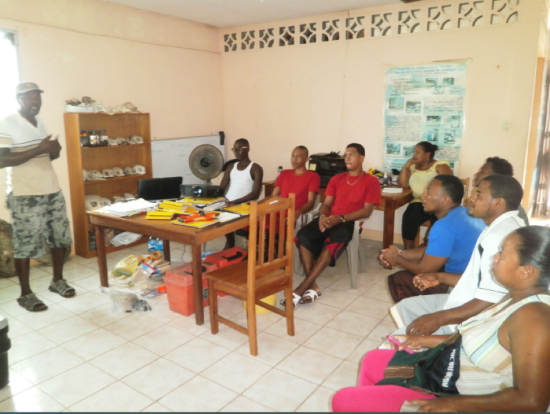 |
|
Figure 1. During the 2016 hawksbill sea turtle nesting training, William McCoy, WCS staff describes the physical characteristics of the sea turtle to the turtle team. |
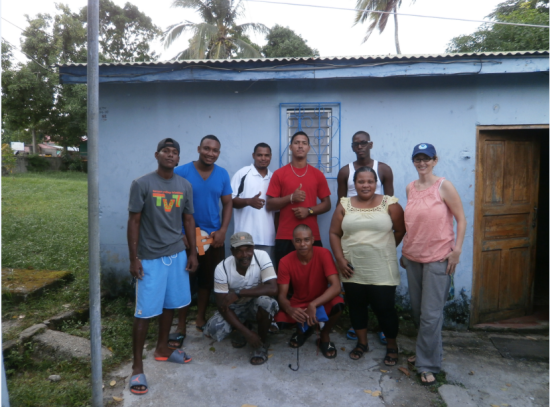 |
|
Figure 2. The 2016 Hawksbill Conservation Program team completes their training and will begin nest monitoring this week. |
Workshops
● Dr. Pamela Fletcher, a Sea Grant liaison at AOML, will facilitate a technical workshop for the development of a management plan for the Pearl Cays Wildlife Refuge in Caribbean Nicaragua on Monday, June 27. The workshop participants include academics, community leaders, and Wildlife Conservation staff. The management planning process is following the steps of the Integrated Ecosystem Assessment that NOAA/AOML/OCED is currently using in South Florida and the Gulf of Mexico.
Outreach
● Dr. Pamela Fletcher, a Sea Grant liaison at AOML, has been mentoring Galen Boulanger, a LORAN Scholar from the University of Ottawa in the development of an assessment of the Alternative Livelihoods Project in the Pearl Cays, Caribbean Nicaragua. With guidance from Dr. Fletcher, Galen is developing survey instruments to conduct interviews with members of the community, advisory board members, and members of Kabu Tours - the alternative livelihood project that promotes reducing the catch of green sea turtles by indigenous communities through ecotourism activities. The surveys will be administered over the next 2 months and begin this week (June 27, 2016). The assessment will be used to identify opportunities for improvement in the alternative livelihood project and areas of success. More information about the alternative livelihood can be found at www.kabutours.com.
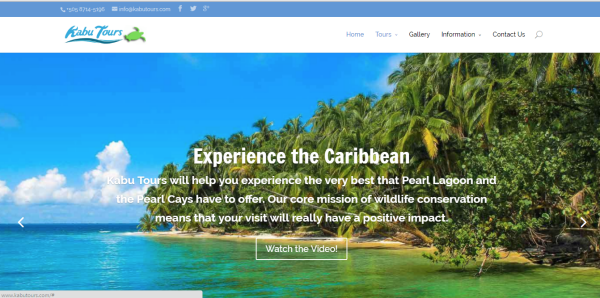 |
|
Figure 3. Kabu Tours is an alternative livelihood project in Caribbean Nicaragua that promotes the reduction in legal catch of green sea turtles through ecotourism. |
Meetings
● Dr. Ruben van Hooidonk gave an oral presentation entitled "Downscaled Projections of the Coral Bleaching Conditions that Can Inform Conservation Planning" at the International Coral Reef Symposium. These 4 km scaled projections of coral bleaching are intended to help managers prioritize their actions by highlighting reef locations that are projected to provide goods and services for the longest time. These temporary refugia are conservation priorities. The projections have been made available as interactive Google earth tools downloadable from UNEP-live and Coral Reef Watch websites.
● Drs. Chris Sinigalliano and Maribeth Gidley attended the International Coral Reef Symposium in Honolulu, Hawaii last week. Dr. Sinigalliano gave an oral presentation entitled "Developing a NOAA Coral Genomic Observatory Network (CGON): Preliminary Metagenomic Pilot Studies and CGON Development Plans". In addition, they also participated in several special workshops and panel discussions including "The Science and Management of Water Quality on Coral Reefs", "Using Genomics for Coral Reef Management – A Needs Assessment", the "EarthCube CRESCYNT" open participants meeting on critical need cyberinfrastructure for a new age of marine data management, "Experiences and Best Practices with Citizen Science Activities", and they also greatly enjoyed Native Hawaiian artwork and musical expression of the importance of coral reefs and marine health with a special evening session "Celebrating Coral Reefs with Cultural Performances and Artwork Displays". Of further benefit, a number of ongoing research collaborations were strengthened and some potential new collaborations formed. Overall it was a very enjoyable and successful conference. A final great experience was a personalized tour of the Hawaii Institute of Marine Biology (a part of the Univeristy of Hawaii), located off-shore of Oahu on the island of Moku O'Loe. The entire island is a dedicated marine research facility and it is fabulous.
June 20, 2016
Manuscripts
● Ruben van Hooidonk is co-author on a paper being published in Conservation Letters. The article entitled "Great Barrier Reef No-Take Areas Include a Range of Disturbance Regimes" was featured on the cover with a picture of bleached coral in the Keppel Islands. The article analyzed disturbance exposure in the Great Barrier Reef Marine Park (GBRMP). They found a wide range of exposure classes in the GBRMP, but a greater proportion of low-exposure areas are within no-take areas than high-exposure areas (34.2% vs. 28.3%). The results demonstrate the value of risk spreading when exposure data are not available while also showing that regularly assessing exposure increases capacity for adaptive, resilience-based reef management.
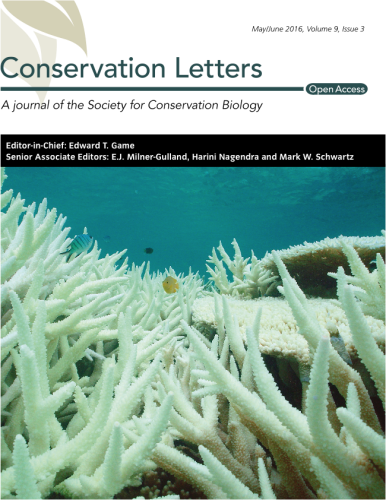 |
Field Work
● Lindsey Visser and Charline Quenee will be surveying juvenile sportfish in Florida Bay on June 25 through June 29. This is the second sampling trip this field season. The May trip observed the most juvenile seatrout recorded during the study period for May. This is likely in part due to the high rainfall in the dry season moderating salinities in Florida Bay. Thus, increasing the quality of habitat available to juvenile seatrout.
Meetings
● Jim Hendee, Derek Manzello, Ian Enochs, Paul Jones, Chris Sinigalliano, Lew Gramer, Ruben van Hooidonk, and Maribeth Gidley will be attending the International Coral Reef Symposium. Dr. Sinigalliano is giving an oral presentation on Tuesday entitled, "Developing a NOAA Coral Genomic Observatory Network (CGON): Preliminary Metagenomic Pilot Studies and CGON Development Plans".
June 13, 2016
Field Work
● Lindsey Visser and Charline Quenee will be sampling water quality in the primary canals entering Biscayne Bay on Wednesday and Thursday. This sampling is part of the Biscayne Bay Habitat Focus Area Study. Unfortunately, this will be the last cruise sampling these canals after the Habitat Focus Area Program received substantial cuts in funding.
Meetings
● Derek Manzello is attending the National Science Foundation's "2016 U.S. Investigator Coral Bleaching Workshop" on June 17 and 18 in Honolulu, HI. This meeting, in advance of the 13th International Coral Reef Symposium, is bringing together coral reef scientists in academia and government that study coral bleaching with the goal of building collaborations and highlighting research priorities in bleaching science. Dr. Manzello is one of two NOAA scientists attending the event.
● Chris Kelble is attending the workshop on "Data Needs for Assessing Stress and Health Effects Associated with Oil Spills and Hurricanes in the Gulf of Mexico". The meeting is being organized by Dr. Paul Sandifer at the College of Charleston through funding from the National Academies of Sciences. This study is using a conceptual model based upon the EBM-DPSER framework developed by OCED.
● Chris Sinigalliano and Maribeth Gidley will be attending the Gulf Of Mexico Alliance All-Hands Meeting this week in Baton Rouge, LA. Dr. Sinigalliano serves as the NOAA federal facilitator for the Water Resources Priority Issue Team, and Dr. Gidley serves on both the GOMA Water Resources Priority Issue Team and the cross-disciplinary Marine Debris Team.
May 31, 2016
Manuscripts
● Derek Manzello is a coauthor on the manuscript entitled "Variable El Niño Southern Oscillation influence on biofacies dynamics of Eastern Pacific shallow water carbonate systems" that was accepted for publication in the journal Geology. Full citation: Humphreys A, Halfar J, Rivera F, Manzello D, Reymond C, Westphal H, Riegl B (2016) Variable El Niño Southern Oscillation influence on biofacies dynamics of Eastern Pacific shallow water carbonate systems. Geology.
Field Work
● Lauren Valentino, Ben Van Dine, and Derek Manzello successfully resampled coral colonies of the ESA-listed Orbicella faveolata that were initially sampled in October 2015 and retrieved instrumentation as part of the CRCP funded project "Elucidating the recipe of coral reef resilience in the Florida Keys." This project is measuring coral physiological recovery from bleaching and key environmental variables across inshore-offshore gradients in an attempt to better ascertain what has led to maintenance of high coral cover on inshore patch reefs. Projects.
● Mike Jankulak successful troubleshot a non-functioning transmitter at the Cheeca Rocks MAPCO2 buoy. The buoy had failed to transmit since its refurbishment; the faulty transmitter was swapped and is now functional. Upon visiting the site, it was found that it logged data since redeployment.
Meetings
● Pamela Fletcher visited the NWS office in Brevard County last week. NWS is leading a regional effort to conduct storm surge monitoring with Sea Grant offices. The partnership evolved from the SECART program and Florida Sea Grant has sought funding to incorporate the monitoring program into South Florida schools.
● Pamela Fletcher attended the Florida Sea Grant strategic planning meeting in St. Petersburg last week. Participants contributed to defining goals and outcomes that will serve as a roadmap for research and extension over the four year period from 2018-21. In January 2017, Florida Sea Grant will put out a call for research proposals to support the plan. Participants also provided input for long-term visioning for Sea Grant programming.
● Last week, Pamela Fletcher visited the Florida Aquarium Center for Conservation where Sea Grant colleagues are conducting restoration aquaculture. The facility is located in Apollo Beach and is a public-private collaboration to promote aquatic education and research
May 23, 2016
Field Work
● Lindsey Visser and Ian Smith of OCED will be in Florida Bay from Saturday May 28 until Tuesday, May 31 sampling juvenile sportfish, seagrass, temperature, salinity, turbidity, and dissolved oxygen. This is the first survey cruise of this year for the juvenile sportfish monitoring project. The juvenile sportfish monitoring project collects observations from May through October of each year to correspond with juvenile spotted seatrout spawning season. These observations are used to parameterize, calibrate, and validate empirical models that are used to evaluate potential Everglades Restoration Projects.
Meetings
● AOML/OCED will be hosting the Gulf of Mexico Integrated ecosystem Assessment (GoM-IEA) Principal Investigators (PI) meeting this Tuesday through Thursday in the 2nd Floor Conference Room. The GoM-IEA has PIs from the National Ocean Services, National Environmental and Satellite Data, and Information Service, National Marine Fisheries, and OAR/AOML. This meeting aims to make sure all line offices are working in a collaborative, complementary way to develop integrated socio-ecological decision-support products to enhance ecosystem management in the Gulf of Mexico.
May 16, 2016
Field Work
● The Cheeca Rocks MApCO2 buoy underwent significant maintenance and repairs. The buoy was removed, pulled apart, cleaned, painted, put back together, and redeployed last week. Its last major maintenance was March 21-25, 2015. The buoy was not properly communicating before this maintenance (which it does normally via Iridium satellites), but as of May 13th it resumed its normal every-3-hours sampling operations. These photos and videos were all taken at the Snake Creek Marina in Islamorada.
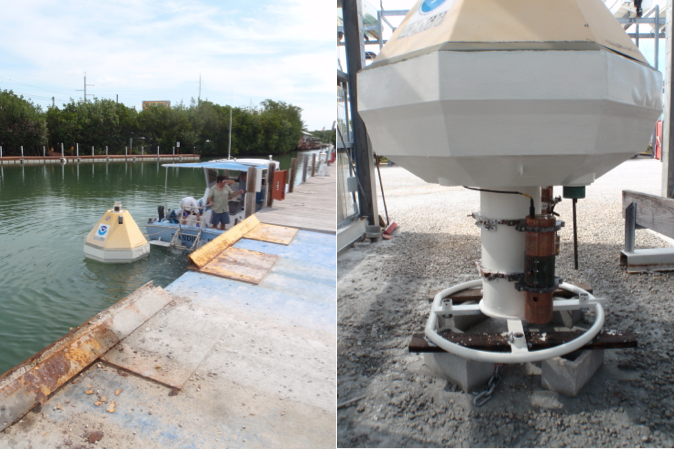 |
Proposals
● The proposal, "Development of Bioinformatics Computing Capacity to Support NOAA 'Omics'" has been selected for funding at $40,565 to support the purchase of a powerful computer for bioinformatics processing of data collected under our new Coral + Omics initiative. Authors of the proposal included Jim Hendee, Kelly Goodwin, Chris Sinigalliano, and Mike Shoemaker.
● The proposal entitled "Effects of sedimentation stress in adult and early life stages of corals, including two ESA-listed species", led by Xaymara Serrano, Jim Hendee, and Margaret Miller of NOAA and Andrew Baker of UM/RSMAS was selected for an award from the "Protect Our Reefs" Grants Program. This grant is funded by the sale of coral reef specialty license plates and administered by Mote Marine Laboratory.
May 9, 2016
Accomplishments
● Charline Quenee was accepted into the Marine Ecosystems and Society department at RSMAS to pursue an MS degree starting this fall.
Meetings
● Chris Kelble is in Silver Spring, MD serving on a review panel for NOAA. He will also be meeting with colleagues and program managers while he is at headquarters.
● Dr. Kelly Goodwin will be in DC on May 13 to attend the formal roll-out of the National Microbiome Initiative. Dr. Goodwin is the NOAA representative on the Microbiome Interagency Working Group (MIWG), which was established by action of the National Science and Technology Council (NSTC), Committee on Science (CoS), Subcommittee on Life Sciences (LSSC), National Science and Technology Council. The working group charter was signed on 2/15/2016. The MIWG grew out of the Fast-Track Action Committee on Mapping the Microbiome (FTAC-MM), which identified areas of current Federal investment, research needs, and resource gaps. The FTAC-MM produced a publication in the inaugural edition of Nature Microbiology "An Assessment of US Microbiome Research" (Stulberg et al. 2016, Vol1, pp. 1-7, DOI: 10.1038/NMICROBIOL.2015.15) and the "Report of the Fast Track Action Committee on Mapping the Microbiome" (https://www.whitehouse.gov/sites/default/files/microsites/ostp/NSTC/ftac-mm_report_final_112015_0.pdf). NOAA has several projects that include microbiome studies. Examples include microbial metagenomic and metatransciptomic work to support ecosystem understanding and fisheries assessment, microbiome assessment via in-situ and mobile technologies, eDNA research to garner intelligence on higher trophic levels via ocean microbiome assessment, and coral holobiont studies to understand and combat thermal, ocean acidification, nutrient, and disease stress. NOAA investment in this area of research includes building bioinformatic capacity. In FY16, NOAA's OAR line office began an initiative to support such efforts at a level of $1.79M. The multi-partner effort includes close collaboration with NOAA's NMFS line office, the J. Craig Venter Institute (JCVI), the Monterey Bay Aquarium Research Institute (MBARI) and academic partners, including the Scripps Institute of Oceanography (SIO) and the University of Miami.
May 1, 2016
Manuscripts
● Dr. Chris Kelble is a co-author on a manuscript entitled "Moving from Ecosystem-based policy objectives to operational implementation of ecosystem-based management measures" that was submitted to the ICES Journal of Marine Science. This paper examines public policymaking processes and practices that are used to develop operational policy strategic goals and tactical objectives as a means to operationalize ecosystem-based management planning processes. The sciences of all disciplines actively address knowledge gaps through research and academic collaborations. It is the specificity of information needed to inform strategic goals, tactical objectives, and management measure outcomes that is in part the challenge more so than the knowledge itself. Managers, stakeholders and even scientists need access to a broad range of disciplines spanning the natural and social sciences to economics and law in order to adequately and explicitly appraise trade-offs.
● Dr. Ruben van Hooidonk is a co-author on a manuscript entitled "Coral Reefs and People in a High-CO2 World: Where can science make a difference to people?” that was submitted to Plos One. In it, they identify areas where people are dependent on reefs and those reefs are threatened by the impacts of anthropogenic climate change, both by temperature increases and increases in ocean acidification. Societies in Western Mexico, Micronesia, Indonesia and parts of Australia have high dependence on reefs and are projected to face severe impacts. As a region, Southeast Asia is particularly at risk. These areas require new data and interdisciplinary scientific research to help coral reef-dependent human communities better cope with, prepare for, and adapt to increasing atmospheric CO2.
Meetings
● Dr. Ian Enochs, Dr. Rik Wanninkhof, and Dr. Derek Manzello are attending the 4th Oceans in High-CO2 World Meeting from 3-6 May in Hobart, Tasmania. Dr. Enochs is presenting an oral presentation entitled "Volcanic acidification at Maug Island correlated with spatial shift from coral to algae-dominated ecosystem". Dr Manzello is giving an oral presentation entitled "Galápagos Coral Reef Persistence after ENSO Warming across an Acidification Gradient."
● Jack Stamates is attending the National Monitoring conference in Tampa, Fl on May 3-6. He will present results from the Numeric Nutrient study and present a poster on the Boca Raton Inlet/Hillsboro Inlet nutrient loading studies.
● April 26-28 in College Park, MD, Dr. Lew Gramer attended the 5th NOAA Ecological Forecasting Roadmap Meeting. Dr. Kelly Goodwin also did a forward-looking remote presentation on 'Omics. The annual EFR meeting gathers research scientists and operational systems managers from around NOAA, together with representatives from FDA, EPA, and State agencies. Sessions reviewed progress on NOAA's ecological forecasting products, and strategies for transitioning them to NOAA's operational arms. NOAA's chief scientist, and Asst. Administrators from four Line Offices also presented on NOAA's Unified Modeling approach and other related topics. A primary focus this year was on recent successes in operational forecasting of impacts from Harmful Algal Blooms (HABs) in Lake Erie, as well as Chesapeake Bay and the Pacific Northwest coast. Coral bleaching, hypoxia, and water-borne pathogens were all under discussion for future transitions to operational status.
● Dr. Maribeth Gidley will be attending FAU's Sea-Level Rise Summit: Connected Futures from Alaska to Florida, May 4th and 5th in Fort Lauderdale, where she will be also be participating in the discussion and production of a "Living Document" entitled "Adaptation Pathways 1.0" looking at the health issues faced by coastal cities due to sea-level rise, and how resilience might be improved.
● Dr. Pamela Fletcher will be attending the 3rd Sea Level Rise Summit in Fort Lauderdale from May 3-5. The three-day meeting will convene leading researchers, decision-makers, and other interested stakeholders to discuss the state of sea-level rise science, and how public policy and private adaptation efforts can lessen the impacts. Discussions will revolve around the following topic areas: Public Health, Infrastructure, Water, Society and Economy, Governance, National Security and International Responses. Pamela will network with regional and national researchers and policy makers to identify the potential to incorporate information into Integrated Ecosystem Assessment programming and University of Florida/Florida Sea Grant activities in South Florida.
Bon Voyage
● Renee Carlton is leaving AOML/OCED on Friday, May 6. Renee joined AOML in the spring of 2012 and has served as a lab manager and field coordinator for coral research in OCED during her tenure. She has accepted a position with the Khaled bin Sultan Living Ocean's Foundation (LOF) in Annapolis, MD where she will be writing up the data from their numerous field expeditions over the past several years. Please join us in the second floor conference room for snacks and coffee on Thursday, May 5 to say good bye to Renee and wish her luck in her new position.
April 25, 2016
Manuscripts
● Dr. Ian Enochs and Dr. Derek Manzello are co-authors on the paper entitled "Acclimatisation
to high variance habitats does not enhance physiological tolerance of two key Caribbean corals to
future temperature and pH" which has been accepted for publication in the Proceedings of the Royal Society
of London B. This study shows that two coral species living in environmentally variable habitats in
Little Cayman Island were not more resilient to future climate change stress, suggesting that
acclimatization to present-day warmer and lower pH conditions did not afford increased tolerance to
further warming and ocean acidification.
The full citation is:
Camp E, Smith D, Evenhuis C, Enochs IC, Manzello DP, Woodcock S, Suggett D (2016). Acclimatisation to
high variance habitats does not enhance physiological tolerance of two key Caribbean corals to future
temperature and pH. Proceedings of the Royal Society B. In Press.
● Dr. Ruben van Hooidonk is a co-author on the paper entitled “Coral mass spawning predicted by
rapid seasonal rise in ocean temperature" that was accepted for publication in the Proceedings of the
Royal Society of London B. Coral spawning times have been linked to multiple environmental factors;
however, to what extent these factors act as generalized cues across multiple species and large spatial
scales is unknown. We used a unique data set of coral spawning from 34 reefs in the Indian and Pacific
Oceans to test if month of spawning and peak spawning month in assemblages of Acropora spp. can be
predicted by sea surface temperature (SST), photosynthetically active radiation, wind speed, current
speed, rainfall or sunset time. Contrary to the classic view that high mean SST initiates coral spawning,
we found rapid increases in SST to be the best predictor.
The full citation is:
Sally A. Keith, Jeffrey A Maynard, Alasdair J. Edwards, James R. Guest, Andrew G. Bauman, Ruben van Hooidonk,
Scott F. Heron, Michael L. Berumen, Jessica Bouwmeester, Srisakul Piromvaragorn, Carsten Rahbek, and
Andrew H. Baird. 2016. Coral mass spawning predicted by rapid seasonal rise in ocean temperature.
Proceedings of the Royal Society B. In Press.
● Dr. Ruben Van Hooidonk is the lead author on a manuscript entitled "Local-scale projections of coral reef futures and implications of the Paris Agreement" that has been submitted to Nature Climate Change. This study generated statistically downscaled climate projections (4-km resolution) for all coral reefs. It depicts the spatial patterns of these projections and evaluates the implications of the COP21 Paris Agreement for the projected timing of the onset of annual severe bleaching (ASB); a point at which reefs are certain to change and recovery will be limited. Our downscaled projections reveal high local-scale variation in ASB. Timing of ASB varies >10 years in 71 of the 87 countries and territories with >500km2 of reef area and some countries have far more relative "climate winners" than other countries. These results indicate that projections warrant consideration in conservation and management planning at all spatial scales. Emissions scenario RCP4.5 represents lower emissions mid-century than will be realized if pledges made following the 2015 Paris Climate Change Conference (COP21) become reality. RCP4.5 adds ~15 years on average before ASB occurs when compared to RCP8.5; however, >75% of reefs still experience ASB before 2070 under RCP4.5. Much greater emissions reductions are required than were pledged following COP21 to prevent the great majority of coral reefs from experiencing severe bleaching conditions annually within this century.
Field Work
● Dr. Paul Jones, Lauren Valentino, Graham Kolodziej and LT(jg) Benjamin Van Dine are traveling to the Cheeca Rocks NCRMP climate sentinel site from 25-28 April to take coral samples from the endangered coral species Orbicella faveolata following recovery from bleaching in the summer of 2015. This work is determining the role of symbiont clade type in the resistance and resilience of this critical species to the back-to-back warm water bleaching in 2014 and 2015 in south Florida.
● Dr. Xaymara Serrano will be in the field on Tuesday collecting coral colonies and sediments from Miami waters to use in her new CRCP funded project entitled "Effects of sedimentation stress in adult and early life stages of corals, including two ESA listed species".
● Dr. Denis Pierrot is sailing on the RCCL ship Equinox for her repositioning cruise from the Caribbean to the Mediterranean to collect samples that will be used in conjunction with the underway CO2 measurements to study open ocean acidification of surface water of the subtropical North Atlantic. A second automated underway CO2 system was recently installed on the RCCL ship Allure of the Sea by Kevin Sullivan and Denis Pierrot. The Allure covers the same cruise track as the initial operations on the RCCL ship Explorer of the Seas providing a continuation of measurements of changes in surface water CO2 and ocean acidification that began in 2002. The efforts on the RCCL ships are performed in collaboration with RSMAS/U.Miami and coordinated through CIMAS. The work is supported by NOAA/CPO/COD and NOAA/OAR/OAP.
● Dr. Leticia Barbero and Robert Castle have completed the final station of the GO-SHIP Indian Ocean Cruise IO9N and are now headed back to port in Phuket (Thailand). Over a period of 5 weeks, the cruise has done 113 full depth CTD casts as well as trace metals and optics casts. Leticia is the chief scientist overseeing the activities of 30 scientists and Bob is leading the effort to measure changes in inorganic carbon in this remote region. The effort is sponsored by the Climate Observation Division of NOAA's Climate Program office.
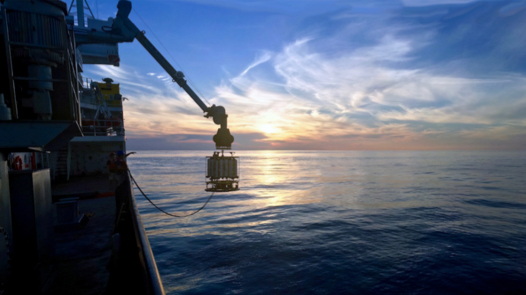 |
Meetings
● Dr. Chris Kelble is attending the Gulf of Mexico EcoHealth Metrics workshop this week at the Harte Research Institute at Texas A&M University in Corpus Christi. The workshop aims to comprehensively identify how ecosystem health relates to ecosystem services and their linkages to human well-being, and explore the utility of a pre-defined framework for addressing specific management issues. This effort was funded out of the NOAA RESTORE Act Science Program.
● Jack Stamates and Dr. Ruben Van Hooidonk are attending the Southeast Florida coral reef initiative meeting at Nova Southeastern University on April 27th and 28th. Jack will present results from the numeric nutrient study and the Boca Raton Inlet/Hillsboro Inlet nutrient loading studies. Ruben will present coral bleaching projections from global to local scales.
● Dr. Kelly Goodwin is speaking on 'Omics at the NOAA Ecological Forecasting Roadmap Annual Meeting held April 26-28, 2016 in a session entitled "State of the Science: Emerging Topics in Ecological Forecasting".
● Dr. Xaymara Serrano will travel to Key West on April 28th to present the final findings for the two year Mote's Protect Our Reefs grant entitled "Synergistic effects of eutrophication and elevated sea surface temperatures in the early life stages of two Caribbean corals". This work is a collaborative project with Drs. Margaret Miller (NOAA/SEFCS), Andrew Baker (UM/RSMAS) and Dr. Jim Hendee (OCED).
April 18, 2016
Field Work
● Dr. Ian Enochs and Dr. Paul Jones (ACCRETE Lab), with the help of Marc Weekley (NOAA Corps), will be traveling throughout the Upper, Middle, and Lower Keys to install an array of Bioerosion Monitoring Units (BMU) at 12 inshore and offshore reefs. The study will assess differences in bioerosion rates and types between the three areas of the Florida Keys, as well as any differences between inshore and offshore reef habitats.
● Dr. Xaymara Serrano (OCED) will be in the field on April 22nd collecting coral colonies and sediments from Miami waters to use in her new CRCP funded project entitled "Effects of sedimentation stress in adult and early life stages of corals, including two ESA listed species".
Meetings
● Dr. Pamela Fletcher and Charline Quenee will be attending a training workshop sponsored by the EBM Tools Network in conjunction with NatureServe's Biodiversity Without Boundaries conference in San Juan, PR from April 19-22. The training workshop is designed to increase awareness about the role various tools play in coastal EBM practices, assist in the developing of management frameworks and offer opportunities for managers and scientists to share information about EBM progress throughout the Caribbean Region. Pamela and Charline will use the training to enhance their contributions to the Integrated Ecosystem Assessment program at AOML and to liaise with MPA managers in the region as part of the CREWS 5C science-to-management effort.
● Mike Jankulak is attending the 11th MTS Buoy Workshop in Woods Hole, MA this week (https://www.whoi.edu/buoyworkshop/2016/), featuring presentations from WHOI, USF, Teledyne RDI, GLERL, PMEL, NDBC and MIT.
● Dr. Chris Kelble will be presenting his work entitled “Restoration targets for Juvenile Sportfish in Florida Bay” this week at the National Conference on Ecosystem Restoration in Coral Springs, FL. This presentation will describe how the ecosystem assessment and modeling group in OCED developed habitat suitability index models from their observational measurements to quantify the predicted improvement in juvenile sportfish habitat if Everglades Restoration successfully restored freshwater flows to Florida Bay.
April 11, 2016
Accomplishments
● LT(jg) Benjamin Vandine was accepted into the UF School of Forest Resources and Conservation. He plans on completing a Master's of Professional Science in Fisheries and Aquatic Sciences.
Field Work
● NOAA's Ocean Acidification Program funded the proposal titled "Building Robust Reef Carbonate Projections from Synthesized NCRMP Ocean Acidification Datasets." This project will fund a postdoctoral associate to work one year at AOML in the Acidification, Climate and Coral Reef Ecosystems TEam (ACCRETE) and one year at the Coral Reef Ecosystems Program of the Pacific Island Islands Fisheries Science Center to synthesize NCRMP datasets from the Atlantic and Pacific Oceans.
Field Work
● Dr. Leticia Barbero and Robert Castle continue to participate on the second leg of the GO-SHIP Indian Ocean Cruise (IO9N). Leticia is the chief scientist overseeing the activities of 30 scientists and Bob is leading the effort to measure changes in inorganic carbon in this remote region. The effort is sponsored by the Climate Observation Division of NOAA's Climate Program office.
● The CHAMP program has added a virtual station to its collection of Cuba stations at Banco de San Antonio. This area is a commercially important fisheries region and one of the sister sanctuaries with NOS Sanctuaries Flower Garden Banks NMS and Florida Keys NMS. Discussions are still continuing about the feasibility of installing an in situ CREWS station at Guanahacabibes National Park near Maria la Gorda in western Cuba. CHAMP portal data can be found at http://www.coral.noaa.gov/champportal
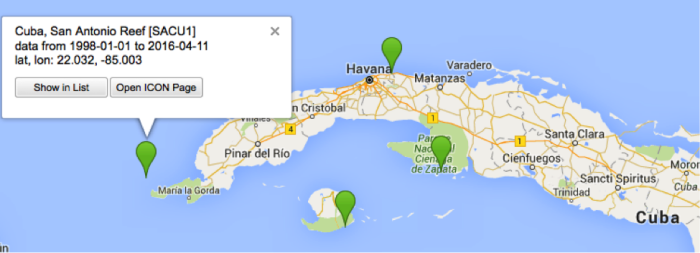 |
Meetings
● Dr. Ian Enochs and Dr. Derek Manzello are attending the National Coral Reef Monitoring Program PI meeting in Charleston, SC.
Seminars
● Dr. Kelly Goodwin presented participated in the 2016 San Diego Citizen Science Expo held at the La Jolla library. She presented on the 2014/2015 Ocean Sampling Day Events and was on a panel discussion regarding Citizen Science opportunities and challenges.
Opportunities in OCED
● 'Omics Bioinformatics Job Search at AOML: AOML is seeking to hire a Research Associate in Multi-Omics Bioinformatics via NGI at the University of Southern Mississippi to help with both the Environmental Microbiology Program and the new AOML Coral and 'Omics Initiative. Although this personan will be an employee of USM, they will be based at AOML as an NGI contractor under the supervision of Dr. Chris Sinigalliano. The primary responsibility of the person hired will be computer-based bioinformatic analysis of DNA and RNA sequences requiring command line programming using Linux and/or other platforms, bioinformatic tools and pipelines, and web-based applications including online portals for sequences retrieval, manipulation, and archiving. This person must be able to provide bioinformatic analysis of metagenomic, metatranscriptomic, and genomic data sets for both prokaryotic and eukaryotic (coral holobiont) sequences. Must be able to distill and compare large sequence data sets to provide comparative metagenomics and metatranscriptomics using tools such as but not limited to Principal Component Analysis, biodiversity indices, and tools for statistical comparisons of relative abundance. Must be able to make comparative assessments of sequence data to environmental metadata using programs such as R, including ublication-quality tables and graphs. Minimum Qualifications are :B.S. in bioinformatics or related biological or computer science field with demonstrated expertise and experience in bioinformatics. Preferred Qualifications are: M.S. or Ph.D. in biological computing, bioinformatics or related field. Proficiency with environmental metagenomics or coral holobiont applications highly desired. Applications must be submitted to the University of Southern Mississippi on-line job portal (Job Posting Number: 0003942/Job Title: Research Associate-Biological Sciences). Applications can be submitted to USM via the following link: jobs.usm.edu/applicants/Central?quickFind=56080 and entering the job posting # 0003942 in the posting# search field.
April 2, 2016
Manuscripts
● Dr. Rik Wanninkhof had the following paper accepted in Polar Science: Yasunaka, S., A. Murata, E. Watanabe, Melissa Chierici, A. Fransson, S. v. Heuven, M. Hoppema;, M. Ishii;, T. Johannessen, N. Kosugi, S. K. Lauvset;, J. T. Mathis, S. Nishino;, A. M. Omar, A. Olsen, D. Sasano, T. Takahashi and R. Wanninkhof (2016). "Mapping of the air-sea CO2 flux in the Arctic Ocean and its adjacent seas: Basin-wide distribution and seasonal to interannual variability." Polar Science accepted March 31, 2016: POLAR-D-15-00086R00081.
Proposals
● NOAA's Ocean Acidification Program funded the proposal titled “Building Robust Reef Carbonate Projections from Synthesized NCRMP Ocean Acidification Datasets.” This project will fund a postdoctoral associate to work one year at AOML in the Acidification, Climate and Coral Reef Ecosystems TEam (ACCRETE) and one year at the Coral Reef Ecosystems Program of the Pacific Island Islands Fisheries Science Center to synthesize NCRMP datasets from the Atlantic and Pacific Oceans.
Field Work
● The Decommissioning of the ICON Dynamic Pylon located at La Parguera, Puerto Rico was completed during the week of March 27 through April 1st. The area on the reef had the eight outer anchors and the base plate left in place for future deployment of stand-alone instruments or a possible buoy replacement of the removed pylon. The work was completed by EMI contractor John Halas and local UPR representatives.
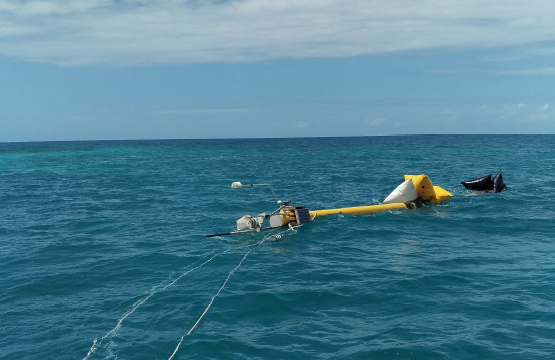 |
Meetings
● Dr. Chris Kelble is serving on the review panel for the ecosystem review of the Pacific Island Fisheries Science Center. He will be attending the review all week in Honolulu, HI.
Seminars
● Dr. Chris Kelble presented the Biscayne Bay Habitat Focus Area's Implementation Plan to the NOAA Habitat Conservation Team (NHCT) last Friday, April 1. The NHCT liked the presentation and will review the draft implementation plan within the next 2 weeks and return it to the Biscayne Bay Habitat Focus Area.
Opportunities in OCED
● OCED is currently seeking a post-doc in the Gulf of Mexico Integrated Ecosystem Assessment Program.
This project will involve the integration of marine ecosystem indicators with human dimensions to examine
the impact of management on the production of ecosystem services and the testing of alternative management
and climate scenarios.
Qualifications:
➤ Must have a Ph.D. in marine ecology, systems ecology, marine resource economics, marine sociology,
marine anthropology, or a related field.
➤ The successful candidate should have experience with integrated ecosystem assessments, indicator
development, coastal marine ecology, risk assessments, and management strategy evaluations, as well as with
the synthesis and analysis of human dimensions and biophysical data.
➤ A strong publication record, strong computer skills, the ability to work with large amounts of data,
and familiarity with interdisciplinary ecosystem analysis are required.
March 28, 2016
Manuscripts
● Dr. Rik Wanninkhof is co-author on the recently accepted paper in Geophysical Research Letters authored by Nancy Williams et al. and entitled "Empirical Algorithms to Estimate Water Column pH in the Southern Ocean" (2016GL067727). The paper provides a creative and powerful means to validate biogeochemical sensors on Argo floats. Nancy Williams is a graduate student at Oregon State who got her start in oceanography as a Hollings scholar at AOML.
Field Work
● Dr. Leticia Barbero and Bob Castle are continuing their work on the I09N research cruise. Leticia is serving as chief scientist and Bob is in charge of the DIC sampling on the cruise.
● Lindsey Visser served as chief scientist on the R/V Walton Smith last week. This cruise was done in conjunction with the Marine Biodiversity Observing Network (MBON) project out of the University of South Florida. AOML scientists were responsible for sampling water quality during the cruise and investigating biological oceanographic phenomena around south Florida.
Meetings
● Dr. Jim Hendee met with Drs. Richard Dodge, Bernard Riegl, Abby Renegar, Nicole Fogarty, Jose Lopez, and Steve Miller of Nova Southeastern University's (NSU) National Coral Reef Institute (NCRI) to discuss collaborations in coral ‘omics in the coming year. Also present was Dr. Steve O'Brien of the Theodosius Dobzhansky Center for Genome Bioinformatics in St. Petersburg, Russia, who discussed NSU's new program for gene research at their new Cell Therapy Institute, which he will help lead after he leaves the Dobzhansky Center. Dr. O'Brien indicated a willingness to help us find good candidates for a bioinformatics hire, and also in conducting our coral ‘omics work. NCRI will undertake sequencing of some our coral samples. The group also discussed a collaborative plan to conduct sampling off of Port Everglades before expansion of the Port begins.
● Dr. Lew Gramer a CIMAS researcher with CHAMP in OCED, attended a workshop this week hosted by NASA, the intergovernmental Sargasso Sea, and NOAA Sanctuaries. The workshop, held at the Eco-Discovery Center in Key West, brought researchers together with policy makers from the Caribbean, Bermuda, USA, UK and Commonwealth, Canada, and the UN. The goal was to prioritize research application areas for remote sensing and in situ observing programs to improve the conservation of the Sargasso Sea and surrounding waters.
Seminars
● Dr. Xaymara Serrano (OCED) served as panelist in the graduate career panel hosted at NOVA's Oceanographic Center in Fort Lauderdale on March 23rd. The goal of this panel was to speak to graduate students about what it takes to have a career in marine biology, what people look for when hiring, what skills or courses students should be encouraged to learn/take and any additional tips/anecdotes that may help students be successful in graduate school and beyond. The other 5 panelists that participated in this event were: Laura Gesselbracht (Nature Conservancy Senior Marine Scientist). Pat Quinn (Broward county Natural Resource Specialist), Cheryl Miller (Coastal Eco-Group Principal Scientist), Lauren Waters (Florida Department of Environmental Protection) and Steven Miller (NOVA Senior Research Scientist).
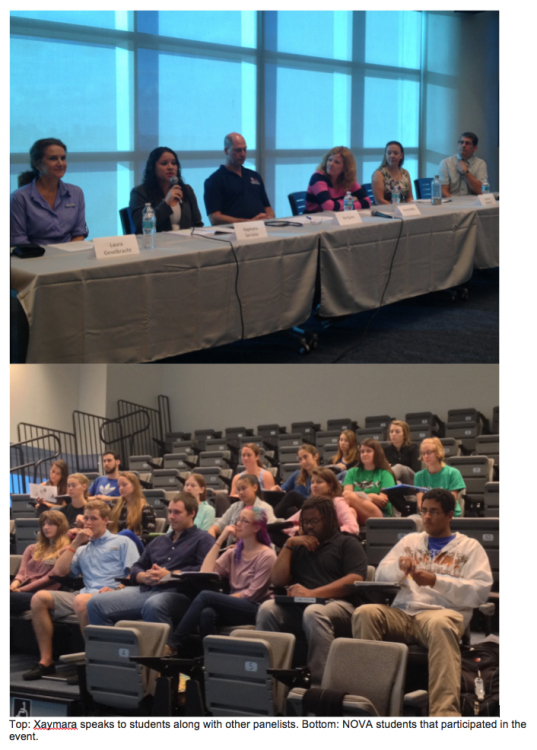 |
March 21, 2016
Field Work
● Dr. Leticia Barbaro and Robert Castle are participating on the second leg of the GO-SHIP Indian Ocean Cruise (IO9N). Leticia is the chief scientist overseeing the activities of 30 scientists and Bob is leading the effort to measure changes in inorganic carbon in this remote region. The effort is sponsored by the Climate Observation Divsion of NOAA's Climate Program office.
March 14, 2016
Field Work
● Chuck Featherstone is over halfway through the GO-SHIP Indian Ocean I8S cruise and continues to produce quality inorganic carbon measurements.
● Lindsey Visser and Charline Quenee sampled water quality in Biscayne Bay and its major canals on March 10 and 11 aboard the R/V Virginia K. This sampling was conducted as part of the Biscayne Bay Habitat Focus Area.
● Lindsey Visser is serving as chief scientist this week on the South Florida Project cruise aboard the R/V Walton Smith. They will be sampling water quality and biological oceanographic characteristics from Biscayne Bay down through the Keys and up the southwest Florida shelf to Charlotte Harbor.
● NOAA's Ocean Acidification Program funded the installation of a new MAPCO2 buoy in Fagatele Bay National Marine Sanctuary, American Samoa (Figure 1), establishing the 2nd NCRMP class III sentinel climate and ocean acidification monitoring site in the Pacific. Installation will commence in 2017 and be led by OCED PIs Dr. Derek Manzello and Dr. Ian Enochs in collaboration with the Coral Reef Ecosystems Program of the Pacific Islands Fisheries Science Center in Honolulu and PMEL in Seattle. Dr. Manzello and Dr. Enochs visited American Samoa in February 2014 and ID'ed the location for the deployment of the sentinel ocean acidification monitoring site from four different candidate locations (Figures 2 and 3). Ongoing discussions will determine which Fagatele Bay site is best. This is the second of three planned class III sites in the Pacific. The other operational site is at Kaneohe Bay, Hawaii and the final planned site is for Saipan in the Mariana Islands. There are currently two class III sites operational in the Atlantic: La Parguera, Puerto Rico and Cheeca Rocks in the Florida Keys. The third site in the Atlantic is planned for Flower Garden Banks.
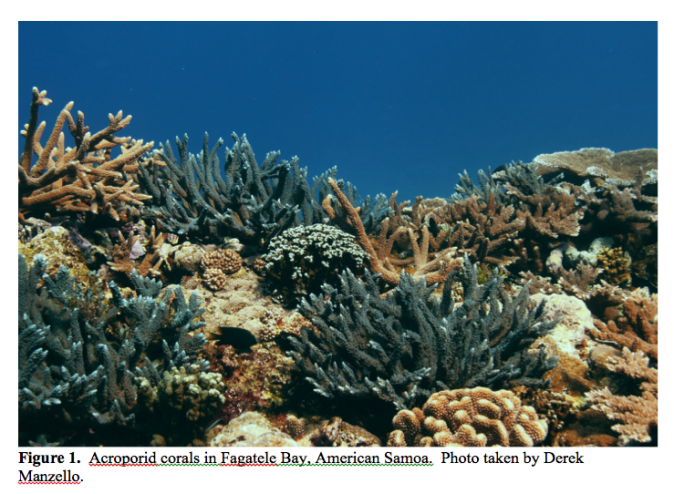 |
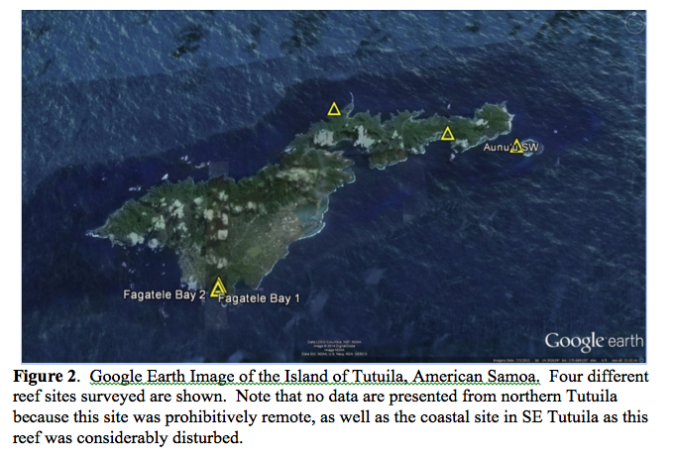 |
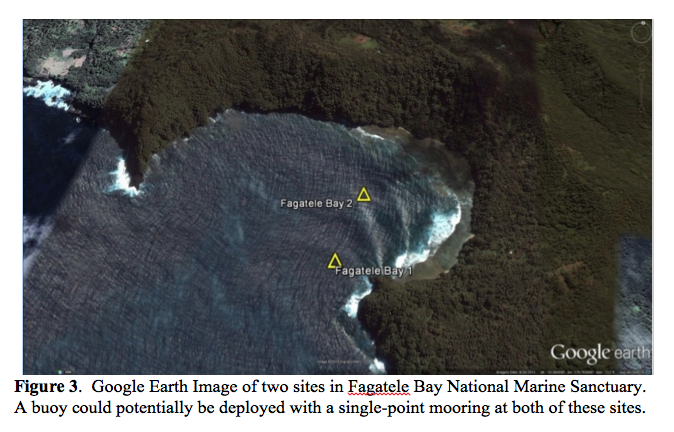 |
Meetings
● Dr. Xaymara Serrano will travel to Portland, Maine during March 15-20th to attend the 45th Benthic Ecology meeting and give an oral presentation. Her talk is entitled "Effects of eutrophication and elevated sea surface temperatures on the early life stages of a threatened Caribbean coral".
● Dr. Christopher Kelble is presenting the Gulf of Mexico Integrated Ecosystem Assessment work to date and serving on a panel at the Southeast Fisheries Science Center Ecosystem Review on March 15. The panel will focus on integrated ecosystem assessments and approaches to ecosystem modeling.
March 7, 2016
Manuscripts
● Dr. Rik Wanninkhof is a co-author on two manuscripts submitted to GRL. The first is "Empirical Algorithms to Estimate Water Column pH in the Southern Ocean" led by N. Williams (U. Oregon) et al. The second is "A comparative assessment of air-water CO2 flux in a freshwater dominated open estuary versus a mangrove dominated semi-closed salt-water estuary" led by Dr. Akhand (School of Oceanographic Studies, Jadavpur University, West Bengal, India) et al.
Field Work
● Chuck Featherstone is about halfway through the GO-SHIP Indian Ocean I8S cruise and continues to produce quality inorganic carbon measurements.
Dr. Denis Pierrot visited the RCCL Ship Equinox in Port Everglades for a maintenance check prior to her trans-Atlantic crossing to execute the summer cruise schedule in the Mediterranean. Data transmission occurs daily and data quality is checked on the following graphical user interface.
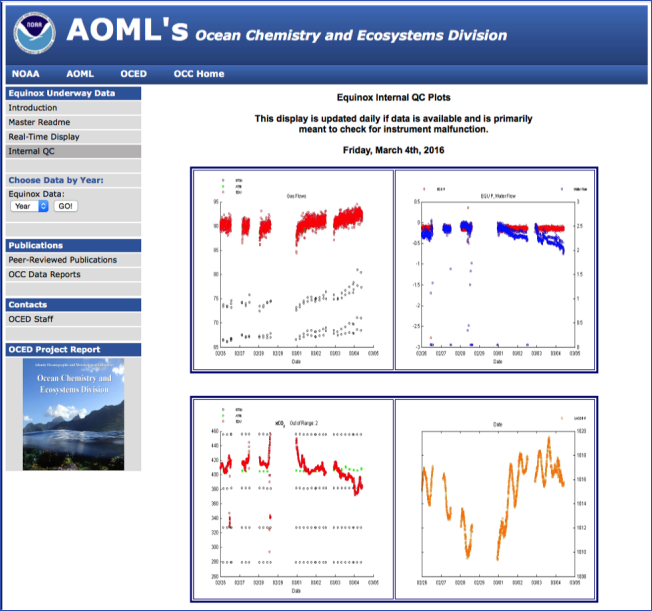 |
Renee Carlton, Lauren Valentino, and Dr. Derek Manzello traveled to the Florida Keys from March 1-3 to swap out pH and light loggers at two sites in the Lower Florida Keys and two sites in the Upper Florida Keys. Qualitative observations indicated that the corals had completely regained all of their pigment and color following the back-to-back warm-water bleaching in 2014 and 2015. Further work will determine how much mortality occurred.
Lindsey Visser and Charline Quenee will be sampling water quality in Biscayne Bay and its major canals on March 8 and 9 aboard the R/V Virginia K. This sampling is being conducted as part of the Biscayne Bay Habitat Focus Area.
Meetings
● Dr. Chris Kelble attended NOAA's Integrated Ecosystem Assessment Program Annual Meeting in Boulder, CO February 29 - March 4. This year's meeting was focused on developing national and international collaborations and determining how the IEA process fits into the broader ecosystem-based management landscape.
Seminars
● Dr. Maribeth Gidley was an invited speaker at University of Miami's Cooper Fellowship Training Series, "Empowering Capable Climate Communicators." Her lecture was entitled "Health and Disease Concerns Associated with Sea-Level Rise and a Changing Climate"
February 29, 2016
Awards
● General Prayut Chan-O-Cha, Prime Minister of Thailand, honored Dr. Natchanon Amornthammarong along with approximately 10 other Thai people working in the USA for their technological innovation. The honor was awarded to Dr. Amornthammarong as part of the Prime Minister's visit to meet with President Obama at the ASEAN summit in Sunnylands, CA. Dr. Amornthammarong was told that the Thai government thinks his scientific contributions could help with environmental problems in Thailand. Dr. Amornthammarong was also invited to give oral presentations to Thai universities and government units about his published works when he visits Thailand this June. These talks will focus on Dr. Amornthammarong's ammonia and DIC instruments.
Manuscripts
● The manuscript entitled "Long distance dispersal and vertical gene flow in the Caribbean brooding coral Porites astreoides", by Xaymara M. Serrano (OCED), Iliana B. Baums (Penn State), Tyler B. Smith (UVI), Ross J. Jones (AIMS), Tonya L. Shearer (Georgia Tech) and Andrew C. Baker (RSMAS), was published in the February 22 issue of the Nature's journal Scientific Reports. The authors studied the common Caribbean coral species Porites astreoides at three sites in Florida (the Upper Keys, Lower Keys and Dry Tortugas), Bermuda, and the USVI and used genetic methods to discover whether reefs in shallow water might be able to recover from these disturbances by recruiting new coral larvae from deeper, more intact populations of corals. Overall, the study showed that Florida deep water corals are not closely related to shallow corals elsewhere in the region, and that corals on shallow reefs can be more closely related to other shallow corals over a thousand miles away than they are to corals on the same reef just a few dozen feet deeper. The paper is available open access and can be accessed at: www.nature.com/articles/srep21619.
Ocean Carbon Cycle
● Chuck Featherstone continues to conduct the GO-SHIP I8S cruise on the R/V Roger Revelle. Chuck Featherstone is analyzing inorganic carbon concentrations in seawater. They have encountered Southern Ocean storms with 60+ Knot sustained winds and 30 foot seas. During one of these storms at station 14, which is located at 62°S, the wire parted and the CTD was lost of the side. They installed the back-up CTD and continued conducting their sampling
Meetings
● Charline Quenee and Dr. Chris Kelble are attending NOAA's Integrated Ecosystem Assessment Program Annual Meeting in Boulder, CO this week. This year's meeting is focused on developing national and international collaborations and determining how the IEA process fits into the broader ecosystem-based management landscape.
Seminars
● Dr. Kelly Goodwin taught a lecture for the UC San Diego course Marine Microbiology SIO126 "Monitoring Harmful Microbes in the Marine Environment" on February 24, 2016.
● Dr. Chris Kelble taught a lecture for the University of Miami undergraduate course "The science of Biscayne Bay" on February 22, 2016.
● Dr. Maribeth Gidley presented the seminar "Zika virus and other mosquito-borne illnesses at home and for travelers" on February 29 at 3pm in the First Floor Conference Room.
February 22, 2016
Manuscripts
Dr. Ruben Van Hooidonk co-authored two papers that were published this week in Philosophical Transactions of the Royal Society B: Biological Sciences:
● Eisenlord, M.E., Groner, M.L., Yoshioka, R.M., Elliott, J., Maynard, J., Fradkin, S., Turner, M., Pyne, K., Rivlin, N., van Hooidonk, R., Harvell, C.D., 2016. Ochre star mortality during the 2014 wasting disease epizootic: role of population size structure and temperature. Philos. Trans. R. Soc. London B Biol. Sci. 371.
Summary: Over 20 species of asteroids were devastated by a sea star wasting disease (SSWD) epizootic, linked to a densovirus, from Mexico to Alaska in 2013 and 2014. For Pisaster ochraceusboth laboratory experiments and observed temperature anomalies indicate that anomalously warm summer temperatures increased the disease progression and mortality rates in Washington State.
● Maynard, J., van Hooidonk, R., Harvell, C.D., Eakin, C.M., Liu, G., Willis, B.L., Williams, G.J., Groner, M.L., Dobson, A., Heron, S.F., Glenn, R., Reardon, K., Shields, J.D., 2016. Improving marine disease surveillance through sea temperature monitoring, outlooks and projections. Philos. Trans. R. Soc. London B Biol. Sci. 371.
Summary: To forecast marine disease outbreaks as oceans warm requires new environmental surveillance tools. In this paper we describe an iterative process for developing these tools. The first step is to identify candidate host–pathogen systems. The 24 candidate systems we identified include sponges, corals, oysters, crustaceans, sea stars, fishes and sea grasses (among others). To illustrate the other steps, we present a case study of epizootic shell disease (ESD) in the American lobster. Increasing prevalence of ESD is a contributing factor to lobster fishery collapse in southern New England (SNE), raising concerns that disease prevalence will increase in the northern Gulf of Maine under climate change. The lowest maximum bottom temperature associated with ESD prevalence in SNE is 12°C. Our seasonal outlook for 2015 and long-term projections show bottom temperatures greater than or equal to 12°C may occur in this and coming years in the coastal bays of Maine.
Meetings
Drs. Chris Sinigalliano, Derek Manzello, Ian Enochs, Denis Pierrot, Leticia Barbero, Maribeth Gidley, and student intern Kristina Thoren will be attending the 2016 Ocean Sciences Meeting this week in New Orleans, where they will be presenting their research. The presentation titles are:
● Dr. Derek Manzello – "Galapagos coral reef persistence after ENSO warming across an acidification gradient."
● Dr. Chris Sinigalliano - "Metagenomic Investigation of the Microbial Community Structure and Diversity for Sentinel Coral Reefs and Urbanized Coastal Waters in Southeast Florida, and Molecular Microbial Source Tracking to Characterize Potential LBSP Microbial Contaminant Influences."
● Dr. Ian Enochs – "Volcanic Acidification of a Coral Reef at Maug Island: Influences on Biological Processes and Ecosystem Structure."
● Dr. Maribeth Gidley - "Characterizing Microbial Water Quality of Extreme Tide Floodwaters Discharged from an Urbanized Subtropical Beach: Case Study of Miami Beach with Implications for Sea Level Rise and Public Health."
● Kristina Thoren - "A Molecular MST Approach to Investigate Fecal Indicator Bacteria in Bioaerosols, Bathing Water, Seaweed Wrack, and Sand at Recreational Beaches."
Rik Wanninkhof attended the International ocean coordination project (IOCCP) SC meeting in New Orleans this past weekend.
Drs. Denis Pierrot, Leticia Barbero, and Rik Wanninkhof attended the NOAA/CPO/COD ocean carbon meeting in New Orleans this past weekend.
Dr. Kelly Goodwin participated in the Interagency Working Group on Ocean Partnerships (IWG-OP) Biodiversity Ad Hoc Meeting on January 28, 2016. The Biodiversity working group advises and assists the Subcommittee on Ocean Science and Technology (SOST) as part of the partnership efforts begun under the National Oceanographic Partnership Program (NOPP). The group was briefed on study results detailing federal research investment in microbiome research. The study was undertaken by the Mapping the Microbiome Fast-Track Action Committee, co-chaired by Elizabeth Stulberg of the Whitehouse Office of Science and Technology Policy (OSTP) and of which Dr. Goodwin is a member. The study found that the most commonly reported need in microbiome research across the federal agencies was computation/modeling/bioinformatics. Full results can be found in a paper in the January 2016 issue of Nature Microbiology.
Upcoming Seminars
Dr. Maribeth Gidley will be presenting "Zika virus and other mosquito-borne illnesses at home and for travelers" on February 29 at 3pm in the First Floor Conference Room.
February 16, 2016
Ocean Carbon Cycle
● The Science Plan for Carbon Cycle Research in North American Coastal Waters was released (http://www.us-ocb.org/publications/CCARS_Sci_Plan_FINAL.pdf) and included a nice acknowledgement to AOML contributions: "including extensive contributions from scientists at the NOAA Atlantic Oceanographic and Meteorological Laboratory."
● Dr. Denis Pierrot returned from Fremantle, Australia where he successfully installed an underway pCO2 system on the R/V Revelle and assisted with installing and unpacking the laboratory container in preparation for the GO-SHIP 18S cruise.
● Mr. Chuck Featherstone is aboard the R/V Revelle, which embarked on the GO-SHIP I8S cruise on February 9. Chuck will be analyzing inorganic carbon concentrations in seawater during the cruise. The cruise is en route to their first station at 60 S and have encountered their first Southern Ocean storm with 60+ Knot sustained winds and 30 foot seas.
Ecosystem Assessment and Modeling
● Dr. Chris Kelble is presenting a webinar today as part of the State of Florida's State of the Coast presentation series. The Florida State of the Coast program aims to develop an assessment of Florida's coastal ecosystems to inform the next round of planning for coastal zone management in Florida. Dr. Kelble will be presenting on NOAA's ecosystem assessment efforts in Florida, including his work on Integrated Ecosystem Assessments, Everglades Restoration, and Marine and Estuarine Goal-Setting (MARES).
February 8, 2016
Meetings
● Drs. Lew Gramer and Chris Sinigalliano participated in the CoastWatch/OceanWatch Science Meeting hosted by PhOD in cooperation with NESDIS/NCCOS. Dr. Gramer gave a presentation entitled Better Living Through Physics: Site-specific ecological assessments for coral reef thermal stress and Dr. Sinigalliano gave a presentation entitled A Summary of Remote Sensing for Water Quality Monitoring and Research: Applications, Needs, & Future Trends.
Ocean Carbon Cycle
● The ocean carbon group submitted 237 datasets of underway pCO2 data (SOOP-CO2) to the Surface ocean carbon atlas (SOCAT) version 4 effort. SOCAT will start to release the global quality controlled surface CO2 data annually. AOML is a major contributor and participant in quality control and management of the effort that now receives several million new datapoints from over 80 international investigators annually.
● Dr. Rik Wanninkhof submitted the revised version of the white paper An evaluation of pH and NO3 sensor data from SOCCOM/ARGO floats and their utilization to develop ocean inorganic carbon products to the carbon working group. The paper provides recommendations on quality control and product development of the new biogeochemical sensors on profiling floats.
Ecosystem Assessment and Modeling
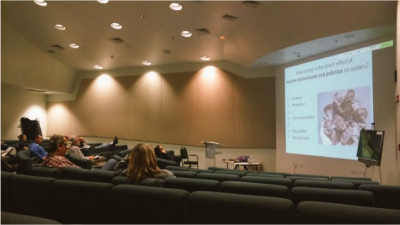
● An expert opinion workshop was completed last week with staff and researchers from Rookery Bay. This is part of the NOAA COCA sponsored project investigating the resilience of ecosystem services to climate change in South Florida. Engaging the management community early and using their knowledge in scientific analyses is essential to developing scientific decision support tools that they will trust and use.
February 1, 2016
Coral Health and Monitoring
● The manuscript entitled Long distance dispersal and vertical gene flow in the Caribbean brooding coral Porites astreoides, by Xaymara M. Serrano (OCED), Iliana B. Baums (Penn State), Tyler B. Smith (UVI), Ross J. Jones (AIMS), Tonya L. Shearer (Georgia Tech) and Andrew C. Baker (RSMAS), was accepted for publication in the journal Scientific Reports. This paper represents the first assessment of genetic connectivity for the coral species Porites astreoides in the tropical and subtropical western Atlantic. Overall, findings suggest that P. astreoides is effective at dispersing both horizontally and vertically despite its brooding reproductive mode and maternal transmission of algal symbionts. In addition, these findings might help explain the ecological success reported for P. astreoides in the Caribbean in recent decades.
Ecosystem Assessment and Modeling
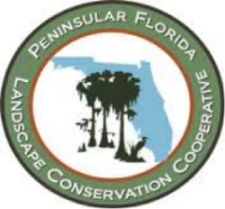
● Dr. Chris Kelble has been asked to join the steering committee for the Peninsular Florida Landscape Conservation Cooperative. The Peninsular Florida Landscape Conservation Cooperative (PFLCC) is part of a national network of Landscape Conservation Cooperatives (LCCs). LCCs are applied conservation science partnerships among federal agencies, regional organizations, states, tribes, NGOs, private stakeholders, universities and other entities within a geographic area. They are designed to inform resource management decisions in an integrated fashion across landscapes at a broader scale than any individual partner's responsibility. The partnership considers landscape-scale stressors, including climate change, habitat fragmentation, invasive species, and water scarcity as it attempts to provide a vision for a landscape capable of sustaining healthy populations of fish, wildlife, plants and cultural resources.
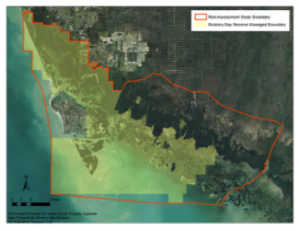
● Charline Quenee, Dr. Pamela Fletcher, and Dr. Chris Kelble are leading a workshop to elicit expert opinion regarding the Rookery Bay ecosystem. This expert opinion will be used by Dr. Geoffrey Cook (UCF and formerly with CIMAS/OCED) to develop a semi-quantitative risk assessment for this ecosystem, which includes risk to the delivery of ecosystem services. Ecosystem services are the benefits provided to human society by the ecosystem. This project aims to assess the resiliency of the coastal ecosystem and services it provides under likely climate change scenarios.
Environmental Microbiology
● Dr. Kelly Goodwin taught a lecture entitled Pathogens, Indicators, and Biosensing for a graduate level Marine Biotechnology course at the Scripps Institute of Oceanography.
● Dr. Kelly Goodwin participated in the Interagency Working Group on Ocean Partnerships (IWG-OP) Biodiversity Ad Hoc Meeting on January 28, 2016. The Biodiversity working group advises and assists the Subcommittee on Ocean Science and Technology (SOST) as part of the partnership efforts begun under the National Oceanographic Partnership Program (NOPP). The group was briefed on study results detailing federal research investment in microbiome research. The study was undertaken by the Mapping the Microbiome Fast-Track Action Committee, co-chaired by Elizabeth Stulberg of the Whitehouse Office of Science and Technology Policy (OSTP) and of which Dr. Goodwin is a member. The study found that the most commonly reported need in microbiome research across the federal agencies was computation/modeling/bioinformatics. Full results can be found in a paper in the January 2016 issue of Nature Microbiology.
January 25, 2016
Coral Health and Monitoring
● CIMAS researcher Dr. Lew Gramer (CHAMP/OCED) presented as a panelist at the 10th Anniversary Symposium for The Nature Conservancy's Florida Reef Resilience Program on Thursday, January 21, 2015. His topic was Better Living Through Physics: Mapping reef resilience with site-specific ecological forecasts for coral thermal stress. The agenda included speakers from academia, State and local agencies, conservation NGOs, regional stakeholders, NOAA National Marine Sanctuaries, and NOAA NESDIS. Panel discussion centered on analyses of the unique 10-year FRRP record of robust, replicate sampling of coral bleaching, disease, and mortality throughout the 400 km-long Florida Reef Tract.
● OCED responded to a recent Call for Ocean Technology Development Proposals by submission of these three proposals:
1. Cost-effective Sub-surface Automated Sampler (SAS) for field-based ocean acidification research in shallow marine ecosystems. Enochs I.C., Manzello D.P., Hendee J.C. $432K
2. Integration of Novel Nitrogen, Turbidity, and Temperature Sensors with Coral Reef Early Warning System Network. Amornthammarong N., Hendee J.C. $501K
3. Developing New Platforms for a Joint CREWS-OA Network Throughout the Non-U.S. Caribbean. Hendee J.C., Sutton A., Manzello D.P. $587K
● On Friday January 22, Jack Stamates, Mike Shoemaker and Lt Mark Weekley met with representatives from the City of Dania Beach to discuss the establishment of a CREWS/ICON station on the Dania pier. This station will measure atmospheric and ocean parameters and provide pier users access to this information via an on site display and a web portal.
Ecosystem Assessment and Modeling
● The manuscript entitled Circulation and water renewal of Florida Bay, by T. Lee (RSMAS), N. Melo (CIMAS), N. Smith (HBOI), E. Johns (PHOD), C. Kelble (OCED), R. Smith (PHOD), and P. Ortner (UM), was accepted for publication in the Bulletin of Marine Science. This paper synthesizes results from a multi-year study of the circulation and exchange processes controlling transport and water renewal in Florida Bay. Wind forcing is shown to be the primary driver of the circulation, and exchange times are computed for each subregion. A practical solution to control hypersalinity, seagrass die-off and water quality degradation of Florida Bay is proposed.
January 18, 2016
Ocean Carbon Cycle
● The following review paper has been published: Talley, L.D. Talley, R.A. Feely, B.M. Sloyan, R. Wanninkhof, M.O. Baringer, J.L. Bullister, C.A. Carlson, S.C. Doney, R.A. Fine, E. Firing, N. Gruber, D.A. Hansell, M. Ishii, G.C. Johnson, K. Katsumata, R.M. Key, M. Kramp, C. Langdon, A.M. Macdonald, J.T. Mathis, E.L. McDonagh, S. Mecking, F.J. Millero, C.W. Mordy, T. Nakano, C.L. Sabine, W.M. Smethie, J.H. Swift, T. Tanhua, A.M. Thurnherr, M.J. Warner, J-Z Zhang, 2016. Changes in Ocean Heat, Carbon Content, and Ventilation: Review of the First Decade of Global Repeat Hydrography (GO-SHIP). Annual Review of Marine Science, 8, 19.1-19.31, 10.1146/annurev-marine-052915-100829
● The AOML ocean carbon group hosted a training workshop on the autonomous pCO2 system on ships of opportunity (SOOP-CO2). Representatives from five institutions working on CPO/COD and OAP sponsored SOOP-CO2 efforts attended the two-day workshop which took place on January 20 - 21.
Environmental Microbiology
● The following paper has been published: Stulberg, Elizabeth, Deborah Fravel, Lita M. Proctor, David M. Murray, Jonathan LoTempio, Linda Chrisey, Jay Garland, Kelly Goodwin, Joseph Graber, M. Camille Harris, Scott Jackson, Michael Mishkind, D. Marshall Porterfield and Angela Records. An assessment of US microbiome research. Nature Biology. Consensus Statement, published January 11, 2016, Article Number 15015, DOI: 10.1038/NMicrobiol.2015.15.
Environmental Microbiology
● The following paper has been published: Stulberg, Elizabeth, Deborah Fravel, Lita M. Proctor, David M. Murray, Jonathan LoTempio, Linda Chrisey, Jay Garland, Kelly Goodwin, Joseph Graber, M. Camille Harris, Scott Jackson, Michael Mishkind, D. Marshall Porterfield and Angela Records. An assessment of US microbiome research. Nature Biology. Consensus Statement, published January 11, 2016, Article Number 15015, DOI: 10.1038/NMicrobiol.2015.15.
Coral Health and Monitoring
● Scientists from OCED submitted the following abstracts to the 13th International Coral Reef Symposium:
Brainard R., Vargas-Angel B., Williams I., Oliver T., Rooney J., Edwards P., Kimball J., Cohen A., Smith J., Toonen R., Price N., Feely R., Alin S., Sutton A., Manzello D., Enochs I., Knowlton, Paulay G., Rohwer F. Large-scale, long-term interdisciplinary ecosystem assessment and monitoring of the U.S. Pacific Islands to support ecosystem-based management and conservation. Session 60: Integrated ecosystem-based management for coral reefs and the value of socio-ecological studies.
Enochs I., Manzello D., Kolodziej G., Noonan S., Valentino L., Fabricius K. Micro-CT analysis reveals depressed net calcification due to enhanced bioerosion and reduced accretion of reef substrata at co2 seeps. Session 32: Ocean acidification: Measuring and scaling impacts across multiple scales.
Fong P, Baker A, Glynn P, Manzello D, McGillis W, Smith T. Why are Some Eastern Tropical Pacific reefs so resilient to ENSO? Bioassays reveal increased herbivory and nutrient limitation of dominant macroalgae during ENSO. Session 23: Global change impacts on coral reef seaweeds.
Gintert B., Carlton R., Kolodziej G., Jones P., Enochs I., Gleason A., Gracias N., Reid P., and Manzello D. Image mosaics before and after the 2014 mass coral bleaching at cheeca rocks, florida keys reveal high resilience with low partial and total coral mortality. Session 30: Coral bleaching: monitoring, management responses and resilience.
Gramer L.J., Hendee J.C., and Thompson N.B. Better living through physics: mapping reef resilience with site-specific ecological forecasts for coral thermal stress. Session 50: Modeling and computational tools for coral reef management and conservation.
Groves S., Brandt M., Manzello D., Enochs I., Holstein D., and Smith T. Physical drivers of community structure and growth among mesophotic coral ecosystems in St. Thomas, US Virgin Islands. Session28A: Coral reefs in extreme, compromised and marginal environments, and their roles as refugia - highly stressed, urbanized and exposed reef systems.
Jones P., Gintert B., Carlton R., Kolodziej G., Valentino L., Gleason A., Jankulak M., Enochs I., and Manzello D. Landscape patters of symbiodinium community dynamics in orbicella faveolata during and after back-to-back mass bleaching events in 2014 and 2015 at cheeca rocks in the Florida Keys. 30 - Coral bleaching: monitoring, management responses and resilience.
Kimball J., Brainard B.,Monaco M., Bohnsack J., Clark R., Schull J., Manzello D., Enochs I., Oliver T., Williams I., Vargas-Ángel B., Blondeau J., Edwards P., Eakin M., Kelsey H., Donovan C., and Koss J. NOAA'S National Coral Reef Monitoring Program: Integrated ecosystem monitoring and reporting in U.S. coral reef areas to inform conservation and management. Session 60: Integrated ecosystem-based management for coral reefs and the value of socio-ecological studies.
Manzello D., Enochs I., Carlton R., Kolodziej G., Valentino L., Gintert B., Dixon G., Towle E., Jones P., Kenkel C., and Matz M. Environmental and biological factors associated with coral reef resilience in the florida keys. Session28a: Coral reefs in extreme, compromised and marginal environments, and their roles as refugia - highly stressed, urbanized and exposed reef systems.
McGillis W., Manzello D., Takeshita Y., Smith T., Martz T., Fong P., Smith J., Baker A., Glynn P., Price N., Mate J., Brandtneris V., Hsueh Y., Palacio A., Markowitz M., and Donham E. In situ metabolism, solar heating, and convective cooling of corals in reef environments. Session 36: Assessing and addressing the effects of multiple stressors on coral reefs towards developing effective management and policy responses.
Schein K., Camp M., Gramer L.J., Hendee J.C., Foster K., Manfrino C. Hetzinger S. and Huges H. Comparing in situ and satellite-based water temperature data over tropical coral reefs: implications for environmental monitoring and ecological forecasting.
Serrano X., Baker A., Miller M., and Hendee J.C. Effects of eutrophication and elevated sea surface temperatures in the early life stages of an endangered Caribbean coral. Session 36: Assessing and addressing the effects of multiple stressors on coral reefs towards developing effective management and policy responses.
Smith T., Baker A., Brandtneris, V., Glynn, P., Manzello D., Mate, J., McGillis W., Palacio A., and Fong P. Bleaching and depth refuges in the eastern pacific during the strong 2015-2016 El Niño. Session28A, Coral reefs in extreme, compromised and marginal environments, and their roles as refugia highly stressed, urbanized and exposed reef systems.
van Hooidonk, Ruben, Jeffrey Maynard, Jerker Tamelander, Jamison Gove, Gabriella Ahmadia, Laurie Raymundo, Gareth Williams, and Scott Heron. Downscaled projections of coral bleaching conditions that can inform conservation planning.
January 11, 2016
Ocean Carbon Cycle
● Dr. Leticia Barbero was in Charleston, SC, January 11 thru January 13 to attend the first SOCAN (Southeast Ocean and Coastal Acidification Network) in-person meeting. Among others, the objectives of the meeting were to identify why the Southeast region is unique and the region's vulnerabilities to OA and summarize why Ocean Acidification matters to stakeholders.
● The following paper was accepted for publication in Global Biogeochemical Cycles: Woosley, R. J., F. J. Millero, and R. Wanninkhof, 2015: Rapid Anthropogenic Changes in CO2 and pH in the Atlantic Ocean: 2003-2014. Global Biogeochem. Cycles, accepted, Jan 2015.
Coral Health and Monitoring
● Derek Manzello presented a seminar to the Florida Keys National Marine Sanctuary on January 11 about the past and ongoing work of OCED's Acidification, Climate, and Coral Reef Ecosystems TEam (ACCRETE).
Ecosystem Assessment and Modeling
● Lindsey Visser, Charline Quenee, and Dr. Libby Johns (PhOD) completed the most recent survey of water quality in south Florida aboard the R/V Walton Smith. This data is being analyzed to examine long-term trends in nutrients, and chlorophyll a in south Florida.
● Dr. Chris Kelble attended the Atlantic Ocean Research Alliance (AORAC) workshop on Making the Ecosystem Approach Operational. This workshop addressed questions that are currently challenging the implementation of the ecosystem approach to management as it moves from single to cross-sectoral application. It also allowed for the exchange of experiences, discussion of encountered constraints, and the identification of approaches and strategies to make this approach operational.
December 18, 2015
Coral Health and Monitoring
● Two CREWS/C5 buoys were deployed in the Dominican Republic. One at Boca Chica on the south side, the other at Puerto Plata on the north side. So far the data appears to be transmitting successfully. The two CREWS/C5 stations in Belize are expected to be deployed in late January or early February, leaving only the Barbados station (currently damaged) of the original network extension remaining to be deployed.
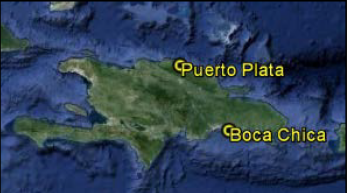 |
● Derek Manzello attended the 2015 AGU Fall Meeting in San Francisco CA. His presentation was entitled Contrasts Galapagos coral reef persistence after ENSO warming across an acidification gradient.
December 11, 2015
Ecosystem Assessment and Modeling
● Chris Kelble presented his analysis of long-term water quality trends in south Florida coastal water to the Florida Keys National Marine Sanctuary Advisory Committee on Tuesday, December 8. Dr. Kelble's analyses have shown that elevated salinity conditions in Florida Bay have resulted in no high recruitment years for juvenile spotted seatrout since 2007. Additionally, increasing trends in soluble reactive phosphorus, which is the limiting nutrient, throughout much of south Florida coastal waters, is a cause for concern, and has resulted in increasing chlorophyll-a in over half of the regions with increasing soluble reactive phosphorous. The Sanctuary Advisory Committee is considering a draft motion requesting that the Comprehensive Everglades Restoration Plan be implemented more quickly.
● Lindsey Visser and Charline Quenee, along with colleagues from SEFSC, surveyed water quality in the canals feeding into Biscayne Bay on December 9 and 10. This is part of the studies being supported by the Biscayne Bay Habitat Blueprint Focus Area. The first goal of the focus area is to understand the sources of nutrients into Biscayne Bay and to propose mitigation strategies to reduce nutrient loading into Biscayne Bay.
December 5, 2015
Ocean Carbon Cycle
● Tobia Tudino, a PhD Student in the College of Life and Environmental Science of the University of Exeter, visited Dr. Rik Wanninkhof to discuss post-doc opportunities in the ocean carbon group.
● The paper entitled Data-based estimates of the ocean carbon sink variability – First results of the Surface Ocean pCO2 Mapping intercomparison (SOCOM), by C. Rödenbeck, D. C. E. Bakker, N. Gruber, Y. Iida, A. R. Jacobson, S. Jones, P. Landschutzer, N. Metzl, A. O. S. Nakaoka, G.-H. Park, P. Peylin, K. B. Rodgers, T. P. Sasse, U. Schuster, J. D. Shutler, V. Valsala, R. Wanninkhof and J. Zeng, was accepted in the journal Biogeosciences on November 27, 2015.
November 27, 2015
Ocean Carbon Cycle
● Rik Wanninkhof visited Bern, Switzerland Nov. 22-29, participating as a working group member at the ESA Satellite Earth Observation for Atmosphere-Ocean Gas Exchange project working group meeting.
Coral Health and Monitoring
● The National Oceanographic Committee of Cuba, together with all its national marine scientific institutions hosted the MarCuba 2015 Symposium in Havana November 16 - 20, 2015. NOAA delegates included Jim Hendee, Ryan Smith, and several SEFSC attendees, including SEFSC Director Bonnie Ponwith. CIMAS Director Peter Ortner was also present, as well as several CIMAS faculty. Dr. Jim Hendee's presentation was entitled Extending the Coral Reef Early Warning System (CREWS) Network Throughout the Caribbean: A Collaborative Project, and was apparently the only presentation that had English together with Spanish translations on each slide (there were no translators for the individual sessions). The presentation elaborated on the combined efforts of the Caribbean Community Climate Change Center, CIMAS, and NOAA in the installation of CREWS stations throughout the Caribbean, utilizing funds from the European Union and the NOAA Coral Reef Conservation Program. Emphasis was made that NOAA's role in any future Cuba station installations would be information management only; however, it was noted that several "virtual station" (i.e., satellite data at specific coral reef areas) have already been implemented on the Coral Health and Monitoring Program's data portal site (www.coral.noaa.gov/champportal). Also, mentioned was that AOML is ready to collaborate in the new "Sister Sanctuary Program" agreement, historically reached by NOAA and Cuba during that week, by implementing a new virtual station at the Guanahacabibes Sanctuary in southwest Cuba (http://www.nationalparks-worldwide.info/cuba.htm).
 |
November 16, 2015
Environmental Microbiology
● A paper entitled From Skin to Soil: An Assessment of US Microbiome Research, by by Elizabeth Stulberg, Deborah Fravel, Lita Proctor, David Murray, Jonathan LoTempio, Linda Chrisey, Jay Garland, Kelly Goodwin, Joseph Graber, M. Harris, Scott Jackson, Michael Mishkind, D. Porterfield, and Angela Records, has been published in the inaugural issue of Nature Microbiology (paper #NMICROBIOL-15090353A). The paper is the consensus paper for the Fast Track Action Committee on Mapping the Microbiome (FTACMM, http://commonfund.nih.gov/hmp/overview). The microbiome is the multi-species community of microbes in a specific environment; microbiome research is the study of these communities with regard to phylogenetic and genetic composition, structure and function and interactions with their hosts or in ecosystems using genome-enabled technologies.
Florida Area Coastal Environment
● Four current meters were recovered off of Broward County on November 12 by LT Marc Weekley, LTJG Ben Vandine, and Mike Jankulak; two acoustic Doppler current profiler (ADCP) units at 22 and 80 foot depths, and two tilt meters (Lowell Instruments TCM-1, www.lowellinstruments.com) at 38 and 70 feet depth. These instruments had been deployed in support of the Numeric Nutrient Criteria Study (Figure 1).
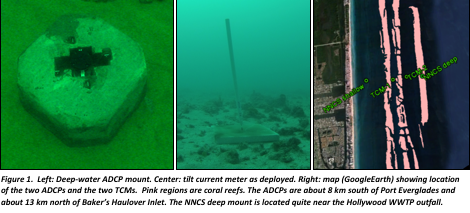 |
November 9, 2015
Coral Health and Monitoring
● From October 26 to November 3, Mike Shoemaker and Mike Jankulak were visiting Belize to install and repair two of the Caribbean Community Climate Change Centre's (CCCCC) buoys. CCCCC is working with OCED's Coral Reef Early Warning System (CREWS) to develop a network of monitoring buoys throughout the Caribbean. All sensors and electronics were installed on the Calabash Caye buoy in cooperation with the University of Belize, and new programming that was developed and tested at AOML in past months was uploaded to the buoy. The second buoy at South Water Caye is part of a collaboration with the Belize Fisheries Department and was visited for a few hours at the end of the trip, during which time power was restored to the buoy and a major communications fault was diagnosed and corrected. Both of these buoys are expected to be redeployed before the end of the year.
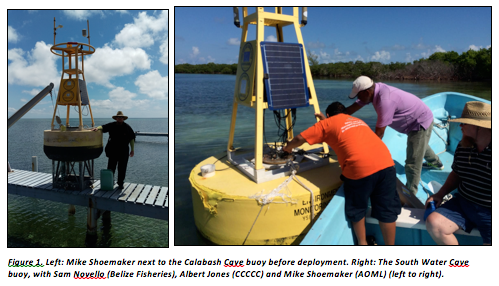 |
Nutrients
● A paper by Hilary Flower, Mark Rains, David Lewis, Jia-Zhong Zhang, and Rene Price entitled Control of phosphorus concentration through adsorption and desorption in shallow groundwater of subtropical carbonate estuary has been accepted for publication in Estuarine, Coastal and Shelf Science. This paper demonstrates how the Everglades coastal groundwater releases more phosphorus from mangrove sediments compared to the upstream freshwater and downstream Florida Bay seawater.
October 26, 2015
Lab 221 Renovation
● The renovation of lab 221 is nearly complete. Equipment is being installed for use by immediate use by the ACCRETE group (Renee Carlton, Ian Enochs, Graham Kolodziej, Derek Manzello, and Lauren Valentino), and by the ERAM (Ecosystem Restoration, Assessment and Modeling) group (Figure 1). Our appreciation to OD for providing the funds for the renovation. This iss the second OCED lab to be renovated.
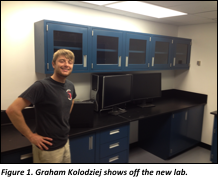 |
Ecosystem Management
● Pamela Fletcher and coworkers have recently published the paper in Global Ecology and Conservation (Fletcher, P.J., M. Spranger, J.C. Hendee, Y. Li, M. Clark, and G.A. Kiker. 2015. Decision tools for coral reef managers: Using participatory decision support to integrate potential climate impacts and informed decision making. Global Ecology and Conservation, 4:491-504, doi:10.1016/j.gecco.2015.09.003).
Coral Health and Monitoring
● Derek Manzello became a member of the editorial board of Nature Scientific Reports following an invitation from the journal.
● Dr. Ruben van Hooidonk visited the University of Oregon on October 23-29 at the request of former OCED director Michelle Wood, presenting a seminar at the University on using climate models to forecast coral reef futures. He gave a talk in her Tropical Marine Ecology class on coral bleaching and ocean acidification. He also gave a presentation on ocean acidification impacts and coral bleaching at the Lubchenco/Menge Lab at Oregon State University in Corvallis.
● The paper entitled Rapid recent warming of coral reefs in the Florida Keys, authored by Derek Manzello, was accepted for publication in Nature Scientific Reports. The recurrence of mass coral bleaching in 2014 (Figure 2), the sixth event since 1987, prompted a reanalysis of temperature data. The summer and winter months of 2014 were the warmest on record for the Florida Keys. The oldest known in-situ temperature record of any coral reef is from the Hens and Chickens Reef in the Florida Keys, which showed significant warming from 1975-2014 (Fig. 2). The average number of days ≥ 31.5 and 32°C per year increased 2670% and 2560%, respectively, from the mid-1990s to present relative to the previous 20 years. In every year after 1994, maximum daily average temperatures exceeded 30.5 and 31°C, respectively. From 1975-1994, temperatures were < 31°C in 61% of the years, and in 44% of the years prior to 1992 temperatures were < 30.5°C. The measured rate of warming predicts the start of annual bleaching between 2020 and 2034, sooner than expected from climate models and satellite-based sea temperatures. These data show that thermal stress is increasing and occurring on a near-annual basis on Florida Keys reefs due to ocean warming from climate change. Ref: Manzello DP (2015), Rapid recent warming of coral reefs in the Florida Keys. Scientific Reports In press.
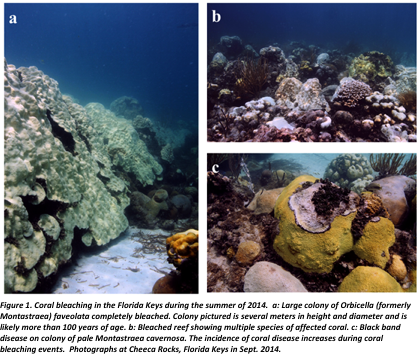 |
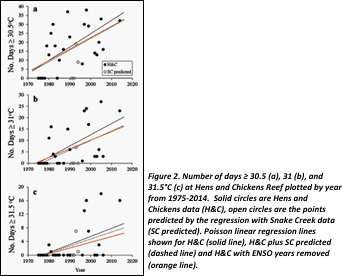 |
October 12, 2015
Ecosystem Restoration, Assessment, and Modeling
● Pamela Fletcher, Charline Quenee and Chris Kelble conducted a workshop with resource managers and scientists in Charlotte Harbor on October 13-14. The meeting with Charlotte Harbor managers and researchers is to elicit expert opinion for developing a network model of the connections between pressure, states, and ecosystem services in the Bay and to ensure the CPO/COCA effort is achieving its objectives.
October 5, 2015
Coral Health and Monitoring
● The poster presentation A comparison of in situ and satellite-based water temperature data over tropical coral reefs: implications for ecological forecasting of coral bleaching has been accepted for the 20th Conference on Integrated Observing and Assimilation Systems for the Atmosphere, Oceans, and Land Surface (IOAS-AOLS), American Meteorological Society, New Orleans, LA, January 10-14, 2016. Karsten Shein (NOAA/NESDIS/NCEI, Asheville, NC), J. Hendee, C. Manfrino, M. Camp, and S. Hetzinger. Abstract: Thermally-driven coral bleaching is a significant contributor to the global decline of coral reefs on which many coastal populations and economies depend, and bleaching forecast models provide valuable guidance to reef managers for implementing monitoring and mitigation activities. Due to the general lack of in situ observations on the world's reefs, bleaching models rely on satellite estimates of sea surface temperature (SST) as a proxy for subsurface water temperatures. However, the accuracy of satellite-based SST in near-shore, shallow (< 30 m) reef zones is uncertain. A number of oceanographic factors may introduce bias that can affect the reliability of ecological forecasts at sub-regional scales. To assess this possibility, a series of water temperature profiles were established on coral reefs around Little Cayman Island to collect simultaneous surface and subsurface temperature data. Data from these profiles are compared to observations from a nearby Coral Reef Early Warning System (CREWS) scientific data buoy as well as satellite observations of SST. This paper details the degree of agreement between the three data sources, evaluates reasons for any discrepancies, and discusses steps toward data integration that can better inform ecological forecasting models for coral bleaching.
● Derek Manzello, Renee Carlton, Lauren Valentino, and Mike Jankulak returned to Cheeca Rocks off of Islamorada, Florida (Figure 1) on October 7-9 to install a new pH sensor on the MapCO2 buoy. They were joined by a colleague from RSMAS, Art Gleason, who is doing photo mosaics for them at Cheeca Rocks. The team also deployed a pH sensor at an inshore patch reef where they are conducting an experiment looking at the impacts of bleaching across the Florida Keys reefs.
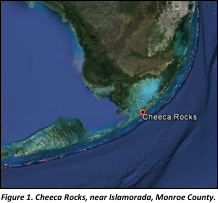 |
September 28, 2015
Turtle Cruise
● The Leatherback Turtle cruise off of Destin, Florida (September 14-25, 2015) was successfully completed. The cruise was conducted with close coordination between a NOAA Twin Otter piloted by Matt Nardi (OMAO) and Alex Johnston (OMAO) and the NOAA vessel R/V Hildebrand captained by Joe Bishop, Ben Vandine and Marc Weekley. During the cruise, they were successful in locating and capturing leatherbacks every day the weather conditions were suitable for operations. The satellite tags will be deployed for up to a year and provide information on location, dive behavior and water temperature. This research is the first to be directed on leatherbacks in the Gulf of Mexico, and these data will be useful in understanding leatherback habitat use, migrations, and distribution in the Gulf of Mexico. In addition to the planned research, cruise participants were able to help out the Gulfarium in Ft Walton Beach (www.gulfarium.com) to release a recently stranded leatherback into an area they knew leatherbacks were foraging (Figure 1). Without the cruise, the Gulfarium would have had to release the leatherback from the beach which would have been less than ideal for the turtle as leatherbacks were foraging 20 miles off the beach. The cruise received good publicity, (http://wuwf.org/post/gulfarium-returns-leatherback-gulf). A video of a turtle release can be seen at https://www.youtube.com/watch?v=hywB2J4T-sM&sns=em. OCED looks forward to future Turtle Cruise collaborations with SEFSC.
Microbiology
● Maribeth Gidley was invited to participate in a Science Cafe on Wednesday September 30th, at the Grove Spot in Coconut Grove (3324 Virginia Street). The event was the fall kickoff for the Centers for Ocean Sciences Education Excellence Florida (COSEEF), is entitled Exploring Health Effects of Miami's Changing Environment, and included four guest speakers: Temitope Alimi, PhD Candidate at University of Miami's Abess Center for Ecosystem Science and Policy (http://cesp.miami.edu), Julie Dick, Staff Attorney at the Everglades Law Center (http://evergladeslaw.org/), Larry Brand, UM/RSMAS, and Maribeth Gidley. More information at http://www.coseeflorida.org/news--events/cosee-fall-series.
● The Microbiology team from AOML joined colleagues from FIU and UM on September 29th to sample extreme tide floodwaters on Miami Beach and to characterize the water quality of the floodwaters that are being pumped back into Biscayne Bay. This multi-institutional effort is being lead by the FIU Southeast Environmental Research Center. AOML conducted molecular microbial source tracking in this effort.
Ecosystem Restoration, Assessment, and Modeling
● Chris Kelble presented the talk Insights from Greater Than 20 Years of Water Quality Monitoring in South Florida to the Florida Keys National Marine Sanctuary Water Quality Protection Program Steering Committee (http://ocean.floridamarine.org/fknms_wqpp/pages/wqpp.html) on September 30th at the City Hall, Key Colony Beach, Marathon. His research has combined data from NOAA, academia, and federal, state, and local government monitoring programs to examine long-term trends in water quality in South Florida. In the Florida Keys this research has showed a consistent increase in soluble reactive phosphorous throughout the Florida Keys waters, including offshore areas.
September 21, 2015
Acidification, Climate, and Coral Reef Ecosystems
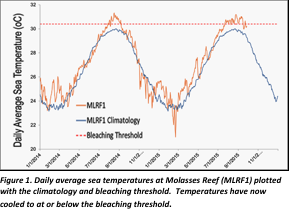
● In response to the 7th mass coral bleaching event which was due to the warmest average sea temperatures to impact the Florida Keys since 1983, members of the Acidification, Climate, and Coral Reef Ecosystems Team (ACCRETE: Renee Carlton, Ian Enochs, Graham Kolodziej, Derek Manzello, and Lauren Valentino) deployed pH, temperature, and light loggers at paired inshore and offshore coral reef sites in the Lower (n=4) and Upper (n=6) Florida Keys from September 21-24. The team also collected 200 tissues samples from the ESA-listed coral species Orbicella faveolata for genetic and lipid analysis. The offshore coral reefs of the Florida Keys have deteriorated dramatically since the late 1970s, whereas the inshore patch reefs have remained resilient and continue to maintain high coral cover. This research will opportunistically utilize the bleaching event to address the five hypotheses for why the inshore patch reefs have been resilient, which are: 1) Thermal acclimatization/adaptation nearshore makes these sites less susceptible to recurrent bleaching, 2) Higher turbidity nearshore leads to 'shading' and thus less impact during heat stress, 3) Higher turbidity suggests the corals could be feeding more, thus allowing them to compensate for the metabolic drain during bleaching, 4) More heat-tolerant zooxanthellae nearshore makes the corals more resistant to bleaching, and finally 5) higher aragonite saturation state inshore could lead to faster growth and resilience with stress. Sea temperatures in the Florida Keys have now declined to near or below the bleaching threshold (Figure 1), thus recovery should begin to commence.
Numeric Nutrient Criteria Study
● On Friday Sept 18th, Benjamin Vandine, Grant Rawson, Aras Zygas (NMFS) and Jack Stamates deployed two Lowell instruments Tilt Current Meters (TCM) from the R/V Cable. These instruments are able to measure water velocities by measuring their orientation with respect to the vertical and to magnetic north. The devices were placed inshore of the Hollywood wastewater outfall, and will augment the data from two Acoustic Doppler Current profilers in place there in support of the Numeric Nutrient Criteria Study.
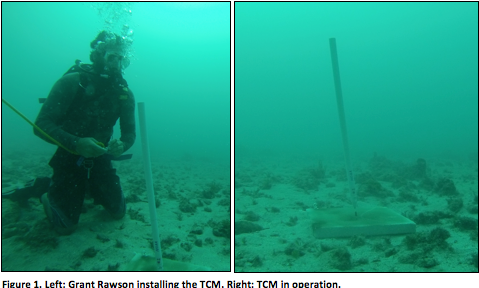 |
Turtle Cruise
● OCED and NOAA's Southeast Fisheries Science Center (www.sefsc.noaa.gov/labs/miami.htm), Miami, Florida, are cooperating in a project to locate and capture leatherback turtles in the northeastern Gulf of Mexico, near Destin, Florida. The turtles are first located by turtle spotters on NOAA aircraft. They are then approached by the R/V Hildebrand, captured using a special turtle net, and brought on board for examination and tagging. OCED personnel on the ship include OCED personnel Joe Bishop, LT Marc Weekely, and LTJG Ben Vandine. On the first day, the team was able to tag a medium sized turtle of 152-cm shell length. In the first two days of the cruise, they caught five leatherbacks, four in a single day! No one has caught and tagged leatherbacks at sea in the Gulf, let alone four in one day. The cruise will continue until September 25.
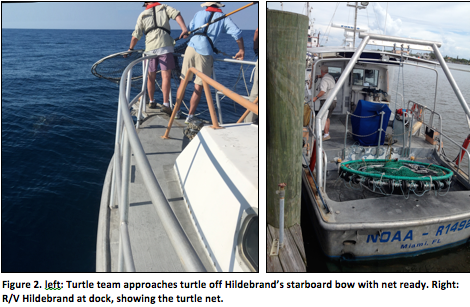 |
Coral Health and Monitoring
● Xaymara Serrano and a group of SEFCS scientists led by Dr. Margaret Miller recently completed their annual coral spawning monitoring in the Keys and collection of gametes for experiments to be conducted at the University of Miami. Spawning was monitored during the months of August and September for two ESA listed species: the elkhorn coral Acropora palmata and the mountainous star coral Orbicella faveolata. A video of an O. faveolata colony spawning was posted in the AOML photo gallery (http://www.aoml.noaa.gov/outreach/photogallery).
September 14, 2015
Ecosystem Assessment and Modeling
● Lindsey Visser and Chris Kelble conducted the first canal sampling in Biscayne Bay as part of the Biscayne Bay habitat blueprint on September 8 and 9. They found a considerable quantity of freshwater being released out of the canals from the recent rainfalls. Samples are currently being processed for nutrients and chlorophyll.
Land-Based Sources of Pollution
● Lew Gramer's turbidity instrument, deployed as a test of the instrument for nine days near the Port of Miami, was retrieved on 9-September (Figure 1). The instrument will provide in-water measurements of turbidity to calibrate and validate satellite estimates of turbidity for reefs. The instrument was designed and built by Coral Health and Monitoring Program partners Mana Amornthammarong and Mike Shoemaker; it can measure turbidity in continuous autonomous operation for up to two weeks in shallow waters. The instrument was deployed on July 30 off of the Port of Miami with the assistance of NOAA Corps officers Michael Doig, Ben Vandine, Marc Weekley, and James Europe.
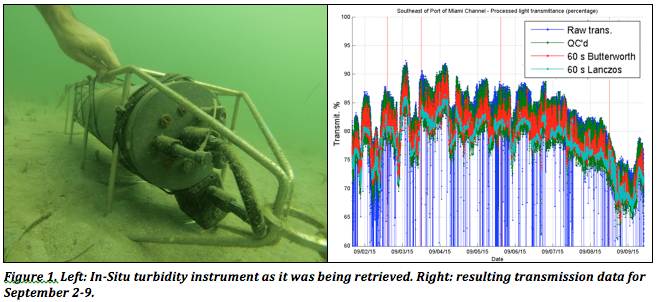 |
ACCRETE (Acidification, Climate, and Coral Reef Ecosystems TEam)
● The ACCRETE team successfully completed the establishment of a climate and acidification monitoring site in the Dry Tortugas as part of the Coral Reef Conservation Program's National Coral Reef Monitoring Program (NCRMP), which lies 70 miles west of Key West. ACCRETE established long-term transects to monitor cycling of calcium carbonate, as well as deployed bieorosion monitoring units (BMUs), calcification accretion units (CAUS), and STRS (subsurface temperature recorders). The NCRMP climate and acidification monitoring has now been fully implemented in the Atlantic, a process that has been ongoing over the past three years (FY13-FY15).
● The manuscript Micro-CT analysis of the Caribbean octocoral Eunicea flexuosa subjected to elevated pCO2 authored by Ian Enochs, Derek Manzello, Herman Wishing, Renee Carlton, and Joe Serafy was published in the ICES Journal of Marine Science. This was the first time micro-computed tomography was utilized to determine if high CO2 conditions impacted the growth of calcium carbonate structural elements, termed spicules or sclerites, in soft corals. Enochs et al. showed that there was no significant impact, which may be because the sclerites are enveloped in a proteinaceous matrix that keeps them isolated from seawater. Caribbean soft corals have increased in numbers and are now dominant benthic components in many reefs in the Florida Keys, as well as wider Caribbean. This increase has taken place while hard corals have declined dramatically. One hypothesis for this trend is that soft corals are far more tolerant of increases in temperature and declining pH. This study was a collaborative effort between AOML, SEFSC, and the Smithsonian Institution.
September 8, 2015
Coral Health and Monitoring
● The Coral Health and Monitoring Program (CHAMP)'s Coral Reef Early Warning System (CREWS) Network program, in collaboration with Dr. Kenrick Leslie of the Caribbean Community Climate Change Center (5Cs, or C5), currently includes CREWS stations in Belize (2), Dominican Republic (2), Trinidad and Tobago (2), and Barbados. However, the program is getting a big boost (thanks to 5Cs) from USAID for purposes of extending the Network to include new sites in many countries throughout the Caribbean. Funding has also been identified to support the continuing maintenance of the growing Network. The CREWS/C5 stations minimally measure air temperature, wind speed and direction, barometric pressure, precipitation, sea temperature and salinity, so these stations should theoretically be helpful to the host country weather forecasting and our own Hurricane Research Division efforts. CHAMP's Cooperative Institute for Marine and Atmospheric Studies (CIMAS) employee Mike Jankulak programs the data loggers and manages the information flow from the station to AOML, while CIMAS employee Lew Gramer (physical oceanographer) serves as the knowledge engineer for the coral ecosystem ecological forecasting functions, and also serves as liaison with the Network scientists at each of the host countries in meeting their information and research needs. Mike Shoemaker serves as the electronics technician to oversee proper operation of the stations. Dr. Jim Hendee is the Program Manager. Other scientists at AOML, other OAR Labs, and other Line Offices collaborate on the program, as well.
● OCED's Acidification, Climate, and Coral Reef Ecosystems Team (ACCRETE) were in the Dry Tortugas September 2-7 establishing a class II sentinel climate and acidification monitoring site as part of the National Coral Reef Monitoring Program (NCRMP). Team members participating were Renee Carlton, Ian Enochs, Graham Kolodziej, and Derek Manzello.
Florida Area Coastal Environment Program
● The September (final) Numeric Nutrient Criteria Study (NNCS) cruise took place on September 2-3, in the waters off of Broward and Miami-Dade Counties. The crew included Thomas Carsey, Joe Bishop, Jack Stamates, Charles Featherstone, Maribeth Gidley, LT Marc Weekley, and LTJG Vandine, on board the R/V Hildebrand (Figure 1).
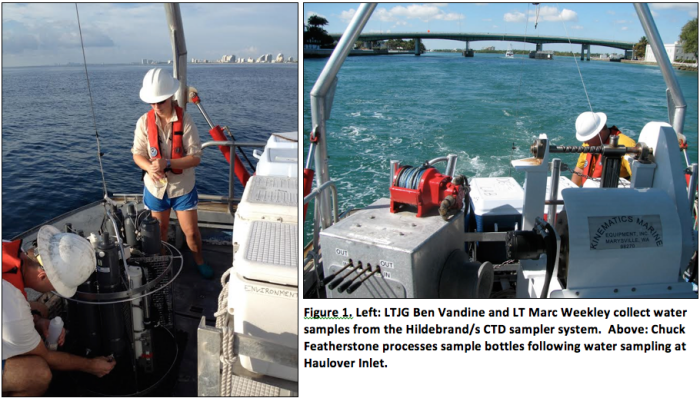 |
August 17, 2015
Ocean Carbon Cycle
● The paper "The Reinvigoration of the Southern Ocean Carbon Sink" was accepted for publication in Science:
Landschutzer, P., Gruber, N., Haumann, F.A., Rödenbeck, C., Bakker, D.C.E., van Heuven, S., Hoppema, M., Metzl, N.,
Sweeney, C., Takahashi, T., Tilbrook, B., Wanninkhof, R., 2015. The reinvigoration of the Southern Ocean carbon sink.
Science accepted.
"Several studies have suggested that the carbon sink in the Southern Ocean - the ocean's strongest region for uptake
of anthropogenic CO2 - has weakened in recent decades. Here, we demonstrate on the basis of multi-decadal analyses
of surface ocean CO2 observations that this weakening trend stopped around 2002 and that by 2012, the Southern Ocean
had regained its expected strength based on the growth of atmospheric CO2."
Coral Health and Monitoring
● A paper by OCED researchers Ian Enochs, Derek Manzello, Graham Kolodziej, Lauren Valentino, and Renee
Carlton entitled "Shift from coral to macroalgae dominance on a volcanically acidified reef" was reported on by
several news organizations last week after it was published in the journal Nature Climate Change.
http://www.miamiherald.com/news/local/environment/article31082493.html
http://www.sciencedaily.com/releases/2015/08/150810123706.htm
http://gizmodo.com/this-is-what-the-ocean-might-look-like-in-100-years-1723279241
http://www.iflscience.com/environment/volcanic-vents-reveal-bleak-future-oceans
http://www.eenews.net/climatewire/stories/1060023403
● "Volcano may predict health of reefs" was a front-page story in the Miami Herald on Sunday (15-Aug). The story, totaling 30 column-inches, described work headed by Ian Enochs and published in this week's Nature Climate Change. The work examined coral reefs at Maug Island, in the Marianas, where natural sources of CO2 provide a natural setting for the effects of elevated CO2 predicted for the world's oceans. Ian is quoted extensively in the story (http://www.miamiherald.com/news/local/environment/article31082493.html).
● The Coral Reef Early Warning System (CREWS) station (engineered by OCED researchers and contractors) at St. Croix was installed April, 2002 and went live for near real-time data transmission in June, 2002. It was then re-installed with a new architecture on September 23, 2006. Throughout that time, the station has continued to transmit data and produce ecological forecasts, while the Coral Health and Monitoring Program (CHAMP) team worked to help ensure quality data were collected and forwarded to NOAA's Coral Reef Conservation Program. The station continued to operate through several storms, though in its latter years, a CTD exploded and ruptured part of the pylon, compromising the integrity of the station. The station was operational for nearly twelve years, and for almost eight uninterrupted years in its current form. During August 12-13, 2015 the station was decommissioned and removed by John Halas of Environmental Moorings International, Inc., and Mike Shoemaker of OCED, both of whom were both involved in its original installation. Hopefully the pylon will be replaced in the future by a buoy (funding uncertain) of the latest CREWS design.
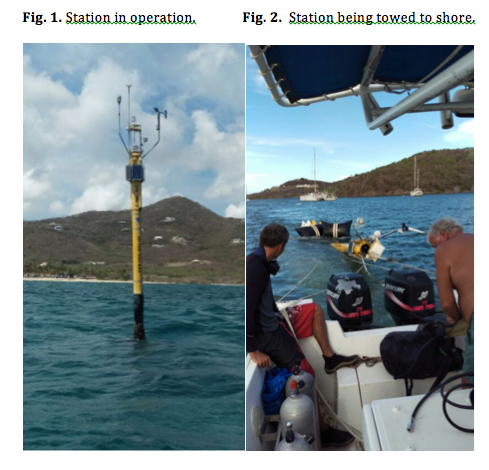 |
Ecosystem Assessment and Modeling
● Lindsey Visser is out conducting the August survey of juvenile sportfish in Florida Bay. Temperatures and Salinity in July were record breaking with temperatures as high as 38°C and salinities over 65. Hopefully, these salinities and temperatures will decrease due to the recent rainfall over south Florida.
August 11, 2015
Coral Health and Monitoring
● Ian Enochs, Derek Manzello, Graham Kolodziej, Lauren Valentino, Renee Carlton, and collaborators from CRED, Scripps, the Bigelow Laboratory, and BECQ in Saipan published a paper entitled Shift from Coral to Macroalgae Dominance on a Volcanically Acidified Reef in the journal Nature Climate Change. This paper describes the carbonate chemistry of a volcanic CO2 seep at Maug Island, Commonwealth of the Northern Mariana Islands (CNMI) which closely mimics that predicted to occur globally by the year 2100. The gradient in acidified water at the site is correlated with a shift from a coral-dominated to a less-desirable, algae-dominated community and indicates a possible outcome for US coral reefs in the future. Ref: I.C. Enochs, Manzello, D.P., Donham, E.M., Kolodziej, G., Okano, R., Johnston, L., Young, C., Iguel, J., Edwards, C., Fox, M., Valentino, L., Johnson, S., Benavente, D., Clark, S.J., Carlton, R., Burton, T., Eynaud, Y., Price, N. (2015) Shift from coral to macroalgae dominance on a volcanically acidified reef. Nature Climate Change.
● Along with other OCED researchers, Ian Enochs visited the Central Caribbean Marine Institute (CCMI) on Little Cayman from August 3-6. There he met with Drs. Carrie Manfrino, Kristi Foster, and Tom Frazer about developing collaborations at the institute as well as presented his research on the effects of ocean acidification on coral reefs to both NSF REU students and visiting scientists.
August 3, 2015
Land Based Sources of Pollution
● Lew Gramer's Turbidity project is now using in-water measurements to calibrate and validate satellite estimates of turbidity for reefs. For this purpose, Coral Health and Monitoring Program partners Mana Amornthammarong and Mike Shoemaker developed an instrument which can measure turbidity in continuous autonomous operation for up to two weeks in shallow waters (Figure 1). The instrument was deployed on July 30 off of the Port of Miami with the assistance of NOAA Corps officers Michael Doig, Ben Vandine, Marc Weekley, and James Europe. Generally, in situ turbidity instruments can foul rapidly, but short data records (days to weeks) are used by CHAMP collaborators at the USF to improve reliability of longer term turbidity tracking using MODIS and other remote sensing tools. The results are high-resolution maps, historical time series, and quantitative near-real time alerts of turbidity events that may affect living marine resources. Target sites for future field measurements in the project are being evaluated.
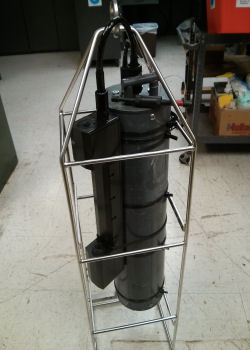 |
Coral Health and Monitoring
● On July 28 a team consisting of Derek Manzello, Renee Carlton and Mike Jankulak visited the Cheeca Rocks MApCO2 buoy just off the coast of Islamorada in the Florida Keys. This is part of a series of visits to repair extensive damage to the buoy that occurred at the end of May, possibly in a misguided attempt to moor a boat. After the visit they expect the buoy's pCO2 systems (both seawater and air) and CTD (with add-on fluorometer and optode) to be fully functional.
● Xaymara Serrano (OCED) recently traveled to Little Cayman's Central Caribbean Marine Institute (CCMI, Figure 2), as part of OCED's lecture series to summer REU (Research Education for Undergraduates) students conducting research at CCMI. Xaymara gave a well-received hour talk entitled Coral reef symbiosis, connectivity and impacts of thermal stress and nutrient pollution on early life stages. Xaymara also had the opportunity to meet individually with students and dive at their field study sites. She also met with Kristi Foster and Tom Sparke from CCMI, and with researchers Dr. Karstein Shein (NOAA) and Dr. Steffen Hetzinger (GEOMAR, Germany), to discuss project ideas and potential research collaborations.
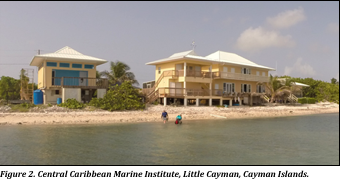 |
July 20, 2015
Ocean Carbon Cycle
● The following paper was published: Patsavas, M.C., Byrne, R.H., Wanninkhof, R., Feely, R.A., Cai, W.J., 2015. Internal consistency of marine carbonate system measurements and assessments of aragonite saturation state: Insights from two U.S. coastal cruises. Mar. chem. 176, 9-20. This paper, led by Mark Patsavas and Robert Byrne of the University of South Florida, employed data sets from the Pacific, Gulf and East coasts. The primary conclusion was that calculations of in situ aragonite saturation states (ΩA) near the saturation horizon exhibited differences on the order of ±10% between predictions based on the (DIC, TA) pair of measurements vs. the (pH, DIC), (fCO2, DIC), or (fCO2, pH) pairs. Differences of this magnitude, which are largely attributable to the imprecision of ΩA calculated from the (DIC, TA) pair, are roughly equivalent to the magnitude of ΩA change projected to occur over the next several decades due to ocean acidification. These observations highlight the importance of including either pH or fCO2 in saturation state calculations.
Coastal Oceanography
● On July 15, a sensor package developed by Natchanon Amornthammarong and Michael Shoemaker at AOML for in-situ measurements of turbidity was deployed in the nearshore coastal waters (25°44'57.3"N, 80°7'59.0"W) for a 2-week period (Figure 1). The resulting data will allow calibration and validation of an algorithm to estimate nephelometric turbidity unit (NTU) time series from the ocean color data in key areas of the ocean, across the full data period of MODIS Aqua (2002-present). The work is part of a Lew Gramer's three-year project Turbidity sensor for in-situ measurement of sediment on reefs and adjacent coastal areas funded by NOAA CRCP to monitor turbidity over shallow reef waters in southeast Florida, American Samoa, and the Commonwealth of the Northern Mariana Islands.
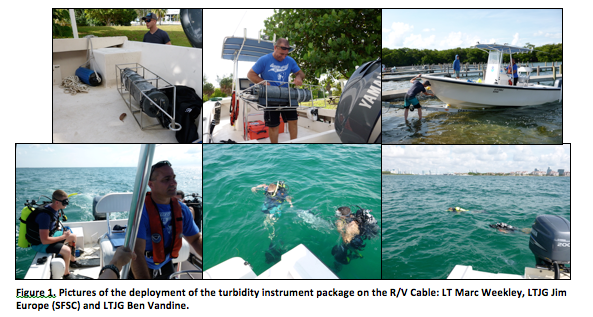 |
● The penultimate Numeric Nutrient Criteria cruise was conducted on the R/V Hildebrand on July 13 and 14 (Figure 2). The Crew included our two NOAA Corps officers Ben Vandine, Marc Weekley, with NOAA employees Joe Bishop, Jack Stamates and Tom Carsey, CIMAS employee Maribeth Gidley, and intern Aaron Hale from the University of Miami. The cruise went well with excellent weather. The final cruise of the project will take place in September.
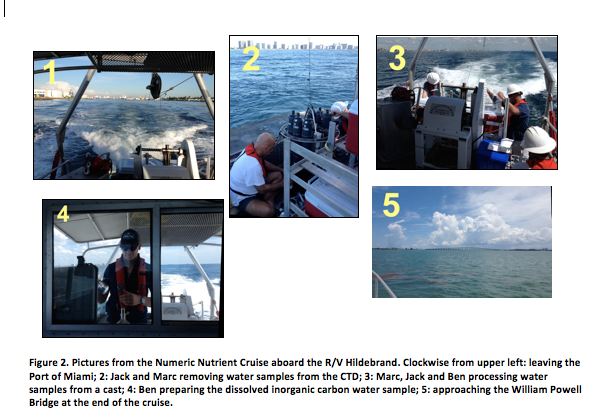 |
July 6, 2015
Environmental Microbiology
● Scientists from the Broward County Environmental Monitoring Laboratory visited AOML (29-June through 2-July) to participate in further training on methods for molecular microbial source tracking (MST) conducted by the AOML microbiology program. This is part of AOML's ongoing technology transfer efforts for these MST techniques to better help other agencies, academic institutions, resource managers, policy makers, stakeholder groups, and the private sector to detect and track land-based sources of pollution and to help guide remediation efforts.
June 29, 2015
Coral Health and Monitoring
● Jim Hendee has teamed up with Karsten Shein of the National Centers for Environmental Information (NESDIS/NCEI) and researchers from the Central Caribbean Marine Institute (CCMI) to examine local scale variability of temperature and light structures over the coral reefs surrounding Little Cayman Island. Collecting and analyzing these important data will allow enhancement of NOAA's coral reef ecological forecasting tools (e.g., Bleaching Alert, http://coralreefwatch.noaa.gov/satellite/index.php) as well as understanding the sufficiency of regional-scale observations to monitor for environmental threats to the reefs. The data also are assisting researchers from Germany and Japan in reconstructing paleoclimate records from nearby coral cores - records that will ultimately inform future global climate scenarios; researchers from Florida Atlantic University who are connecting water conditions to algal growth on the reefs, and CCMI researchers who are investigating why some reefs are more resilient than others over small distances. Lastly, this project is providing an NSF-funded research experience for an undergraduate student, Miranda Camp, from Stetson University in Florida.
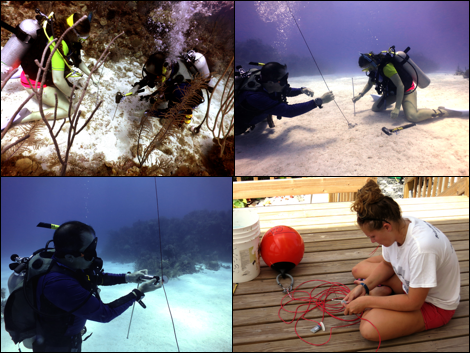 |
June 22, 2015
Coral Health and Monitoring
● Xaymara Serrano visited the Little Cayman's Central Caribbean Marine Institute (CCMI) June 25-29th as part of AOML's lecture series aimed at introducing undergraduates conducting summer research at the Institute to AOML's research, as well as establishing new and potential collaborations. Xaymara's talk was entitled is Synergistic Effects of Eutrophication and Elevated SST in the Early Life Stages of Two Caribbean Corals.
Environmental Microbiology
● Chris Sinigalliano and Maribeth Gidley and their interns have been quite active with Ocean Sampling Day (http://oceansamplingday.blogspot.com.) on June 21-22. On the 21st they sampled the waters of Tampa Bay, on the 22nd their group sampled the waters near Pt. Everglades on the R/V Hildebrand with MAST intern Emma Bennett, in the afternoon they were at Long Key in the Florida Keys. Ocean Sampling Day was initiated by the EU-funded Micro B3 (Marine Microbial Biodiversity, Bioinformatics, Biotechnology) project to obtain a snapshot of the marine microbial biodiversity and function of the world's oceans. It is a simultaneous global mega-sequencing campaign aiming to generate the largest standardized microbial data set in a single day. This will be achievable only through the coordinated efforts of an Ocean.
June 15, 2015
Awards
● Kelly Goodwin, Chris Kelble, and Rik Wanninkhof have each been selected to receive a "Certificate of Appreciation" award from the Bureau of Oceans and International Environmental and Scientific Affairs at the Department of State for their contributions to the World Ocean Assessment Review Process (www.worldoceanassessment.org) earlier this year. The award ceremony is scheduled for June 29 in the George Marshall Center, Washington DC.
Ocean Carbon Cycle
● Charles Featherstone attended the NOAA Ocean Acidification Workshop in La Jolla, CA, June 1-4.
Environmental Microbiology
● Christopher Sinigalliano and Maribeth Gidley attended a meeting of the American Society of Microbiology in New Orleans (May 31-June 4). They presented research from their NOAA Coral Reef Conservation Project in a presentation entitled Utilization of 16S Metagenomic Analysis and Molecular Microbial Source Tracking to Characterize the Microbial Diversity and Potential Influence from Land-Based Sources of Pollution for Sentinel Coral Reefs in Southeast Florida.
● The Microbiology Program Summer Student Interns are starting their summer internship at AOML today. We welcome Michael Goldberg, an undergraduate student from Emory University, Kristina Thoren, an undergraduate from University of Miami, and Casey Almendarez, a High School student from Miami Lakes Educational Center. We also have Daniel Morales as a continuing student intern this summer, who is now a freshman undergraduate student with Miami-Dade College. All of our interns will be participating in a summer microbiology research program focusing on molecular water quality assessment and metagenomic characterization of microbial communities from coastal and oceanic ecosystems. This includes projects analyzing molecular data for the Coral Reef Conservation Program, global Ocean Sampling Day, and bather exposure studies at local beaches.
Ecosystem Assessment and Modeling
● Chris Kelble was in Dallas/Ft. Worth to participate in the Gulf of Mexico Regional Coordination Team Meeting as the OAR representative on June 1-4. The meeting's aims were 1) Discuss expectations for future Team function and individual engagement; 2) Revisit and refine the team's mission and goals; 3) Identify and prioritize strategic regional themes for FY16 and beyond; 4) Consider how national level NOAA activities and priorities impact the region; and 5) Discuss desired team form, function, and activities in light of identified goals and themes.
Coral Health and Monitoring
● OCED's ACCRETE (Acidification, Climate and Coral Reef Ecosystems TEam) lab (Derek Manzello, Ian Enochs, Renee Carlton, Graham Kolodziej, Lauren Valentino, Paul Jones) successfully established the final of three sentinel climate and ocean acidification monitoring sites at the Flower Garden Banks National Marine Sanctuary. ACCRETE completed the ambitious suite of OA eco-response activities owing to the exemplary work of the team and quiescent seas. The eco-response metrics include CaCO3 budget surveys, measurement of benthic ecosystem calcification and productivity utilizing the BEAMS (Benthic Ecosystem Acidification Monitoring System) system developed by Wade McGillis via support of NOAA's coral program, taking coral cores for historical growth and calcification, and deployment of ARMS, CAUS (Calcification Accretion Units), and BMUS (Bioerosion Monitoring Units). Sixty coral cores were obtained from Orbicella faveolata, Siderastrea siderea, Diploria strigosa, Colpophyllia natans, Porites astreoides, and Montastraea cavernosa. These cores will be analyzed in the new CT scanner being installed at AOML.
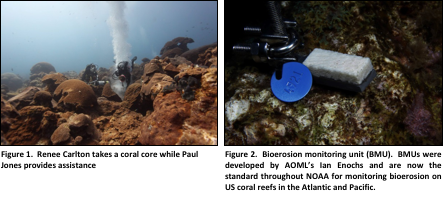 |
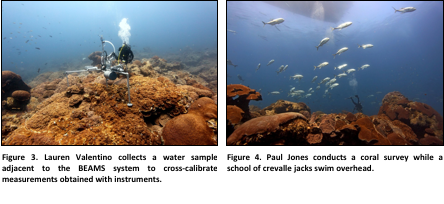 |
● Derek Manzello and Ian Enochs traveled to Wood's Hole Oceanographic Institute to attend the NOAA Ocean Acidification Program PI meeting that was held on 12 June.
● Derek Manzello was a co-author on a paper entitled Coupled chemical and biological monitoring to understand the impact of ocean acidification on coral reef ecosystems (Sutton A, Manzello DP, Gintert B, Oceanography 28(2):12-13, 2015) The paper offers a brief presentation of CO2 buoy data from ten coral reef sites around the world and how NOAA?s National Coral Reef Monitoring Program is working to document the progression of ocean acidification and its ecological impacts (Figure 5).
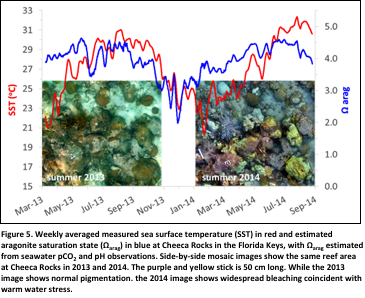 |
May 18, 2015
Environmental Microbiology
● Kelly Goodwin will be a keynote speaker in a professional development course developed by NOAA for educators, scientists, policy makers, and the interested public. The lecture, Marine Molecular Microbiology to Explore and Understand Biodiversity and Ecological Function, is part of a free, on-line course offered May 4 - 22 2015 at http://www.coexploration.org/oe2015/. In addition to learning about the importance of marine microbial diversity and how Citizen Scientists can participate in Global Ocean Sampling Day on June 21, 2015, participants have the option to earn one graduate credit from Ashland University during the first 3 weeks of the workshop. Kelly will present Ocean Sampling Day (June 21st) and other Nifty Marine Metagenomic Projects at the Northern California Water Quality Workgroup Meeting on May 14 and at the Southern California Water Quality Workgroup Meeting on May 20, 2015. On May 12, 2015, Dr. Goodwin lectured on Environmental Molecular Microbiology in an undergraduate-level Bioinformatics course (BILD94) at the University of California San Diego.
Ocean Carbon Cycle
● Kevin Sullivan and Rik Wanninkhof are co-authors of The An ammonium enrichment event in the surface ocean: Wind forcing and potential ramifications, authors K.A. Fanning, R.T. Masserini Jr, J. Walsh, R. Wanninkhoc, K. Sullivan, J.I. Virmani, and C.A. Heile, Marine Chemistry 174, 2015, pp 26-34, doi:10.1016/ j.marchem.2015.03.018. The paper describes the evolution of ammonia in surface water on the West Florida shelf in a deliberately injected inert tracer patch. The tracer component was led by K. Sullivan. The work was funded by ONR
Florida Area Coastal Environment
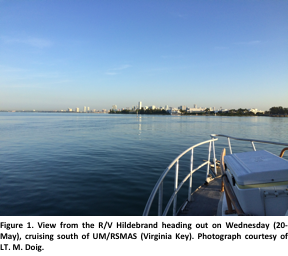
● The FACE team conducted their May Numeric Nutrient Criteria cruise in the coastal ocean off of Miami-Dade and Broward counties on May 19-20. On board were Mike Doig, Marc Weekley, Jack Stamates, Tom Carsey, Chuck Featherstone, Joe Bishop, and Maribeth Gidley (Figure 1 and 2).
● The following papers were published: Stamates, S.J. and T. P. Carsey, Measuring chemical loadings through inlets: Hillsboro and Boca Raton inlets (Florida, USA), Current, Waves and Turbulence Measurement (CWTM) Meeting, 2015 IEEE/OES-11, March 2-6 2015. doi: 10.1109/CWTM.2015.7098118. Carsey, T., J. Stamates, J.-Z. Zhang, F. Bloetscher., D. Meeroff. C. Featherstone, 2015, Point Source Nutrient Fluxes from an Urban Coast: the Boynton (Florida) Inlet, Environment and Natural Resources Research 5, 81-94. doi 10.5539/enrr.v5n2pxx.
May 11, 2015
Coral Health and Monitoring
● Ian Enochs recently published a paper in PloS One in which he has identified heterotrophy as a mechanism of resilience to ocean acidification stress in the endangered Caribbean coral Acropora cervicornis. Citation: Towle, E. K., I. C. Enochs, C. Langdon, 2015. Threatened Caribbean Coral Is Able to Mitigate the Adverse Effects of Ocean Acidification on Calcification by Increasing Feeding Rate. PLoS ONE 10(4): e0123394. doi: 10.1371/journal.pone.0123394
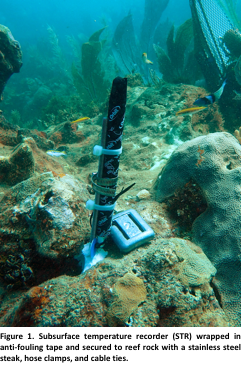
● Ruben van Hooidonk's paper Projections of climate conditions that increase coral disease susceptibility and pathogen abundance and virulence (citation: Maynard, J. ,R. van Hooidonk, C. M. Eakin, M. Puotinen, M. Garren, G. Williams, S. F. Heron, J. Lamb, E. Weil, B. Willis and C. D. Harvell, 2015, Nature Climate Change doi:10.1038/nclimate2625) has been highlighted in Cornell University's Cornell Chronicle (http://www.news.cornell.edu/stories/2015/05/scientists-expect-more-coral-disease) as well as in the Coral List for May 5, 2015.
● Graham Kolodziej and Ian Enochs conducted work in Puerto Rico associated with the Coral Reef
Conservation Program's National Coral Reef Monitoring Plan. Together with colleagues Dr. Daniel Moses
Holstein and Viktor Brandtneris from the University of the Virgin Islands, they installed three subsurface
temperature recorder (STR, Figure 1) arrays at Vieques, Culebra, and Isla Palominos. Kolodziej and Enochs
installed an additional two arrays off of Arecibo and Jobos Bay, in northern and southern mainland Puerto
Rico, respectively. A final array will be installed in Rincon in the coming weeks. Each STR array consists
of high-accuracy Sea-Bird temperature loggers, deployed by divers at 1m, 5m, 15m, and 25m depth.
Temperature is recorded every five minutes over a three-year period, at which point instruments will be
replaced. At Jobos Bay, Kolodziej and Enochs worked closely with Angel Dieppa, the reserve's scientific
coordinator, who provided field support and advice concerning site location. Following instrument deployment,
they received a tour of the park's laboratory capabilities and monitoring programs, as well as the diverse
ecosystems present there.
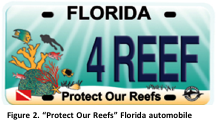
● The project entitled Synergistic effects of eutrophication and elevated sea surface temperatures in the early life stages of two Caribbean reef corals, led by Xaymara Serrano, Jim Hendee, Margaret Miller and Andrew Baker (UM/RSMAS) was selected for a second year award from the "Protect Our Reefs" Grants Program. This grant is funded by the sale of coral reef specialty license plates (Figure 2) and administered by Mote Marine Laboratory.
● Derek Manzello and Renee Carlton returned from a successful voyage to the Chagos Archipelago in the Indian Ocean in collaboration with the Living Oceans Foundation. Manzello and Carlton obtained coral cores and seawater chemistry measurements to establish ocean acidification baselines for this remote area with almost no human impacts, as well to determine if there have been any recent declines in coral growth that may be attributable to acidification. During the course of the mission, mass coral bleaching was observed on many reefs, primarily impacting tabulate acroporid corals, as well as corals in the genera Pocillopora and Seriatopora (Figure 3). Seawater temperatures were warm the entire trip, ranging from 29 to >31°C at all 54 reefs surveyed. Sea conditions were very calm, exhibiting doldrum-like characteristics of little wind. This likely contributed to bleaching via enhanced penetration of light into the water column.
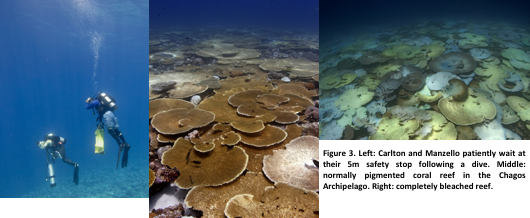
Ocean Carbon Cycle
● The ocean carbon group contributed observations to the annual assessment Global Carbon Budget 2014; Wanninkhof is one (of many) co-authors to the manuscript. Le Quere, C., R. Moriarty, R.M. Andrew, G. P. Peters, P. Ciais, P. Friedlingstein, S. D. Jones, S. Sitch, P. Tans, A. Arneth, T. A. Boden, L. Bopp, Y. Bozec, J. G. Canadell, L. P. Chini, F. Chevallier, C. E. Cosca, I. Harris, M. Hoppema, R. A. Houghton, J. I. House, A. K. Jain, T. Johannessen, E. Kato, R. F> Keeling, V. Kitidis, V. Goldewijk, C. Koven, C. S. Landa, P. Landschutzer, A. Lenton, I. D. Lima, G. Marland, J. T. Mathis, N. Metzl, Y. Nojiri, A. Olsen, .T. Ono, S. Peng, W. Peters, B. Pfeil, B. Poulter, M. R. Raupach, P. Regnier, C. Roedenbeck, S. Saito, J. E. Salisbury, U. Schuster, J. Schwinger, R. Seferian, J. Segschneider, T. Steinhoff, B. D. Stocker, A. J. Sutton, T. Takahashi, B. Tilbrook, G. R. van der Werf, N. Viovy, Y. P. Wang, R. Wanninkhof, A. Wiltshire, and N. Zeng, 2015. Global Carbon Budget 2014. Earth Syst. Sci. Data 7, 47-85. 10.5194/essd-7-47-201544.
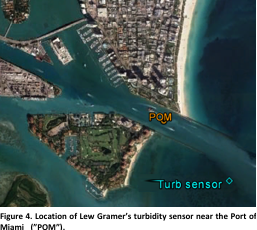
Coastal Oceanography
● Lew Gramer was in Silver Spring for the 3rd Annual Ecological Forecasting Roadmap meeting last week. Scientists and operational experts from across NOAA met with representatives from NASA, EPA, and FDA to talk about NOAA's research ecoforecasts, and paths forward to operationalize them for the benefit of the nation. He also spent several days talking with the reef prioritization
● A turbidity sensor will be deployed by NOAA divers just south of Miami channel this week (Figure 4). The sensor package, assembled by Mana Amornthammarong and Mike Shoemaker, will provide data to calibrate an algorithm for monitoring shallow-water turbidity using satellite ocean color. The work is a part of Lew Gramer's NOAA Coral Program project.
May 4, 2015
Ocean Carbon Cycle
● P16N Cruise Update - Jessica Cross, Chief Scientist, and Samantha Siedlecki, Co-chief Scientist on the P16N cruise on the Ron Brown, report that on May 1 the ship have crossed the equator on their way to Hawaii and will arrive in Hawaii on May 14. The tracks of the Repeat Hydrography cruises are shown in Figure 1. A blog from the cruise can be viewed at http://goship2015leg1p16n.blogspot.com. More information on the U.S.Repeat Hydrography program can be found at http://ushydro.ucsd.edu. A ten-year review of accomplishments of the program can be found at http://www.us-ocb.org/publications/USRepeatHydrographyReport-Final.pdf.
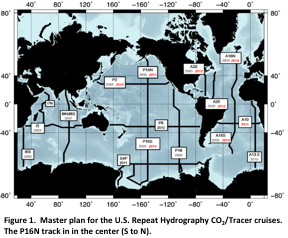
● The following paper was published: Ballantyne, A. P., Andres, R., Houghton, R., Stocker, B. D., Wanninkhof, R., Anderegg, W., Cooper, L. A., DeGrandpre, M., Tans, P. P., Miller, J. B., Alden, C., and White, J. W. C.: Audit of the global carbon budget: estimate errors and their impact on uptake uncertainty, Biogeosciences, 12, 2565-2584, doi:10.5194/bg-12-2565-2015, 2015.
Ecosystem Restoration Assessment and Modelling
● Chris Kelble's work in Florida Bay received front-page coverage in the Miami Herald, Local & State ("B") section, on Monday 4-May. The article, entitled Dry Winter, slow glades progress put Florida Bay at risk, written by Jenny Staletovich of the Herald, includes quotes from Chris concerning the impact of elevated salinity in Taylor Slough (which flows into the bay) due to a second unseasonably dry winter, and how that effects the entire ecosystem. The 38 column-inch article also includes quotes from Susan Gray, the South Florida Water Management District's chief environmental scientist, University of Miami fisheries scientist Jerry Ault, Jerry Lorenz of Audubon Florida, and Tylan Dean, the Everglades National Park biological branch chief. The article is available at http://www.miamiherald.com/news/local/community/miami-dade/article20128902.html.
April 27, 2015
Environmental Microbiology
● AOML was visited on 24-April by representatives and staff from the Broward County Environmental Monitoring Lab to learn more about setting up a molecular microbial source tracking laboratory. Chris Sinigalliano from the AOML Molecular and Environmental Microbiology Program is serving as an advisor to help Broward County develop and establish their own molecular source tracking lab for microbial water quality testing. As part of AOML's technology transfer process, Chris and his microbiology staff are currently involved in advising and training members of Broward County and the City of Fort Lauderdale on how to set up such a microbial source tracking facility and conduct quantitative PCR assays for water quality assessment and troubleshooting of contamination. AOML will conduct training projects with Broward County throughout the summer.
Outreach
● AOML was visited on 27-April by Peter Tuddenham and Kristina Bishop, along with a film crew, from the College of Exploration. Peter describes the College as "a global learning network. We work with partners around the world on innovative and exploratory learning programs about our environment, the earth, the ocean, technology, leadership, learning and creativity. We are organized as a collegium concerned with programs about our understanding of, and our relationships with and between, our inner and outer worlds." Peter has an environmental literacy grant from the NOAA Office of Education, and one aspect of this is to document the global Ocean Sampling Day for the public and utilize OSD as an opportunity to improve public environmental literacy on ocean science. Since AOML serves as a hub for OSD in Florida, the Gulf of Mexico, and the Caribbean, Peter?s film crew will be filming various activities, sampling, and research related to Ocean Sampling Day here at AOML for public education videos and other educational products for NOAA.
Ocean Carbon Cycle
● A scientist in the Ocean Carbon group is sailing on the RCCL ship Equinox (operated by Celebrity) sailing from Fort Lauderdale to Lisbon to sample for carbon and ocean acidification parameters on this trans-Atlantic voyage. The Equinox is the latest ship outfitted with underway CO2 measurement capability in coordination with RSMAS and funded by the NOAA's Climate Observation Program.
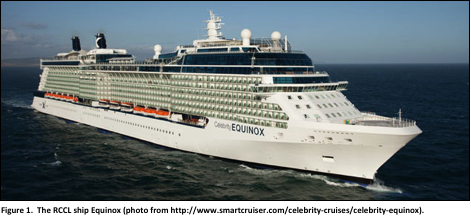
April 20, 2015
Ocean Carbon Cycle
● Rik Wanninkhof attended the joint OOPC/GOOS/IOCCP meeting April 12-18 at Aoba-ku University, Sendai Japan. He is a member of the scientific steering committee of IOOCP and represented IOCCP at the meeting. The meeting was focused on synergies between the three projects that NOAA is closely involved with to lay out a strategy and science objectives for sustained ocean observations for the next decade. The topic addressed the NOAA strategic theme Climate Mitigation and Adaptation.
Coral Health and Monitoring
● Recently Lauren Valentino had the opportunity to work on reefs that surround the islands of the largest no-take MPA on the planet, Chagos archipelago (Figure 1 upper left). There, she collected in-situ pH and pCO2 data and deployed a SeaFET Ocean pH Sensor to evaluate carbonate chemistry dynamics of benthic reef environments. Additionally, she collected coral cores (Figure 1 upper right) to be analyzed using computed tomography scanning (CT scan) to determine growth rates over time. The surface conditions were glassy and temperatures averaged a cozy 30-32°C. Due to its isolation and lack of human impact, dense coral cover spans across the reef and fish populations are booming. There were times she could not see her dive buddy as huge schools of fish surrounded them. It was an amazing experience overall and inspiring to see what a positive impact conservation has had on the region. Through April and May, Derek Manzello and Renee Carlton will be participating in the second leg of the Chagos archipelago mission for the ACCRETE lab's 13th trip aboard the M/Y Golden Shadow (Figure 1 lower right) with the Khaled bin Sultan Living Oceans Foundation (http://www.coral.noaa.gov/collaborations/lof.html)
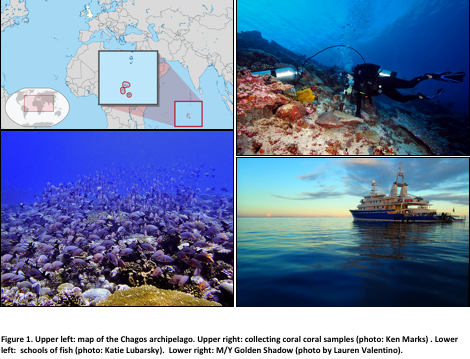
April 13, 2015
Environmental Microbiology
● Kelly Goodwin is now a member of the Fast-Track Action Committee on Mapping the Microbiome (FTAC-MM) which was established by action of the National Science and Technology Council (NSTC), Committee on Science (CoS), Life Sciences Subcommittee (LSSC). The purpose of the FTAC-MM is to identify areas of current Federal investment, research needs, and resource gaps for the development of an integrated Federal plan for microbiome research, and to identify priority areas for Federal agency coordination and cooperation on achieving a predictive understanding of microbiomes and their function. The committee will soon execute their first task which is a data call to federal program managers to collect information on microbiome research investment.
A microbiome is the assemblage of microorganisms that live in a particular environment. They have been shown to play a dynamic and essential role in human health, environmental processes, and agriculture. In recent years, Federal investments have led to extraordinary growth in understanding of the components and dynamic nature of microbiomes in human, plant, and animal environments. Microbiomes are emerging as important influences in all Earth habitats, governing an astounding array of biological processes, ranging from nutrition and disease in humans to nutrient acquisition and stress tolerance in plants and stability of soil and aquatic environments.
April 6, 2015
Coral Health and Monitoring
● The recent paper by Ruben van Hooidonk with J. A. Maynard, Y. Liu and Sang-Ki Lee in Global Change Biology, Downscaled projections of Caribbean coral bleaching that can inform conservation planning, was featured in Sunday's Miami Herald, under the title Study: Climate change will hit some Florida reefs sooner than expected, might trigger annual bleaching. The article can be seen at http://hrld.us/1P7LKPf.
● Dr. Kenrick Leslie, Executive Director of the Caribbean Community Climate Change Center (C5), met with Jim Hendee on April 2 to discuss current challenges to finishing the first stage of the implementation of the CREWS/C5 Network extension to include Belize, Barbados, Tobago, and Dominican Republic. Also, Dr. Leslie pledged to support up to $1M maintenance costs and in an expansion of the CREWS Network beyond the current sites with new funding from the European Union. The new sites would likely include Cuba, Turks & Caicos, Martinique, San Andres, and other sites yet to be determined.
March 30, 2015
Coral Health and Monitoring
● Xaymara Serrano is the recipient of one of 18 Ford Foundation Postdoctoral Fellowships awarded in 2015 nationwide. These postdoctoral fellowships are awarded in a national competition administered by the National Research Council (NRC) to individuals who, in the judgment of the review panels, have demonstrated superior academic achievement, are committed to a career in teaching and research, show promise of future achievement as scholars and teachers, and are well prepared to use diversity as a resource for enriching the education of all students. Overall, Xaymara plans to use these funds to support another year of her postdoctoral research aimed at investigating coral reef responses to climate change and land-based sources of pollution.
March 23, 2015
Florida Area Coastal Environment
● Thomas Carsey, Jack Stamates, Joe Bishop, Chuck Featherstone, Maribeth Gidley, and Natchanon Amornthammarong completed the March Numeric Nutrient Criteria Study cruise off of Broward and Miami-Dade Counties in the R/V Hildebrand in beautiful weather and calm seas on March 18-19.
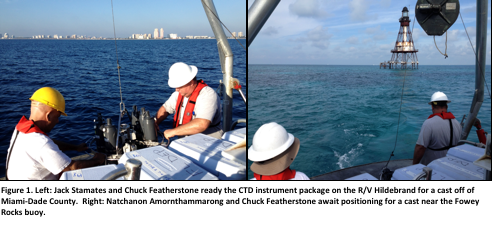
March 16, 2015
Sea Grant
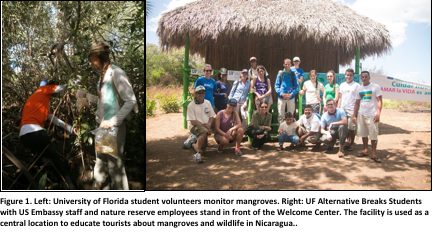
● Pamela Fletcher, the UF/IFAS Florida Sea Grant Regional Extension Coordinator at AOML spent the first week of March in Nicaragua. Pamela led a group of University of Florida students who chose to spend their spring break volunteering to promote marine life conservation. Volunteers typically have no background in marine science, but actively participate in mangrove reforestation and monitoring (Figure 1) and sea turtle conservation activities. Since 2012, students from UF have planted over 30,000 mangroves alongside nature reserve staff, local youth groups, an ecotourism cooperative, and the indigenous community. Volunteers also repair and paint structures on the nature reserve property as part of an eco-tourism project. For the past two years, the US Embassy in Managua has participated in the plantings. This year, Martha Youth, the Deputy Chief Mission, and two of her staff joined the volunteers (http://goo.gl/eAxoNM) (Figure 2). She provided an overview of the Department of State, the mission in Managua, and her career experiences to help students learn about Department of State activities abroad. Throughout the week-long program, student volunteers learn about marine life conservation, leadership, service, and get to experience the culture of Nicaragua. What do student volunteers have to say about the trip? "I had always been really interested in marine life conservation and this experience has taught me so much and enabled me to get a chance to pursue that passion." "This trip has not only helped me grow as a leader, but also learn so much about a new culture and experience things I never thought I would." "Even though the service was challenging, I never stopped having fun".
March 10, 2015
Coral Health and Monitoring
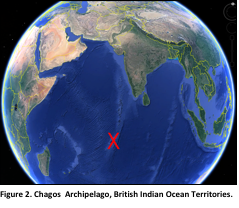
● Lauren Valentino is participating in the British Indian Ocean Territories - Chagos Archipelago leg of the Khaled bin Sultan Living Oceans Foundation Global Reef Expedition. The Chagos Archipelago is the largest no-take marine reserve on the planet and 95% of the reefs have been unexplored. This lack of anthropogenic influence provides an ideal context for the ocean acidification research activities being conducted by members of the Acidification, Climate, and Coral Reef Ecosystems (ACCRETE: http://www.coral.noaa.gov/research/accrete.html), a subunit of the Coral Health and Monitoring Program (CHAMP: http://www.coral.noaa.gov/). This is the 11th mission of the Global Reef Expedition that ACCRETE team members have participated in where they have amassed an unprecedented ocean acidification and coral growth dataset spanning the Pacific and Indian Oceans. For further information on the Chagos Archipelago see here: http://www.livingoceansfoundation.org/where-we-work/indian-ocean/biot/.
Florida Area Coastal Environment
● Jack Stamates attended the Institute of Electrical and Electronics Engineers 11th Currents,
Waves and Turbulence Measurement Workshop in St. Petersburg, Florida (March 2-6)
(www.cwtm2015.org/index.cfm).
Jack will give a presentation on Tuesday entitled Estimating Nutrient Loading to the Coastal Ocean
Through Tidal Inlets. Thomas Carsey is the co-author.
Sea Grant
March 2, 2015
Coral Health and Monitoring
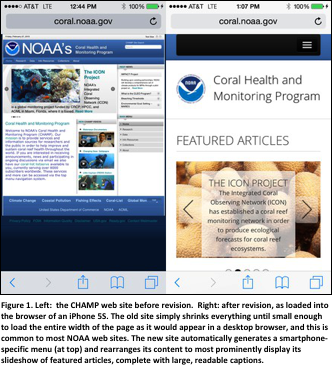
● On February 27th the Coral Health and Monitoring Program (CHAMP) released a redesigned web site to the public (Figure 1). With this release the site takes on a cleaner, more modern look and becomes smartphone- and tablet-friendly, adapting its menus, image sizes and page organization seamlessly to accommodate the size of the visitor's browser window. An informal survey of web sites across NOAA suggests that at present only CHAMP and PMEL have web sites that are smartphone-friendly to this degree. Unlike the previous site redesign in 2010, which was commissioned from an external web developer, the present overhaul was completed entirely in-house by CHAMP's Mike Jankulak. Among other upgrades the site features expanded personnel bios of CHAMP team members and highlights the activities of the newly-christened Acidification, Climate, and Coral Reef Ecosystems TEam (ACCRETE). The CHAMP site can be found at: http://www.coral.noaa.gov.
Nutrient Biogeochemistry
● The AOML nutrient laboratory, headed by Dr. Jia-Zhong Zhang, has completed analysis of nutrient reference seawater samples in the 4th International Inter-Comparison Exercise for 2015. Nutrients have been amongst major key variables in various international global ocean observation programs such as the Geochemical Ocean Sections Study (GEOSECS) in the 1970s, the World Ocean Circulation Experiment (WOCE) in the 1990s, and the on-going Climate Variability and Predictability (CLIVAR, GO-SHIP). The Exercise is sponsored by the International Ocean Carbon Coordination Project (IOCCP) and Japan Agency for Marine-Earth Science and Technology (JAMATEC). As with the previous inter-comparison studies organized by international nutrient community, the aim is to improve the quality of nutrient analysis by developing certified reference material and exchange knowledge between participating laboratories. A total of 112 nutrient laboratories worldwide participated in this excises. Website is www.ioccp.org/nutrients/2-uncategorised/74-2014-inter-comparison-study- of-certified-reference-material-for-nutrients-in-seawater.
Environmental Microbiology
● Maribeth Gidley presented the talk Future Health Concerns Associated With a Changing Climate at the Empowering Capable Climate Communicators training series at the University of Miami on 28-February. She also participated in an interview with journalism students at FIU on the topic.
Ocean Carbon Cycle
● Ocean acidification along the Gulf Coast and East Coast of the USA has been accepted for publication in Continental Shelf Research. The paper of record describes measurement and patterns of aragonite saturation state (ωAr) along with attribution based on the second Gulf of Mexico and East Coast Carbon Cruise (GOMECC-2). The ωAr is a critical indicator of health of calcifying organisms and is decreasing as a result of ocean acidification. Comparison with ωAr data from GOMECC-1 shows that the large-scale patterns in ωAr are dominated by changing ocean currents in the domain. Citation: R. Wanninkhof, L. Barbero, R. Byrne, W.-J. Cai, H. Z. Zhang, M. Baringer, and C. Langdon, 2015. Ocean acidification along the Gulf Coast and East Coast of the USA. Cont. Shelf Res. Accepted Feb 2, 2015.
February 23, 2015
Ocean Carbon Cycle
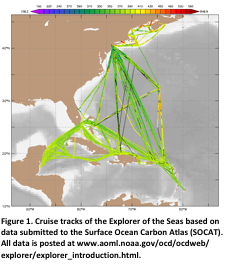
● On January 21, Kevin Sullivan returned from the last research cruise of the Royal Caribbean Cruise Line's Explorer of the Seas. Over the past 12 years, the ship has provided surface CO2 measurements along the East Coast of the US and throughout the Caribbean. This data was critical in determining sea-air CO2 fluxes and trends in ocean acidification in coastal waters and the Intra-Americas Seas. The 400 voyages (Figure 1) yielded over 600,000 data points and were the basis of numerous publications with four of the more significant ones listed below. The sustained observations in this region will be continued with a recently installed automated CO2 system on the Celebrity Cruise Line's Equinox. This effort is in collaboration with and strong support from the University of Miami/RSMAS and the Royal Caribbean Cruise Line. Funding for the CO2 component is provided by the Climate Observation Division of the NOAA Climate Program Office, the NOAA Ocean Acidification Program, and AOML/OAR. The following are four key publications resulting from the surface CO2 measurements on the Explorer of the Seas:
- Gledhill, D. K., R. Wanninkhof, F. J. Millero, and M. Eakin, 2008: Ocean acidification of the greater Caribbean region 1996-2006. J Geophys. Res., 113, C10031, doi:10010.11029/12007JC004629.
- Olsen, A., J. Triñanes, and R. Wanninkhof, 2004: Sea-air flux of CO2 in the Caribbean Sea estimated using in situ and remote sensing data. Remote Sensing of Environment, 89, 309-325.
- Park, G.-H., and R. Wanninkhof, 2012: A large increase of the CO2 sink in the western tropical North Atlantic from 2002 to 2009. J Geophys. Res., 117, C08029, doi:08010.01029/02011JC007803.
- Wanninkhof, R., A. Olsen, and J. Triñanes, 2007: Air-Sea CO2 Fluxes in the Caribbean Sea from 2002-2004. Journal of Marine Systems, 66, 272-284.
● Rik Wanninkhof is a member of the recently funded International Space Science Institute working group on Earth Observation for atmosphere-ocean gas exchange (http://www.issibern.ch). The working group is sponsored by the European Space Agency. The purpose of this working group is to bring together key international researchers working in the field of atmosphere-ocean interaction and satellite Earth observation to 1) identify and formulate new multi-satellite, model and in situ data synergies towards improving our understanding of the pathways, sources, sinks and budgets of greenhouse gases, and 2) identify a roadmap/approach for routine long-term space-asset-based monitoring of the oceanic sink of CO2 which exploits the Copernicus Sentinels and international networks.
February 17, 2015
Coral Health and Monitoring
● Xaymara Serrano (OCED) was invited to serve as guest speaker and lead a paper
discussion in the graduate seminar series of the Department of Marine and Environmental
Sciences of Savannah State University (SSU) on February 18. The goal of this seminar class
is to introduce SSU's new Master's students to a wide variety of marine research topics.
Florida Area Coastal Environment
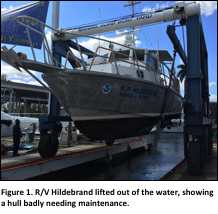
● The R/V Hildebrand is currently undergoing repairs and maintenance in drydock at
the Marina Road Boat Yard in Ft. Lauderdale (Figure 1).
Ocean Carbon Cycle
● Denis Pierrot will be driving to Port Canaveral this Friday (February 20) to meet Kevin Sullivan on the RCCL Explorer of the Seas. They will be offloading instrumentation from the ship.
● On Monday (February 23), Denis will oversee the installation of a new pCO2 system on the RCCL Equinox. The ship is scheduled to cross the Atlantic and the end of each April for summertime cruising of the Mediterranean, then return later in the year to sail the Caribbean in the winter.
February 9, 2015
Ecosystem Assessment and Modeling
● Kelly Kearney will be leaving CIMAS and AOML at the end of this week.
She is moving to the Joint Institute for the Study of the Atmosphere and Ocean at
the University of Washington where she will be an assistant scientist working on
an ecosystem modeling project that is a joint effort among University of Washington,
the Pacific Marine Environmental Laboratory, and the Alaska Fisheries Science Center.
We wish her all the best on her new career endeavor.
● Chris Kelble is currently in La Jolla CA attending a review of the California
Current Integrated Ecosystem Assessment (IEA) as the chair of the IEA Steering Committee
and designated reviewer of the project (Feb 8-14). The review will take place at the
Southwest Fisheries Science Center in La Jolla and aims to evaluate the scientific
progress that the California Current IEA has made and determine how their experiences
might be transferrable to other regional IEA program.
Coral Health and Monitoring
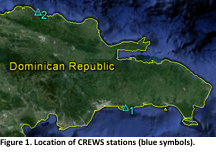
● A second site for a Dominican Republic CREWS station has been selected by CREWS
Field Team contractors Jon Fajans (C-ARMS, Inc.) and John Halas (EMI, Inc.) through a collaborative
effort between the Caribbean Community Climate Change Center (CCCCC) in Belize, the National Council
for Climate Change (ONAMET), and The National Authority for Maritime Affairs (ANAMAR), and AOML. The
site chosen is at 19°50.007'N, 70°43.868'W. The first site chosen is at the Catuan Wreck site on
the south side of the island, at 18°25.940'N, 69°34.792'W (Figure 1). Both buoys are being installed this week.
Ocean Carbon Cycle
● Rik Wanninkhof is attending a Surface ocean carbon mapping (SOCOM) workshop in Tsukuba, Japan \ this week (Feb 9-14).
February 2, 2015
Ecosystem Assessment and Modeling
● Chris Kelble will be attending The Lenfest Ocean Program's Second Fishery Ecosystem
Planning Task Force meeting this Wednesday in New Orleans. The goal of the Lenfest Fishery
Ecosystem task Force is to create a practical blueprint that managers can use to make
ecosystem-based fisheries management operational. This is their second meeting to facilitate
the creation of this blueprint within the next year.
January 26, 2015
Florida Area Coastal Environment
● The FACE / Numeric Nutrients cruise for January was conducted on January 20-21. On board were Paul Jones, Lauren Valentino, Joe Bishop, Charles Featherstone, Jack Stamates and Maribeth Gidley. A swap-out of an acoustic Doppler current profiler (ADCP) instrument off of Broward County is scheduled for Friday Jan 30, weather permitting.
Ocean Carbon Cycle
● Denis Pierrot, Kevin Sullivan and Robert Castle started the installation of an autonomous underway pCO2 system on board the Royal Caribbean Celebrity Cruise Line EQUINOX. This installation is a partnership with the University of Miami which has a TSG, a fluorometer and MAERI already running on the ship. The EQUINOX sails in the Caribbean during the winter and goes to the Mediterranean in the summer. This will be the replacement instrument for the RCCL Explorer of the Seas which has been outfitted with a pCO2 instrument for the past 12 years but is going to Asia in the spring.
Environmental Microbiology
● Kelly Goodwin presented a talk on January 22 entitled NOAA-CalCOFI Ocean Genomics Project (NCOG): Exploring 'Omics Technologies to Support Ecosystem Understanding and Fisheries Assessments to the Biodiversity Ad Hoc Group under the Interagency Working Group on Ocean Partnerships.
January 12, 2015
Ecosystem Assessment and Modeling
● NOAA has selected South Florida's Biscayne Bay as one of the next Habitat Focus Areas
under NOAA's Habitat Blueprint. Habitat Blueprint offers opportunities for NOAA to partner with
organizations to address coastal and marine habitat loss and degradation issues. It provides a framework,
which builds upon existing programs, prioritizes activities, and helps users act strategically and
preventively in order to sustain resilient and thriving marine and coastal ecosystems and resources.
The initial focus on the Bay will be to further our understanding of increasing algal blooms
(both pelagic and benthic) in the Bay and propose mitigation actions that can stem these increases and
protect the benthic habitats of Biscayne Bay that are reliant upon clear water quality. Kelble will
co-lead the implementation team with NOAA Southeast Fisheries Science Center's Joan Browder in hopes
of identifying solutions to improve Biscayne Bay health, before it declines. With the help of NOAA's
Habitat Blueprint, partnering organizations can develop assessments, experiments and analyses to
ultimately protect, restore, and sustain Biscayne Bay's healthy ecosystem. More information can
be found at the following web pages:
http://www.aoml.noaa.gov/keynotes/keynotes_115_habitat_blueprint.html
http://www.habitat.noaa.gov/habitatblueprint/southeast_caribbean.html.
Coral Health and Monitoring
● Science News interviewed Derek Manzello about his recent publication in Geophysical Research Letters. The article entitled Galápagos waters preview future for corals is online here: https://www.sciencenews.org/article/gal%C3%A1pagos-waters-preview-future-corals.
● The paper Ocean acidification enhances the bioerosion of a common coral reef sponge: implications for the persistence of the Florida Reef Tract (Enochs IC, Manzello DP, Carlton RD, Graham DM, Ruzicka R, Colella MA) was accepted for publication in the Bulletin of Marine Science. To test how future OA conditions will influence biologically-mediated dissolution (bioerosion) of coral by the common Caribbean boring sponge Pione lampa, a series of carefully controlled incubations were conducted and the changes in total alkalinity (TA) was used to calculate calcium carbonate dissolution. The data showed a positive relationship between seawater pCO2 and chemical bioerosion that predicts a 99% increase in chemical erosion before the end of the century, more than double the expected decline in coral calcification rate. To examine how OA-enhanced erosion will influence reef ecosystem persistence, this data and other data was incorporated into a carbonate budget model of 37 reefs along the Florida Reef Tract. Present-day reef-specific calcification would need to increase by 29.4% in order to compensate for projected end of the century OA-enhancement of total bioerosion. These findings show that OA may accelerate Caribbean and Atlantic coral reef degradation more rapidly than previously predicted.
December 15, 2014
Awards!
● Christopher Kelble, along with Michael Schirripa, Mandy Karnauskas and J. Kevin Craig (NMFS), were awarded the Bronze Medal Award "For advancing ecosystem-based management via the first comprehensive Gulf of Mexico Ecosystem Status Report with over 140 ecological indicators" on December 9, 2014 by NOAA Administrator Dr. Kathy Sullivan (Figure 1).
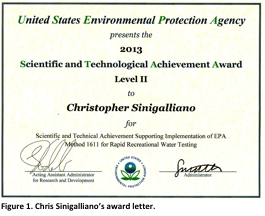
● The AOML Microbiology team has just been awarded the EPA's 2013 Scientific and Technological Achievement Award, Level II for Scientific and Technical Achievement Supporting Implementation of EPA Method 1611 for Rapid Recreational Water Testing. This award arose from their work with the US EPA for multi-laboratory testing and validation of the EPA quantitative PCR methods for environmental detection and enumeration of Enterococcus and Bacteroidales fecal indicator bacteria. This work was conducted over several years in collaboration with EPA, USGS, and several academic partners, and is summarized in the publication Shanks et al., (2012) Inter-Laboratory Comparison of Real-time PCR Methods for Quantification of General Fecal Indicator Bacteria, Environ. Sci. Technol. 46:945-953. The letter from EPA read "I personally commend you on being a co-author for one of the winners in the U.S. Environmental Protection Agency's (EPA) 2013 Scientific and Technological Achievement Award competition for your research publications, Inter-laboratory Comparison of Real-time PCR Methods for Quantification of General Fecal Indicator Bacteria, MPN Estimation of QPCR Target Sequence Recoveries from Whole Cell Calibrator Samples, and Comparison of Enterococcus PCR Analysis Results from Fresh and Marine Waters on Two Real-time Instruments".
● K. Goodwin attended the 2014 CalCofi meeting. A poster (NOAA CalCOFI Genomics Project (NCOG): Microbial 'Omics in the Southern California Bight) was presented which highlighted a new project that implements cutting-edge metagenomic and metatranscriptomic analysis into the 65-year old CalCofi program (Figure 2).
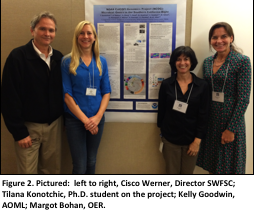
NOAA Corps
● A farewell send-off was held for LT Rachel Kotkowski on Thursday (Dec 11, 2014). She has completed her land assignment at AOML and will be next serving as Operations Officer on the R/V Gordon Gunter out of Pascagula, LA.
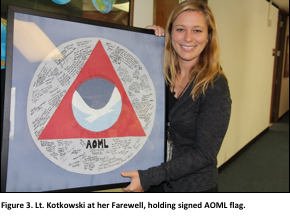
December 8, 2014
Ecosystem Assessment and Modeling
● Lindsey Visser, Lauren Valentino, and Dr. Chris Kelble participated in a cruise aboard the R/V Walton Smith last week (Dec. 1-5) focused on surveying water quality in south Florida's coastal waters. They collected samples for nutrients, chlorophyll a, and dissolved inorganic carbon. This was the first cruise to resume sampling water quality in south Florida coastal water after a two-year hiatus due to a lack of funding. These cruises have an additional focus on lower trophic level dynamics downstream from the Shark River on the southwest Florida shelf.
Environmental Microbiology
● Maribeth Gidley was an invited speaker at a Science Cafe on Dec. 10, 2014 at Vizcaya Museum and Gardens. The Science Cafe discussion concerned the impacts of Sea Level Rise and extreme weather events on individuals and communities; Dr. Gidley discussed the public health implications of these events.
Coral Health and Monitoring
● OCED researchers Ian Enochs and Derek Manzello had their abstracts accepted
for oral presentations at the 2015 ASLO Aquatic Sciences meeting in Granada, Spain to
be held in February. Manzello is also co-author on another oral presentation. All talks
listed below. OCED researchers in bold:
Enochs I, Manzello D, Johnston L, Price N, Donham E, Golodziej G, Clark S, Young C.
NATURALLY ACIDIFIED CORAL REEFS AT MAUG ATOLL: SIMILARITIES AND DIFFERENCES WITH OTHER
HIGH-CO2 SYSTEMS. Session #61, Global climate change: ocean acidification experiments
at CO2 vents.
Manzello D, Enochs I, Bruckner A, Renaud P, Kolodziej G, Carlton R, Glynn P.
GALÁPAGOS CORAL REEF PERSISTENCE AFTER ENSO WARMING ACROSS AN ACIDIFICATION GRADIENT.
Session #61, Global climate change: ocean acidification experiments at CO2 vents.
McGillis W, Langdon C, Martz T, Hsueh D, Loose B, Takeshita Y, Donham E, Price N, Smith J,
Manzello D. AN INNOVATIVE APPROACH TO ASSESSING CORAL REEF HEALTH AT SEVEN SITES AROUND
THE WORLD. Session #38, Advances in flux measurements in aquatic environments using the
eddy correlation technique.
The manuscript entitled "Galápagos Coral Reef Persistence after ENSO Warming Across an
Acidification Gradient" was accepted for publication in Geophysical Research Letters.
This paper shows that since the 1982-83 El Niño-Southern Oscillation warming event,
the persistence of reefs around the Galápagos Islands has differed across an acidification
gradient. Reefs disappeared where pH < 8.0 and aragonite saturation state (Ωarag)
≤ 3 and have not recovered, whereas one reef has persisted where pH > 8.0
and Ωarag > 3. These results provide field evidence that the ability of coral reefs
to persist with warming declines with acidification and this depressed resilience is
likely reduced further by high nutrients. Based on current CO2 emission trajectories,
the warming and acidification that eliminated coral reefs from the Galápagos Islands
will occur for nearly all reefs by mid-century.
Citation (OCED researchers in bold):
Manzello D, Enochs I, Bruckner A, Renaud P, Kolodziej G, Carlton R, Glynn P. Galápagos
Coral Reef Persistence after ENSO Warming Across an Acidification Gradient. Geophysical
Research Letters. In press.
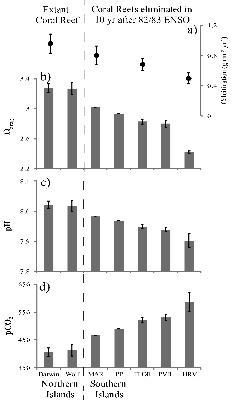
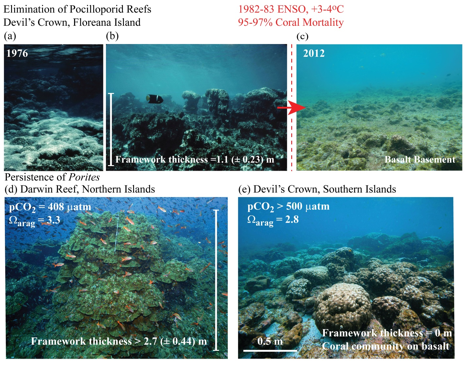
November 17, 2014
OCED Outreach
● Thomas Carsey presented the talk Just Beyond the Shore: Observations of Southeast Florida's Coastal Ocean at a meeting of the Key Biscayne Citizen Scientist Project, Key Biscayne, November 12, 2014.
November 10, 2014
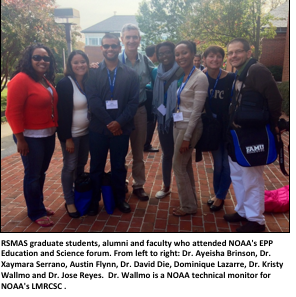
OCED Outreach
● Xaymara Serrano (OCED) presented her doctoral research at the 7th NOAA EPP Biennial Education and Science Forum, held at the University of Maryland Eastern Shore (UMES) from October 26-29. The goal of this forum was to showcase results of collaborative research and education projects between scientists and students at NOAA-EPP funded academic institutions and NOAA scientists, and to promote career opportunities for STEM graduates with academic, government and public/private sectors. Xaymara participated in this meeting along with a group of other graduate students and alumni whose graduate research was funded through NOAA's Living Marine Resources Cooperative Science Center (LMRCSC, www.umes.edu/lmrcsc).
Coral Health and Monitoring
● Lew Gramer attended a meeting last week in Honolulu on Coral Reef Resilience, sponsored by the NOAA Coral Reef Conservation Program. Resource managers from Great Barrier Reef Marine Park Authority, US Federal, State, and territorial agencies in the Pacific and the Caribbean joined researchers from NOAA (including OAR, NESDIS, and NMFS) and from the Universities of Hawaii, Miami, Queensland, Virgin Islands, and Plymouth (UK). The goals of the meeting were to share information on incorporating metrics for larval connectivity, stress disturbance exposure, and ecosystem diversity into resilience assessments of reefs, and on how to apply these metrics for more effective resource management in the face of future short-term and long-term environmental change.
November 3, 2014
OCED Outreach
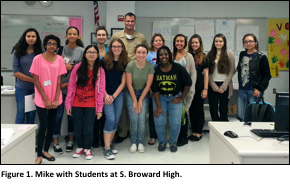 |
● LTJG Michael Doig and Erica Rule presented information about the NOAA Corps to students at South Broward High School on October 27 (Figure 1).
Coral Health and Monitoring
● Renee Carlton of OCED is participating in Living Oceans Foundation (LOF) Global Reef Expedition (GRE) to the Solomon Islands from October 27 to November 25, 2014 (Figure 2). Renee will collect seawater CO2 data and coral cores for calcification analysis as part of the ongoing collaboration between LOF and OCED to obtain baseline ocean acidification relevant data from remote coral reef locations across the Pacific Ocean. The Solomon Islands lie in the Coral Triangle, which is home to the greatest amount of marine biodiversity on the planet and is thus a priority area for marine conservation. There has been no ocean acidification research conducted in this vital region, making this a first-of-its-kind study. This is the 10th GRE cruise that OCED scientists have participated in since June 2012.
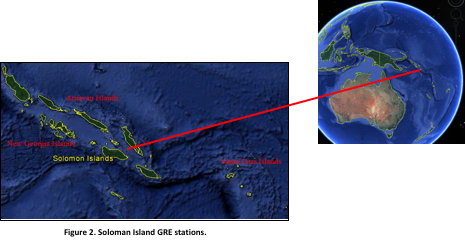 |
● Last week at Little Cayman Island in the Caribbean, the Central Caribbean Marine Institute (CCMI) finished redeploying their buoy, which is part of the Coral Reef Early Warning System (CREWS) Network. The buoy was first deployed in October of 2013 and needs to be returned to land each year for cleaning, repainting and instrumentation swap-out. The buoy was towed from its deployment site on October 14th and returned to position on October 29th. OCED's Mike Jankulak worked remotely with CCMI personnel to update the buoy's programming and develop procedures for instrument configuration. As of October 31st all data feeds from the buoy to AOML and NDBC had fully resumed. Data can be viewed at http://ecoforecast.coral.noaa.gov/index/0/LCIY2/station-home.
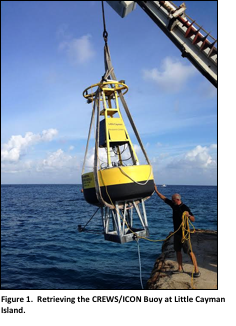 |
October 27, 2014
Coral Health and Monitoring
●Derek Manzello attended the workshop entitled Prioritizing Coral Restoration Sites hosted by Florida Fish and Wildlife at Nova SE University on October 22-23. This was the first of a 3-part workshop that will generate a spatially-explicit model to highlight the best locations for reef restoration based on both physical and biological factors.
●Renee Carlton, Graham Kolodziej, and Lauren Valentino traveled to the Cheeca Rocks NCRMP sentinel climate change and ocean acidification monitoring site where they collected zooxanthellae samples from 99 colonies of the ESA listed coral Oribicella faveolata over three fixed monitoring sites. Graham Kolodziej, Lauren Valentino, and NOAA Corp officer Mike Doig will return to Cheeca Rocks to collect 100 more samples from three different sites this week. OCED postdoc Dr. Paul Jones will work with Chris Sinigalliano to perform qPCR analysis to identify if certain zooxanthellae clades are associated with recovery of this critically endangered species. Carlton et al. also retrieved a temperature probe from Hens and Chickens Reef, downloaded the data and redeployed the unit. This site has the longest running temperature record for the Florida keys, extending back to 1975. This record was reestablished in Dec 2013 by OCED researchers as part of NCRMP. Research by OCED scientist Derek Manzello has elucidated a significant warming trend in this dataset. The 2014 warm-water bleaching event will be incorporated into this analysis to understand the significance of this recent thermal stress event over the past 40 years.
October 20, 2014
Environmental Microbiology
●The AOML microbiology team joined the FIU Southeast Environmental Research Center this past week to measure and document baseline nutrient and microbiological water quality conditions for a wide range of residential canals in the Florida Keys that are slated for either experimental remediation efforts or to be control canals for these remediation experiments. Chris Sinigalliano, Maribeth Gidley, and student intern Danny Morales spent the past week in the Florida Keys collecting and processing water samples from the experimental remediation and control canals, and will conduct microbial molecular source tracking analysis to establish baseline conditions and to document what improvements, if any, result from the canal water quality remediation efforts. It is hoped that these remediation efforts may led to more general improvement in the regional coastal water quality of the Florida Keys, and to improvement of community infrastructure resiliency in the face of anticipated impacts from climate change and sea level rise.
Coral Health and Monitoring
●The paper entitled Recent decade of growth and calcification of Orbicella faveolata in the Florida Keys: An Inshore-Offshore Comparison authored by OCED scientists Derek Manzello, Ian Enochs, Graham Kolodziej, and Renee Carlton was accepted for publication in Marine Ecology Progress Series. This study shows that calcification rates in this ESA-listed species were higher inshore vs. offshore over the past decade and also showed a marked resilience to both cold and warm-water stress. This fast growth inshore and high resilience to thermal stress is hypothesized to be one of the reasons for why the inshore patch reefs of the Florida Keys have maintained high coral cover relative to the reefs offshore.
October 14, 2014
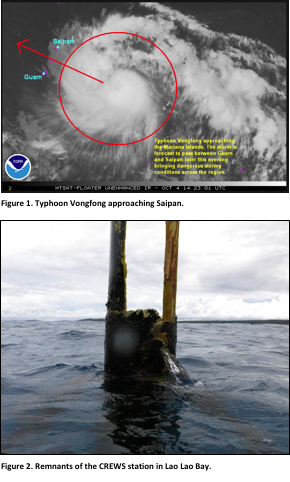
Coral Health and Monitoring
● The Lao Lao Bay station in Saipan has been destroyed by "super typhoon" Vongfong which passed within 50 nm of the station on October 5th at 18Z and was then estimated at 90 knots of intensity (Category 2) (Figure 1). The islands of Rota, Tinian and Saipan suffered some damage to structures and experienced intermittent power outages but they appear to have escaped anything worse and the Governor's declared state of emergency had been lifted. Vongfong underwent rapid intensification after leaving the CNMI and is estimated to have become the most intense tropical cyclone of 2014 (Category 5). The fiberglass tube snapped close to the waterline (Figure 2) and the upper half, about 20 feet of tube filled with positively buoyant polyurethane foam, has not been found. The station had been offline but locally storing data since July 31st, when its cellular account was terminated. All data produced since July are believed to be unrecoverable. The station had been problematic for quite some time, as it had been difficult getting support for maintenance of the station. See http://llbp7-log.blogspot.com/2014/10/saipan-crews-station-destroyed-during.html.
October 6, 2014
Coral Health and Monitoring
● Graham Kolodziej, Derek Manzello, and Lauren Valentino of OCED conducted coral reef CaCO3 budget surveys off of Miami-Dade and Broward counties on 29-30 Sept and 3 October with the assistance of NOAA Corps officers Mike Doig and Rachel Kotkowski. These surveys are part of the CRCP funded project Coral growth and reef framework persistence of the Florida Reef Tract with accelerating ocean acidification: The SEFCRI region.
Ecosystem Assessment and Modeling
●Geoffrey Cook from OCED and David Enfield and Chunzai Wang from PhOD are co-authors on a manuscript entitled Evidence of climate-driven ecosystem reorganization in the Gulf of Mexico that was submitted to the Proceedings of the National Academy of Science. The manuscript analyzes over 100 indicators in the Gulf of Mexico. The indicators were found to be influenced by two primary factors. The first was the implementation of fishing regulations in the 1970s; the second factor was the influence of the Atlantic Multi-Decadal Oscillation (AMO). The AMO was correlated with everything from the pressures being exerted on the ecosystem to the ecosystem state to the ecosystem services being produced by the ecosystem.
Environmental Microbiology
● Kelly Goodwin participated in the US-EU Marine Working Group on October 1, 2014, held at the French Embassy in Washington DC. The Working Group is comprised of the following sub-groups: Marine Microbial Ecology, Ocean Acidification/Stressors, Ocean Literacy, Ocean Observation Systems, and Aquaculture. These groups are working to implement the 2013 Galway Declaration which calls for collaborative international research on the coupled North Atlantic-Arctic system. Dr. Goodwin helped Gabrine Guiu, the EU co-chair of the Marine Microbial Ecology theme, present a summary of achievements, opportunities, and challenges facing coordinated EU-US marine microbial ecology research.
September 22, 2014
Environmental Microbiology
● Chris Sinigalliano and Maribeth Gidley were invited participants at a special public outreach and education presentation at Key Largo this past Friday, the first of the 2014-2015 "Ocean Life" series. Hosted by Florida International University's School of Environment, Arts and Society and the Friends of the Key Largo Cultural Center, the series features interdisciplinary experts from the region on marine topics that affect the Keys. The primary speaker at this first presentation of the season was Dr. Henry O. Briceño of the FIU Southeast Environmental Research Center on "Keys Canals: Your Backyard Swimming Pool ", which presented collaborative research by SERC and the AOML Microbiology Program on water quality issues in Florida Keys residential canals. This was followed by a public information question and answer session in which Drs. Gidley and Sinigalliano participated.
Coral Health and Monitoring
● Renee Carlton and Derek Manzello traveled to the Cheeca Rocks NOAA NCRMP sentinel climate and acidification monitoring site on 16-17 Sept 2014 where they worked with collaborator, Dr. Brooke Gintert of RSMAS/MGG, to document the ongoing Keys-wide coral bleaching event utilizing high-resolution landscape mosaic imagery. This will be a first of its kind dataset since no previous investigator has utilized this technique to document a coral bleaching event. Bleaching was severe at Cheeca Rocks (Fig. 1). The last major bleaching event to impact the Florida Keys was in 2005. Cheeca Rocks was studied by NCRMP collaborator, Dr. Marilyn Brandt of the University of the Virgin Islands, who upon seeing the recent pictures confirmed that this event was likely far more severe than 2005. Sea temperatures at nearby Molasses Reef were the hottest on record this summer, as well as this past winter (Fig. 2). Cheeca Rocks is one of the few sites that has been resilient to recent stress and maintained high coral cover. AOML coral scientists will be documenting the response of this coral reef to this thermal stress event.
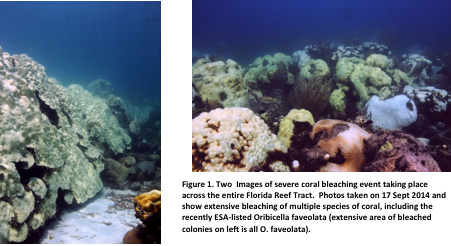
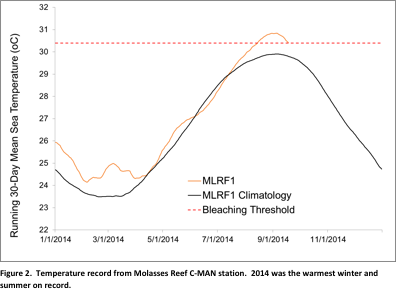
● During the last week in August and the first week in September, Xaymara Serrano also took note of some extensive bleaching in the Keys while collecting coral larvae for her research:
8/29- Emerald reef:
Siderastrea/Millepora/Palythoa - really bleached or dead
Agaricia - bleached
Orbicella faveolata/Montastraea cavernosa/Porites astreoides - ok, pale
9/2 Little Grecian Rocks:
Porites furcata - really bleached
Acropora palmata - partially bleached
Orbicella - pale
9/2 Horseshoe reef:
Agaricia/Millepora/Agaricia - really bleached
Siderastrea/Porites astreoides - some pale, some completely bleached
Orbicella - pale, some areas beginning to bleach
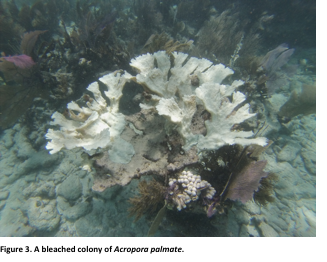
Ocean Carbon Cycle Group
● Betty Huss and Kevin Sullivan lead an effort to revamp the ocean carbon cycle group webpage. The concise, informative and visually appealing page of group activities and data holdings can be found at: /ocd/ocdweb/occ.html.
● The annual global carbon assessment by the global carbon program (GCP) was released yesterday. A world-wide-web highlight on the first utilization of data-based ocean estimates relying heavily on NOAA ship of opportunity CO2 data to determine flux variability is being created by Erica Rule and Monica Allen (OAR communications).
● Synopses of GCP:
The Global Carbon Project's report each year incorporates data from multiple research institutes around the
world on carbon dioxide emissions, carbon increase in the atmosphere, and land and ocean sinks for its annual
assessment of the Earth's carbon budget. The Global Carbon Budget 2014, led by Prof Le Quere, Director of the
Tyndall Centre at the University of East Anglia, with 59 co-authors from 10 countries and 49 institutions,
is published in the "living data" format to provide the highest transparency and traceability in the reporting
of this set of key indicators and drivers of climate change. Le Quere, C., Moriarty, R., Andrew, R.M., Peters, G.P.,
Ciais, P., Friedlingstein, P., Jones, S.D., Sitch, S., Tans, P., Arneth, A., Boden, T.A., Bopp, L., Bozec, Y.,
Canadell, J.G., Chevallier, F., Cosca, C.E., Harris, I., Hoppema, M., Houghton, R.A., House, J.I., Jain, A.,
Johannessen, T., Kato, E., Keeling, R.F., Kitidis, V., Klein Goldewijk, K., Koven, C., Landa, C.S., Landschutzer, P.,
Lenton, A., Lima, I.D., Marland, G., Mathis, J.T., Metzl, N., Nojiri, Y., Olsen, A., Ono, T., Peters, W., Pfeil, B.,
Poulter, B., Raupach, M.R., Regnier, P., Rödenbeck, C., Saito, S., Salisbury, J.E., Schuster, U., Schwinger, J.,
Seferian, R., Segschneider, J., Steinhoff, T., Stocker, B.D., Sutton, A.J., Takahashi, T., Tilbrook, B.,
van der Werf, G.R., Viovy, N., Wang, Y.P., Wanninkhof, R., Wiltshire, A., Zeng, N., 2014. Global carbon budget 2014.
Earth Syst. Sci. Data Discuss. 7, 521-610.
Florida Area Coastal Environment
● The FACE team completed their Numeric Nutrient Study cruise for September on the 22nd and 23rd. On board the R/V Hildebrand were Tom Carsey, Maribeth Gidley, Jack Stamates, Joe Bishop, Michael Doig, Rachel Kotkowski, and Lauren Valentino. Day 1 was calm and perfect; day 2 saw plenty of rain and windy weather. A waterspout was seen, as well as a sea turtle of unknown species. In addition to water quality samples, samples for microbiology and dissolved organic carbon were obtained at coral reef sites, inlets, outfalls, and background sites off of Miami-Dade and Broward counties.
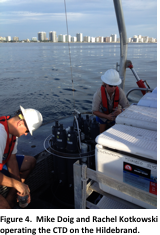
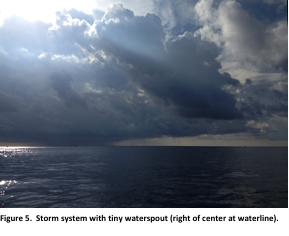
September 15, 2014
Environmental Microbiology
● Chris Sinigalliano, Maribeth Gidley, and student intern Daniel Morales represented AOML microbiology research during a special session of Microbiology in the Coastal Zone at the 2014 Southeastern Microbiology Summit, a joint meeting of the Southeastern Branch and the Florida Branch of the American Society for Microbiology, on Sept 5-7, at Ponte Vedra, Florida. Chris Sinigalliano was an invited speaker giving an oral presentation on Urban Coastal Oceanography and NOAA Investigations of Microbial Water Quality Impacts from Coastal Inlets and Treated Wastewater Outfalls in the Southeast Florida Region. Daniel Morales presented a research poster covering summer research by AOML interns entitled Seaweed Wrack as a Potential Environmental Reservoir for Fecal Bacteria at South Florida Recreational Beaches.
● Chris Sinigalliano participated in a special training workshop on Environmental Microbial Genomics and Metagenomics in Walnut Creek, California Sept 7-12, hosted by the US Department of Energy's Joint Genome Institute.
Ocean Acidification
● Ruben van Hooidonk attended a meeting entitled Using Spatial Data and Analysis to Understand the Human Impacts of Ocean Acidification, along with Linwood Pendleton, Lisa Suatoni, Julie Ekstrom, Libby Jewett, Dwight Gledhill, Sarah Cooly, Chris Langdon, at the National Socio-Environmental Synthesis Center (SESYNC) in Annapolis, Maryland, September 9-10, 2014. Using projections of ocean acidification that he and Derek Manzello published (van Hooidonk, et al. 2014), several studies have been conducted to assess the risk and impact of ocean acidification on humans. These studies focussed on the impacts of ocean acidification on commercially important mollusks, fisheries and coastal protection by coral reefs, and should be submitted for publication in the near future.
September 2, 2014
● Renee Carlton, Graham Koldziej, and Derek Manzello installed temperature sensors at four coral reef locations at Biscayne National Park and at the Fowey Rocks lighthouse on 29-Aug-2014. These thermistors will provide in situ temperatures as part of the climate monitoring of the National Coral Reef Monitoring Program (NCRMP) of the Coral Reef Conservation Program (CRCP). During the surveys, extensive coral reef bleaching was observed at all the sites (see Fig. 1 and 2). The bleaching thresholds that were estimated and published for the Florida Reef Tract were exceeded in the past few weeks at Fowey Rocks and Molasses Reef (Fig. 3), thus the bleaching was expected. Sea temperatures at Molasses Reef C-MAN station are currently the warmest that they've ever been since the station's inception in 1988.


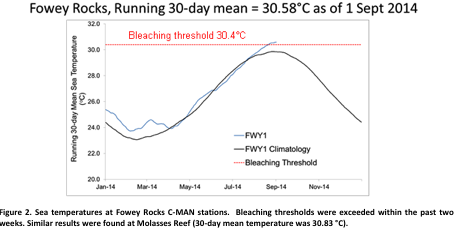
August 18, 2014
Coral Health and Monitoring
● The paper entitled Geographic differences in vertical connectivity in the Caribbean coral Montastraea cavernosa despite high levels of horizontal connectivity at shallow depths by X. Serrano, I. B. Baums, K. O'Reilly, T. B. Smith, R. J. Jones, T. L. Shearer, F. L. D. Nunes and A. C. Baker was published in the Journal of Molecular Ecology. In this study, the authors assessed vertical connectivity in 583 coral colonies of M. cavernosa collected from three depth zones (≤10, 15-20 and ≥25 m) at sites in Florida (within the Upper Keys, Lower Keys and Dry Tortugas), Bermuda and the U.S. Virgin Islands. Overall, this is the first work to demonstrate significant genetic differentiation by depth for coral populations in Florida.
August 11, 2014
● Undergraduate Hollings Scholar Daniel Coleman of Tulane University participated in research with mentor Lew Gramer, on periodic summer upwelling events in the northern portion of the Florida reef tract from May through July. Dan and Lew's poster entitled Summer cold-water anomalies on the Florida Reef Tract: Ecologically significant upwelling was presented by Dan at the 2014 NOAA Office of Education's Science and Education Symposium. The poster won the prize for "Best Poster of Session", (along with a $250 cash prize!) and the results of the work are likely to become part of an upcoming manuscript submitted for peer review this Fall.
Ocean Carbon Cycle
● The following paper was published: Rodgers, K.B., Aumont, O., Mikaloff Fletcher, S.E., Plancherel, Y., Bopp, L., de Boyer Montegut, C., Ludicone, D., Keeling, R.F., Madec, G., Wanninkhof, R., 2014. Strong sensitivity of Southern Ocean carbon uptake and nutrient cycling to wind stirring. Biogeosciences 11, 4077-4098.
● The following paper was resubmitted to the Journal of Geophysical Research - Oceans: Kristene McTaggart and Rik Wanninkhof, Antarctic Bottom Water Temperature Changes in the Western South Atlantic from 1989-2014.
● The following white paper was published and received recognition from the CPO/COD program manager, David Legler and Acting OAR director, Craig McLean: Feely, R. A., L. D. Talley, J. L. Bullister, C. A. Carlson, S. C. Doney, R. A. Fine, E. Firing, N. Gruber, D. A. Hansell, G. C. Johnson, R. M. Key, C. Langdon, A. Macdonald, J. T. Mathis, S. Mecking, F. J. Millero, C. W. Mordy, C. L. Sabine, W. M. Smethie, J. H. Swift, A. M. Thurnherr, R. H. Wanninkhof, M. J. Warner (2014): The US Repeat Hydrography CO2/Tracer Program (GO-SHIP): Accomplishments from the first decadal survey. A US CLIVAR and OCB Report, 2014-5, US CLIVAR Project Office, 47 pp. Comments from Craig McLean (US Head of Delegation to the IOC/UNESCO and Assistant Administrator for Research, NOAA): Congratulations to all authors and contributors to this remarkable work. As I represent the US at the Intergovernmental Oceanographic Commission (IOC), I find this global program a remarkable demonstration of coordination and alignment across governments and science institutions. As a NOAA person I am grateful to all collaborators and participants from across all organizations. This is a fine document, easy to read for persons beyond the science community and will bring valuable understanding to the policy community as well. Congratulations to all -- those who stood on deck, worked the samples, analyzed the data, and generated the report.
● Robert Castle met the NOAA ship RONALD H. BROWN in Newport, Oregon to reinstall the pCO2 underway system on the ship.
Ecosystem Assessment and Modeling
● Chris Kelble, chair of the NOAA IEA stering committee, attended the 2014 NOAA IEA Face to Face Meeting and ensuing IEA Steering Committee Meeting on August 5-8 at ESRL in Boulder, Colorado.
Coral Health and Monitoring
● Xaymara Serrano will be in Key Largo from August 8 to September 19 assisting during coral spawning (for the species Acropora cervicornis and Orbicella faveolata) and conducting experiments with newly settled recruits. This work will be done in conjunction with Dr. Margaret Miller from NMFS. The project is designed to assess the effects of increased nutrients and thermal stress on corals during the early life stages.
August 4, 2014
● Derek Manzello won 2nd place in the "Living Seas" category of the 2014 OAR Photo Contest with his photograph of a clownfish in Fiji (Figure 1). The winning photographs are shown in the OAR Weekly Update August 1, 2014.
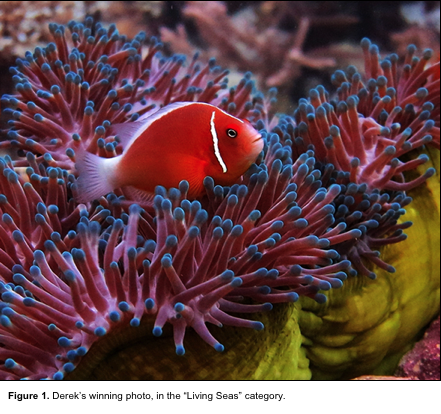
July 28, 2014
● Pamela Fletcher completed her doctoral degree last week with participation from committee member James Hendee. Her thesis research included results from several NOAA funded projects including the Marine and Estuarine Goal Setting for South Florida project (http://sofla-mares.org/) and the coral reef and marine resource managers climate information needs assessment project. Pamela received her degree from the University of Florida's Soil and Water Science Department and the title of her thesis is Using participatory decision support to improve coral reef management.
Coral Health and Monitoring
● Renee Carlton, Mike Jankulak, Graham Kolodziej, and Derek Manzello traveled to the Florida Keys to conduct field work on July 21-23. They conducted calcium carbonate budget surveys at the Cheeca Rocks NCRMP class III climate and acidification sentinel site, as well as collected coral cores for growth measurements. Additionally, they downloaded pH data from the Cheeca Rocks acidification buoy to ensure the sensor is working properly.
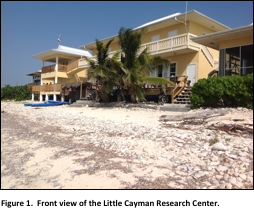
● Jim Hendee and Karsten Shein (NCDC) participated as mentors in the NSF-funded Research Experience for Undergraduates (REU) program at Little Cayman Research Center (LCRC) July 21 - 26, 2014. Jim spoke of the CREWS Network, the CREWS station at LCRC, how ecological forecasting works, and a bit on the newly proposed (by Kelly Goodwin and Chris Sinigalliano) Coral Microbiome Observing Network (CMON) and about Genomic Observatories (GO). The Director of LCRC, Dr. Carrie Manfrino, is seeking to re-write the LCRC/AOML MOU that has existed in the past for work with the CREWS station to now include AOML/OCED participation in the REU project for next year's students, as well as the proposed CMON/GO project. Other projects may also be included so that AOML has a broad collaboration with LCRC in the future.
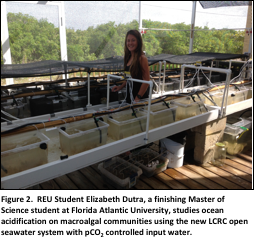 |
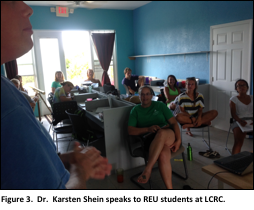 |
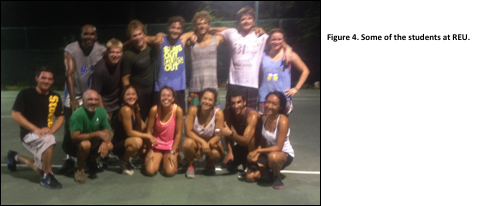
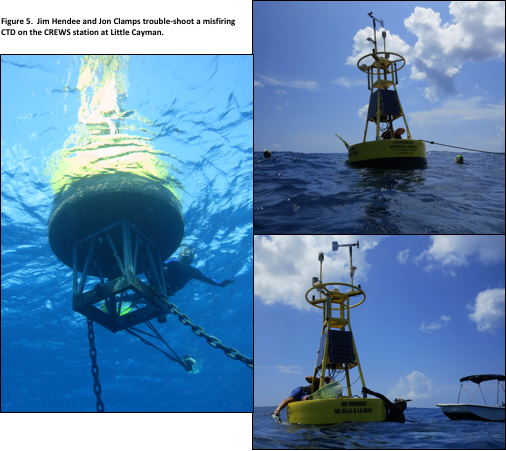
July 21, 2014
Ecosystem Assessment and Modeling
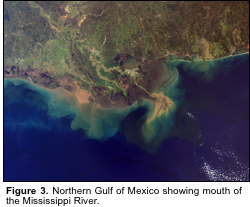
● Rik Wanninkhof and Chris Kelble attended the 5th Annual NOAA/NGI Gulf Hypoxia Research Coordination Workshop July 14-16 at the Stennis Space Center (Mississippi). The workshop was designed to advance fisheries ecosystem management in the northern Gulf to inform efforts to assess and predict the potential ecological and socioeconomic effects of diversions and hypoxia. The workshop was designed to 1) provide a forum for strengthening communication and coordination between physical, biological, and socio-economic modelers of Gulf of Mexico hypoxia and Mississippi River diversions, and the users and stakeholders (e.g. Hypoxia Task Force, fisheries managers); 2) validate and refine key fisheries management and habitat conservation needs associated with ecosystem (including socioeconomic) effects of hypoxia and large-scale river diversions in the Gulf of Mexico; and 3) assess adaptive management needs for advancing ecosystem modeling of hypoxia and diversion effects on habitats and living resources in the northern Gulf of Mexico (Figure 1).
● A special volume of Ecological Indicators on Tools to Support Ecosystem Based Management of South Florida's Coastal Resources should be released this week. Chris Kelble is the managing guest editor for this special issue with Peter Ortner and Joseph Boyer also serving as guest editors. Most of the articles in the special volume present results from the Marine and Estuarine Goal Setting for South Florida (MARES) project. MARES had a number of OCED scientists serve as leaders, PIs, and participants, including Chris Kelble, Pamela Fletcher, Geoffrey Cook, Thomas Carsey, Jack Stamates, Jim Hendee, Chris Sinigalliano, Maribeth Gidley, and Michelle Wood. The special volume has the following five articles authored by OCED scientists:
1. The manuscript Using the Integrated Ecosystem Assessment Framework to Build Consensus and Transfer Information to Managers by Pamela Fletcher (SeaGrant/OCEd), Chris Kelble (OCED), William Nuttle, and Gregory Kiker was published in Ecological Indicators. The manuscript investigates how portions of the IEA framework were applied to build consensus on the focal ecosystem components and processes that are characteristic of a sustainable South Florida coastal ecosystem that is producing ecosystem services at the level society desires. Resource managers, researchers, academics, and non-governmental organizations participated in facilitated meetings and contributed to the synthesis of science and a myriad of science communications to transfer information to decision makers and the public. A proof of concept Bayesian Belief Network was developed to explore integrating the results of this assessment into an interactive management scenario evaluation tool. The four-year effort resulted in the development of a research and management coordination network in South Florida that should provide the foundation for implementing ecosystem-based resource management across multiple agencies (Figure 1).
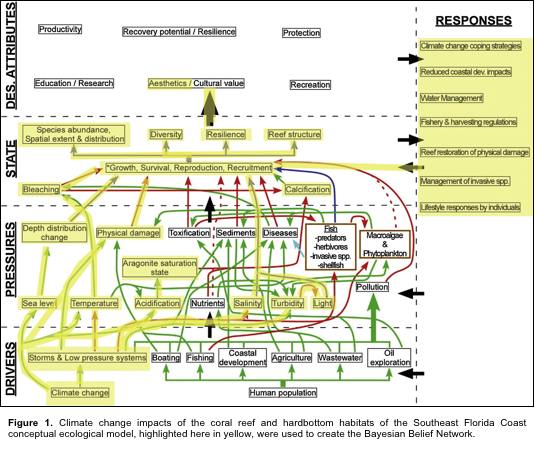
2. The manuscript entitled Towards Marine Ecosystem Based Management in South Florida: Investigating the Connections among Ecosystem Pressures, States, and Services in a Complex Coastal System authored by AOML/CIMAS researchers Geoff Cook, Chris Kelble, and Pamela Fletcher was published in Ecological Indicators. Building upon the integrated conceptual ecosystem models developed during the MARES project, the manuscript explores the relative impact of 12 ecosystem pressures on 11 ecosystem states and 11 ecosystem services in coastal South Florida. The most pervasive pressures were Freshwater Delivery, Temperature Effects of Climate Change, and Impacts of Climate Change on Weather. The most at risk ecosystem states, as determined by cumulative impacts, were Protected Species, Fish and Shellfish, and Coral and Hardbottom Habitats. Similarly, the most at risk ecosystem services are Existence of Natural System, Pristine Wilderness Experience, and Non-extractive Recreation Opportunities (Figure 2). Through this exploration of the interaction among various ecosystem pressures, states, and ecosystem services, an understanding of how ecosystem services are impacted by multiple interacting pressures is derived. In so doing, a tool for resource managers to understand trade-offs and the possible impact on the production of ecosystem services that may occur when considering alternative management strategies is provided.
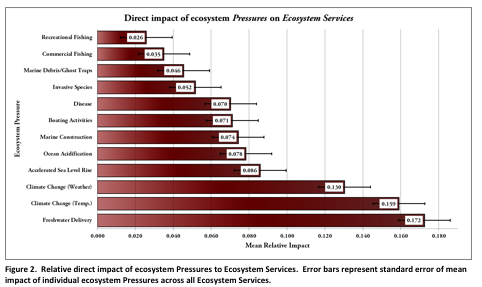
3. The manuscript Developing Integrated Ecosystem Indices by David Loomis, Peter B. Ortner, Chris Kelble, and Shona Paterson was published in Ecological Indicators. This manuscript investigates the need to develop consistent indicators for both the biophysical and social sciences. This consistency is necessary to allow integration between these indicators and quantify trade-offs among ecosystem services and ecosystem health. To accomplish this integration, the manuscript employs a "recursive relationship" approach that defines (and redefines) variables, indicators, and indices along a sliding hierarchy from measurable parameters to highly aggregated indices (Figure 3).

4. Two manuscripts detailing the selection and justification of waterbird indicators were co-authored by Pamela Fletcher and were published in Ecological Indicators. The first of these manuscripts developed a suite of conceptual models to investigate the niche of different waterbirds and select those that would make appropriate indicators. The second manuscript quantitatively scores the proposed indicators against a suite of pre-defined indicator criteria to justify their selection and proposes appropriate metrics to evaluate the waterbird indicators.
Environmental Microbiology
● Kelly Goodwin kicked off an intensive summer field campaign that will apply NOAA-developed Molecular Source Tracking (MST) markers to beaches in the vicinity of Los Angeles. In addition to MST, the project utilizes traditional and rapid detection of fecal indicator bacteria (FIB) and pathogen analysis in order to evaluate the risks posed by degraded water quality and the efficacy of remediation strategies. The work is part of a Cooperative Research and Development Agreement (CRADA) to support technology transfer.
Nutrients
● The paper entitled Carbon dynamics of Florida Bay: spatiotemporal patterns and biological control by Jia-Zhong Zhang and Charles Fischer was accepted for publication in Environmental Science and Technology. In this study, it was revealed that there are distinct CO2 source and sink regions in the bay and the seasonal variation of the CO2 sink was caused by cyanobacteria bloom. Based on the analysis of multi-year data, this paper provided the first estimate of ocean acidification trends and the annual CO2 fluxes to atmosphere from the bay in 2006-2012.
July 14, 2014
World Ocean Assessment
● Kelly Goodwin, Chris Kelble, and Rik Wanninkhof have been named official U.S. Government lead reviewers of chapters of the first World Ocean Assessment (WOA, www.worldoceanassessment.org), while Jim Hendee, Greg Foltz, Rick Lumpkin, olly Baringer and Gustavo Goni will act as science reviewers of select chapters. This is the first WOA, comprised of 57 chapters, designed to document trends in the state of the marine environment (including socioeconomic aspects). Subsequent WOAs will be generated every five years. The aim of the review process is to ensure technical and policy reviews of the WOA chapters, integrate these reviews with the public reviews received in response to a Federal Register Notice, and write and submit the integrated USG review to the UN Secretariat.
Coastal Oceanography
● Summer AOML student interns Danny Morales and Mishelle Rodriguez joined environmental public health physician Maribeth Gidley, and the crew (Joseph Bishop, LTJG Michael Doig, and Charles Featherstone) of NOAA's research vessel, R/V HILDEBRAND, to help collect water quality samples during this week's FACE-NNCS cruise. Samples collected will be analyzed for nutrients, microbial contaminants and source tracking markers of both coral and human health concern, and samples will be prepared for next-generation-sequencing and microbial community genomic analysis (as part of a NOAA Coral Reef Conservation Program project).
Ecosystem Assessment and Modeling
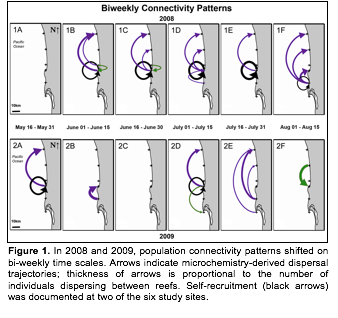
● The manuscript Population connectivity shifts at high frequency within an open-coast marine protected area network authored by AOML/CIMAS researcher Geoff Cook, and Ed Parnell and Lisa Levin of Scripps Institution of Oceanography was accepted for publication in PLoS ONE. Combining otolith microchemistry with ADCP-derived simulation modeling, the authors reconstructed the population connectivity (via larval dispersal) patterns of damselfish inhabiting a marine protected area (MPA) network along the southern California coastline (Figure 1). For over two years, the study documented self-recruitment at two of six study reefs, one of which is a no-take MPA. On biweekly time scales, we observed directional variability in alongshore current data and saw concomitant shifts in microchemistry-derived larval dispersal trajectories and reef connectivity patterns. As one of the few empirical studies of population connectivity within an open coast MPA network, this work can inform the MPA design process, implementation of ecosystem based management plans, and facilitate conservation decisions.
● The manuscript Quantifying Florida Bay habitat suitability for fishes and invertebrates under climate change scenarios authored by AOML/CIMAS researcher Kelly Kearney, and Mark Butler (Old Dominion University), Robert Glazer (Florida Fish and Wildlife Commission), Christopher Kelble (AOML/OCED), Joe Serafy (NOAA/SEFSC), and Erik Stabenau (National Parks Service) was accepted for publication in Environmental Management. This study uses a combination of hydrological and ecological models to investigate how the suitability of habitat will change in Florida Bay for three key fishery species (Spotted Seatrout, Grey Snapper, and Spiny Lobster) and four common prey species (Mojarra, Rainwater Killifish, Goldspotted Killifish, and Pinfish) under a variety of climate change scenarios. The scenarios investigated included changes in sea level, temperature, rainfall, runoff, and evaporation. Changes in habitat suitability varied in both magnitude and direction across both scenarios and species, but were on average small; suggesting that the estuarine fauna of Florida Bay may not be that vulnerable to climate change (Figure 2).
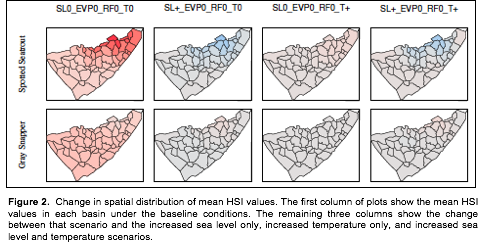
Environmental Microbiology
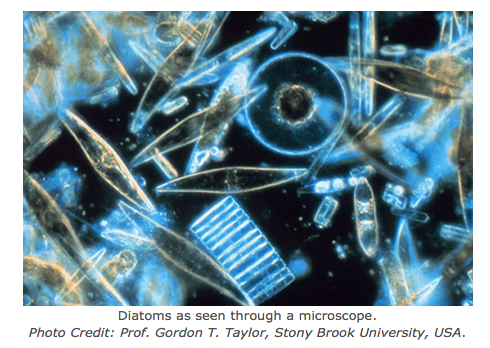
● OCED scientists and summer students participated in the Ocean Sampling Day on June 21, the first global simultaneous sampling for microbes in ocean, coastal and Great Lakes waters. Over time, sampling will support international and NOAA missions to provide a snapshot of the diversity of microbes, their functions, and their potential economic benefits. Among other economic applications, microbes have been used for novel medicines, as biofuels, and to consume spilled oil. Organized and led by the European Union's MicroB3 organization, NOAA coordinated twelve sampling sites for Ocean Sampling Day 2014 within U.S. coastal waters. View images of the sample collection process in the following AOML photo gallery.
July 7, 2014
Corals
● The Coastal-Marine Automated Network (C-MAN) stations at Sand Key (SANF1) and Pulaski Shoal (PLSF1) were replaced by National Data Buoy Center technicians recently, after extensive outages. With the Long Key (LONF1) and Sombrero Key Light (SMKF1) stations repaired earlier this spring, we now have all five Florida Keys C-MAN stations operational for the first time in a few years. Meteorological sensors are operating for wind speed/direction, air temperature, and pressure at all stations. Dew point temperature and heat index are available for the Long Key and Sombrero Key Light stations, and sea surface temperature is available for the Long Key and Molasses Reef stations. Unfortunately, the ICON station at LaoLao Bay, Saipan, will soon terminate operations due to lack of funds and local maintenance work.
● NSU's Oceanographic Center will be hosting the free Dive In Summer Film Series and presenting
the Changing Seas episode entitled Galápagos: Windows into the Future, which featured OCED's Derek Manzello.
The film will commence at 6pm on Wednesday, July 9 and will be followed by a panel discussion featuring
Dr. Manzello and other Galapagos experts. These screenings are free, but space is limited; anyone interested
in attending MUST register in advance at Lcorinne@nova.edu or by calling 954-262-3678. The Changing Seas
episode originally aired on local PBS stations on June 25 and can be viewed here:
Environmental Microbiology
● The microbiology team will be conducting a 3-day survey of microbial contamination at recreational beaches throughout the Florida Keys National Marine Sanctuary this week. As part of their summer student intern projects, they will be measuring fecal indicator bacteria, microbial source tracking markers, pathogens, and other microbial contaminants in the sand, seaweed wrack, and near-shore waters of beaches from Key Largo to Key West, basing their field operations out of the Keys Marine Laboratory at Long Key, Florida. Participating are Maribeth Gidley and Chris Sinigalliano, and summer student interns Alejandro de la Cova, Trina Malone, Danny Morales, Mishelle Rodriguez and Camilla Mirow. They will be conducting beach sampling out of the KML facility from July 9 through July 12.